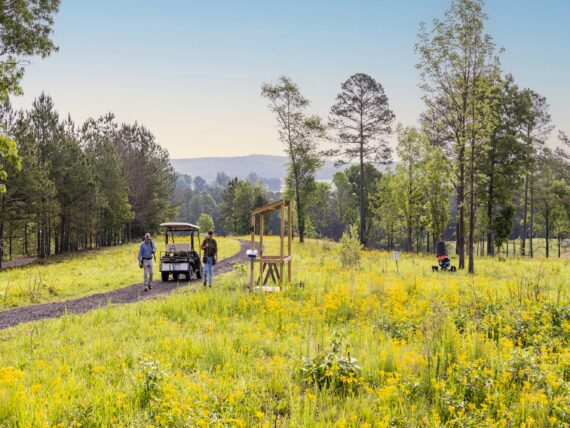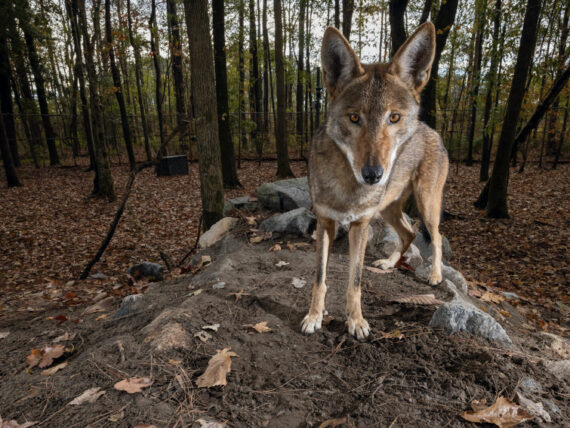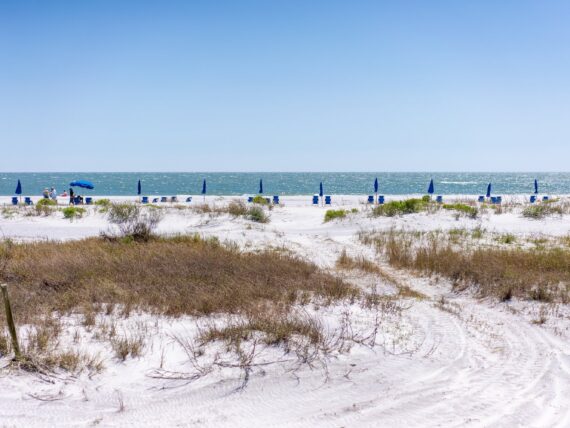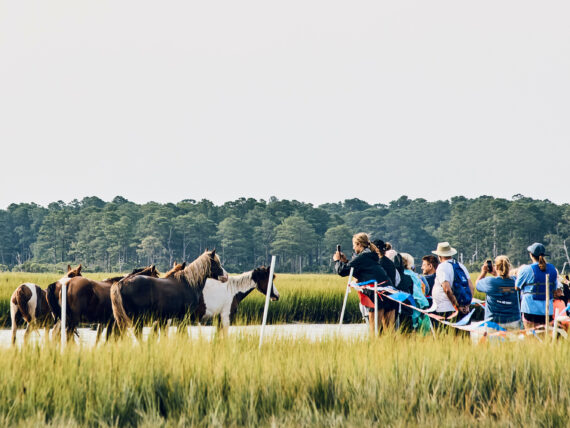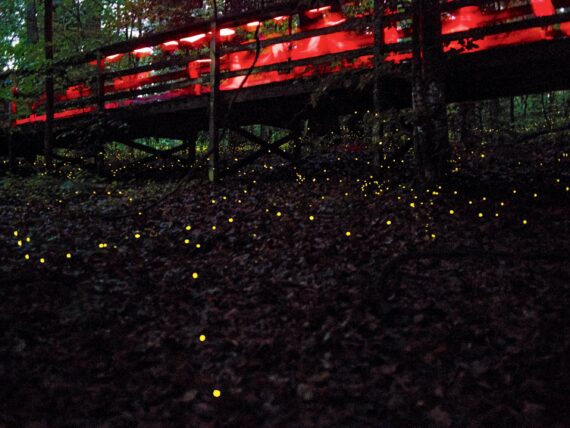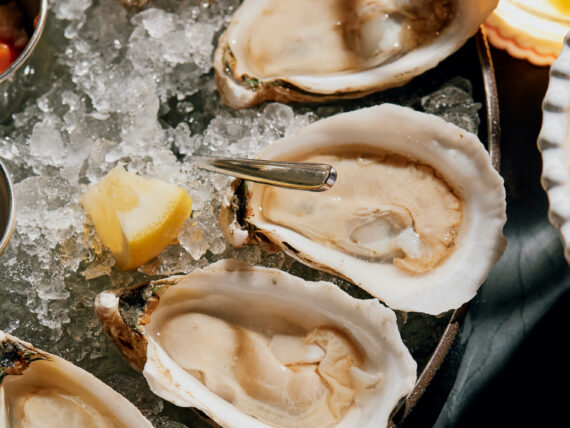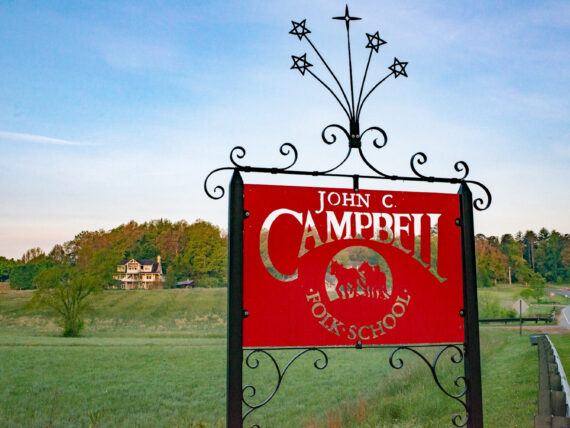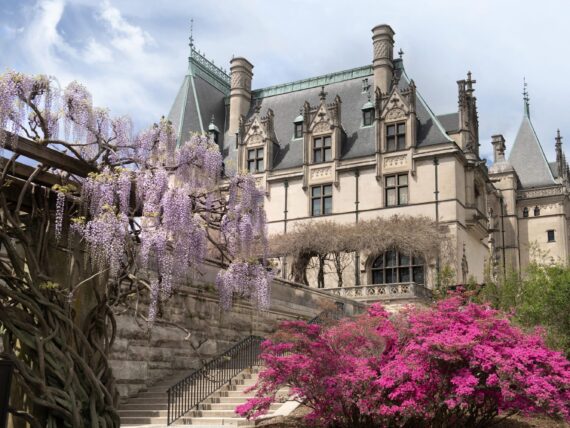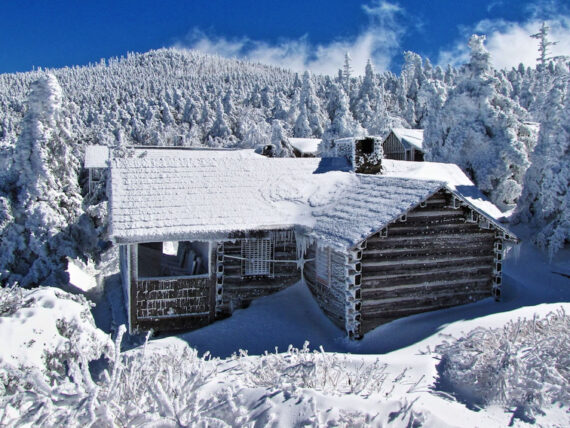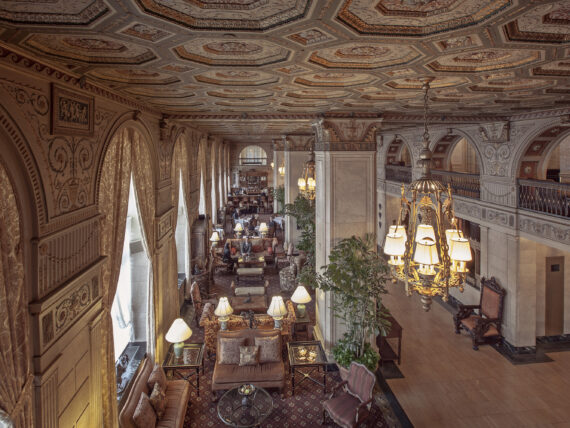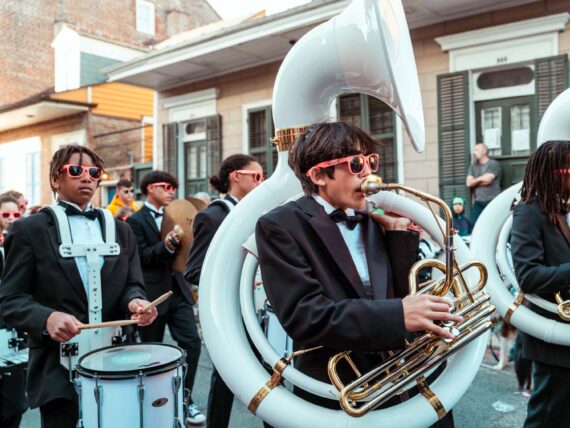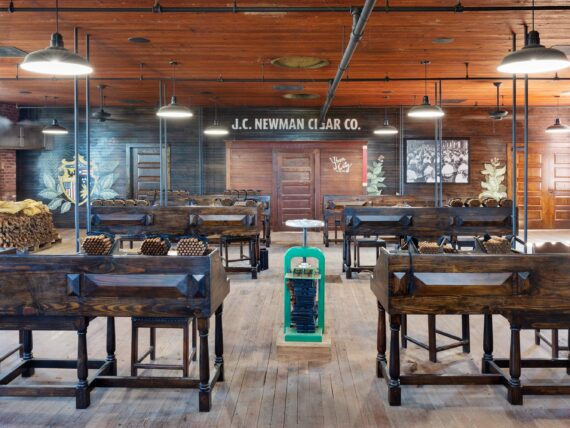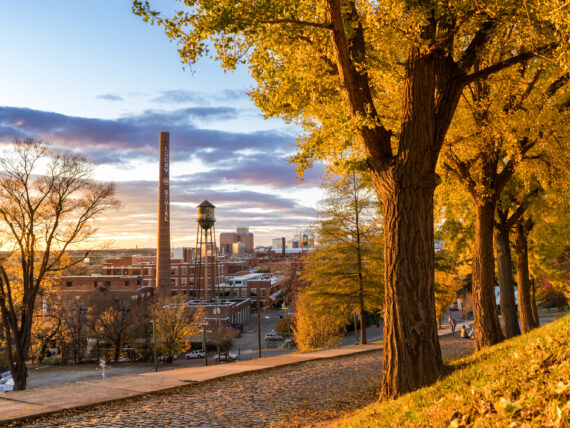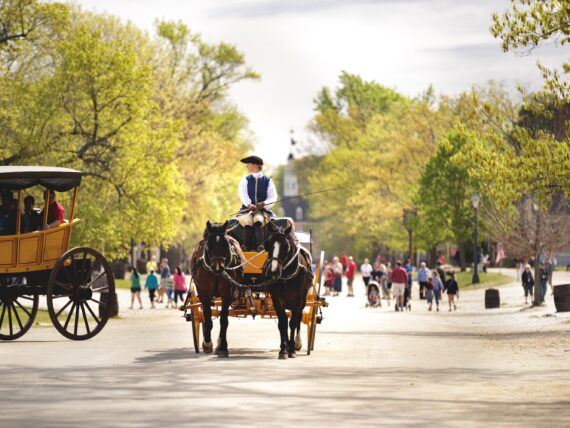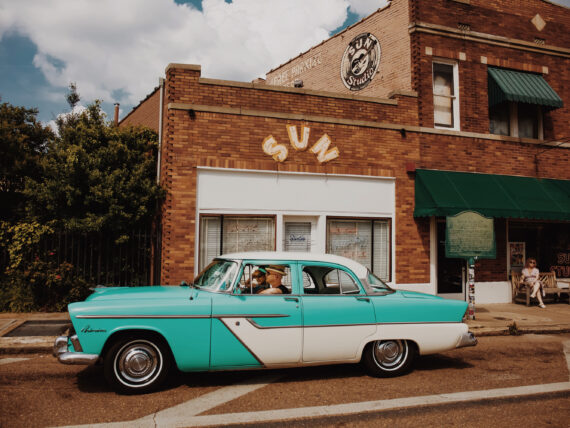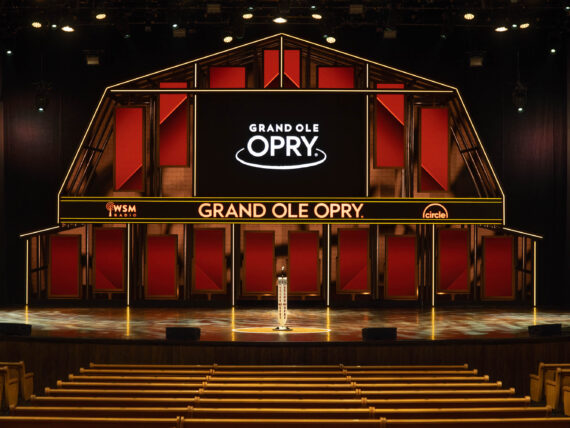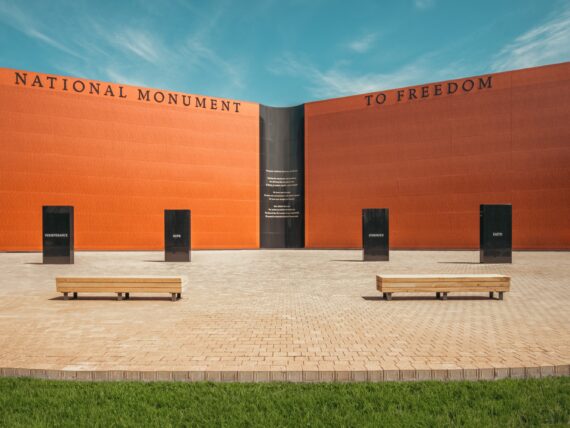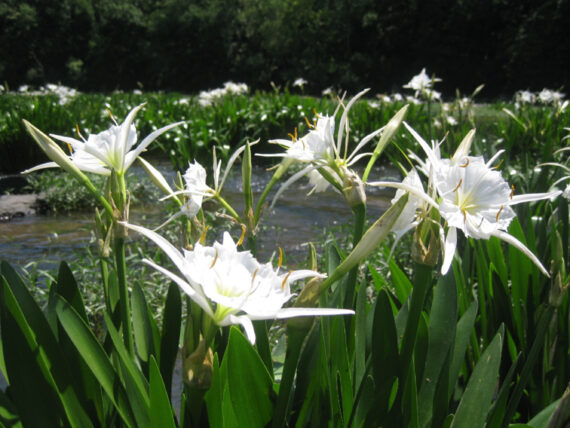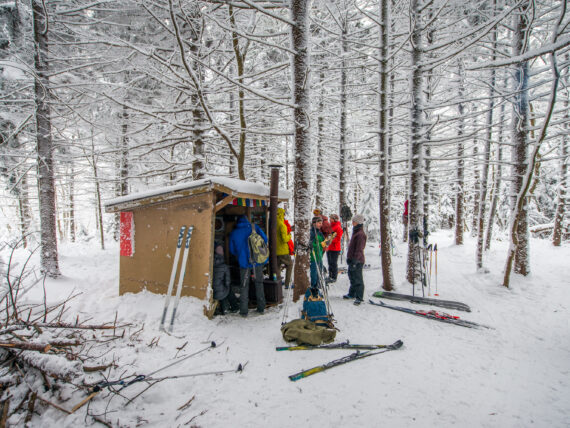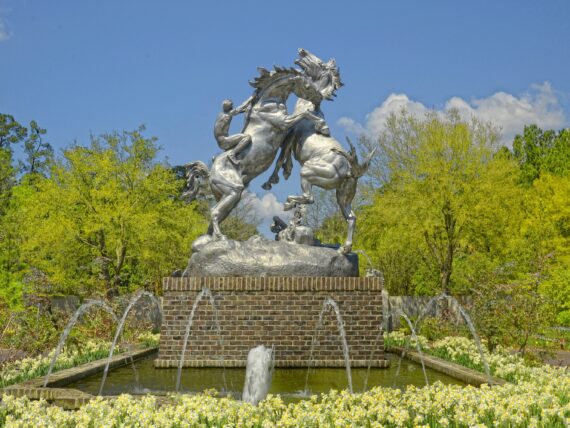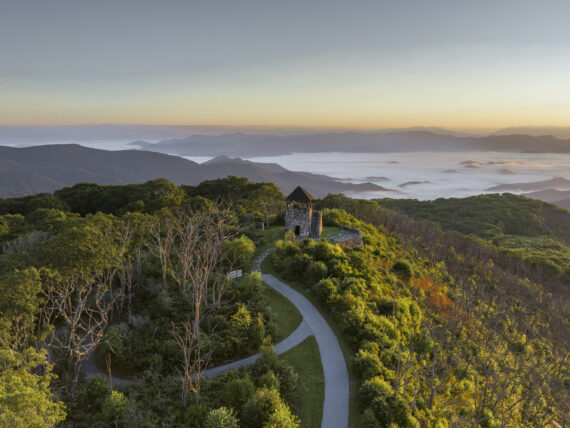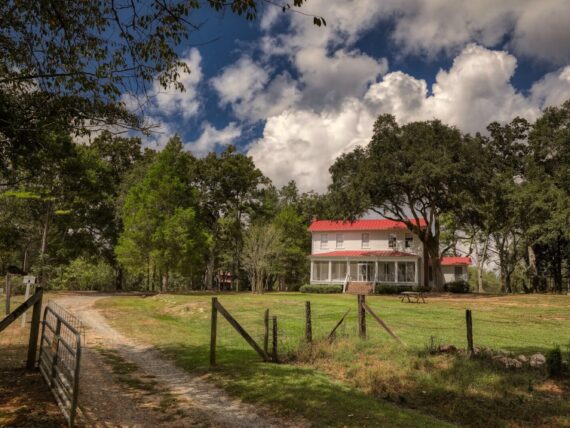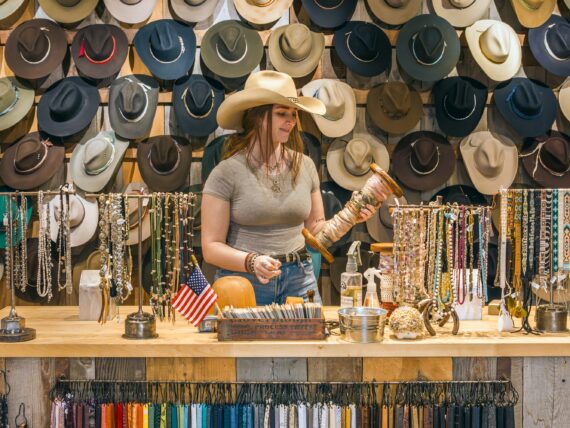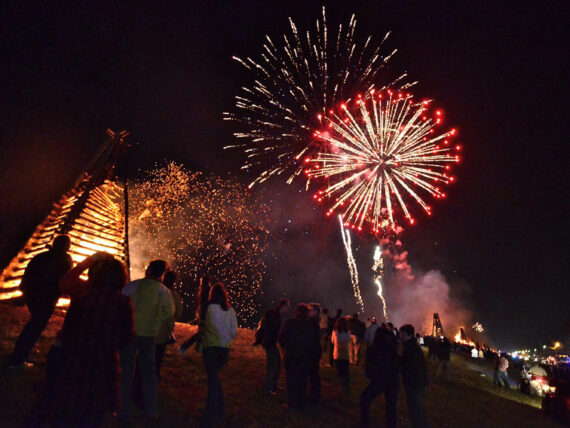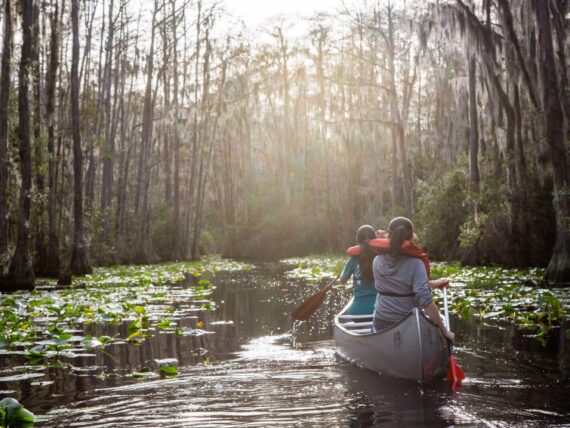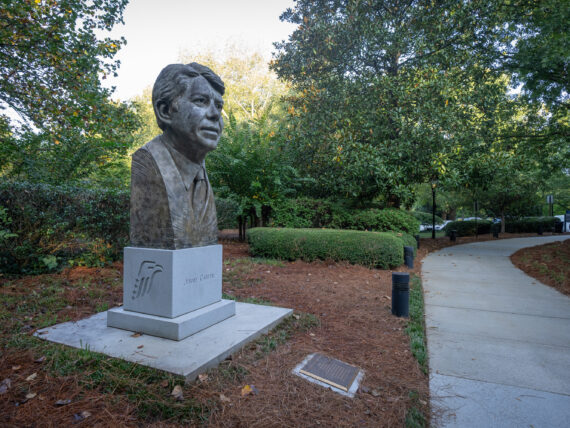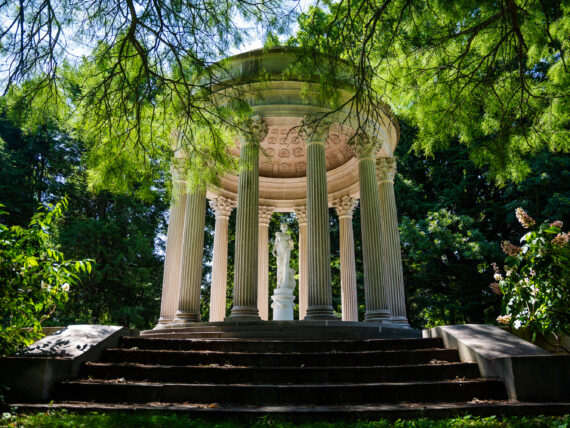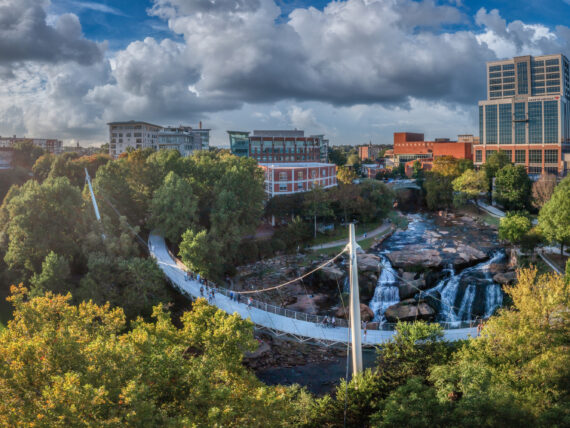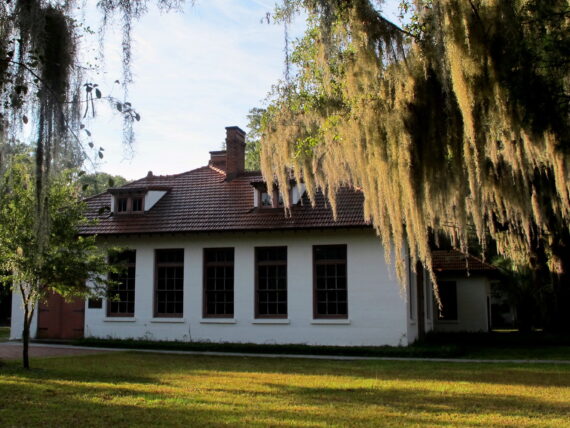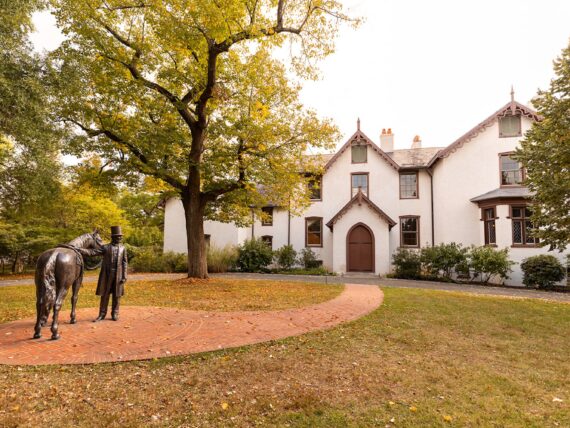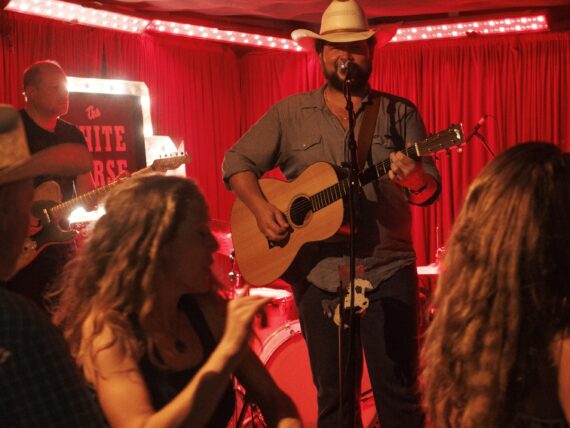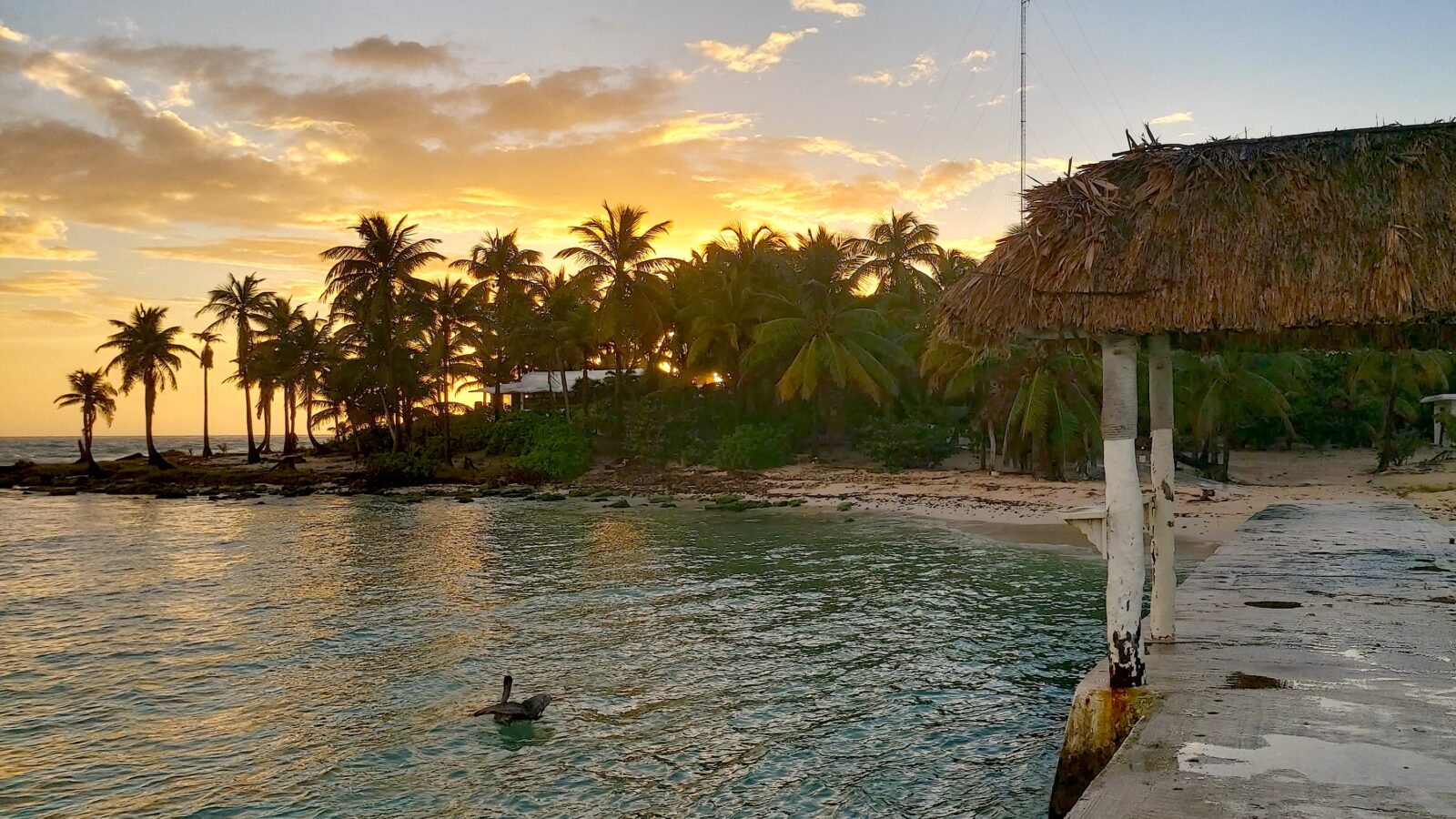
Photo: Courtesy of Casa Blanca
Sunset over the beach at Casa Blanca.
At sister lodges with serious sustainability cred
Where: Punta Pájaros, Mexico
When: year-round
If you like: conservation, the sporting life, the outdoors and sports
Why you should go: Casa Blanca and Playa Blanca are sister lodges going all in on environmental initiatives in 2025. These are the only Yucatán Peninsula lodges on a twenty-five-mile-long private island called Punta Pájaros, which lies between the renowned Ascension Bay and Espiritu Santo Bay in the heart of the Sian Ka’an Biosphere Reserve. Work has already started to decommission diesel generators and convert the island to solar power, and the lodges have recently inked an agreement with Bonefish & Tarpon Trust to partner on conservation efforts around some of the region’s famed fishing targets. The lodges are also remodeling a building to use as a field laboratory, office, and housing for scientists working in the area, and later, guides will tag caught bonefish and issue permits for research projects designed to shed light on spawning movements in and out of the biosphere reserve. “We don’t want to be hangers-on when it comes to sustainability,” says Juan Carlos Rodríguez Bush, fly-fishing manager for the two lodges. “We want to give back.”
G&G tip: Casting flies to finicky fish isn’t your thing? Then grab a beer or three and strike out for a night-fishing expedition from Casa Blanca’s well-lit pier, which draws tarpon right under your feet.
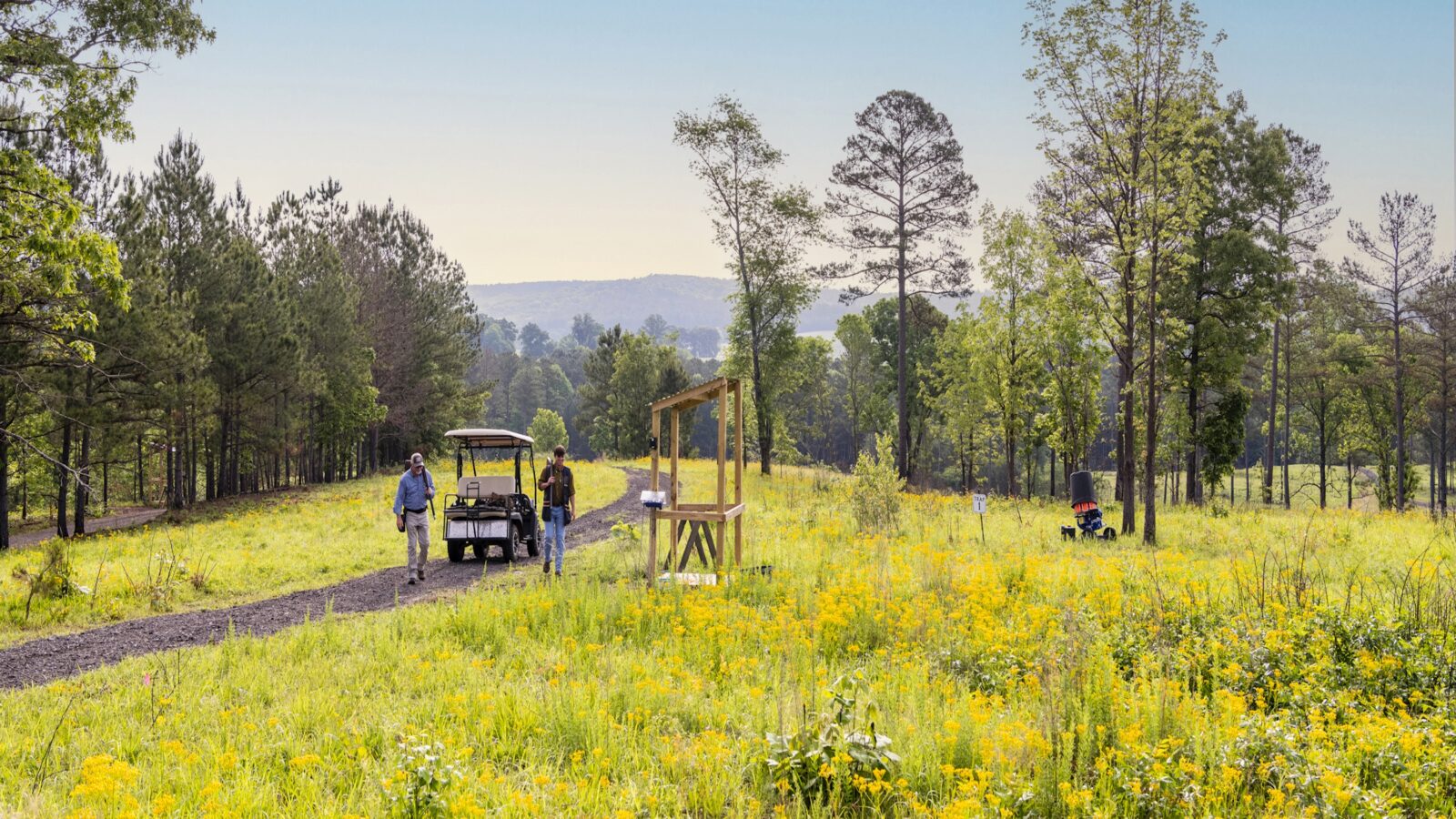
Photo: Courtesy of Barnsley Resort
A Barnsley Resort shooting station.
Spruced-up sporting grounds bring new adventures
By Daria Smith
Where: Adairsville, Georgia
When: year-round
If you like: the sporting life
Why you should go: Though the sport of helice, which challenges shotgunners with fast, freewheeling targets known as ZZ birds, is still something of a niche pursuit in the United States, its devotees say it’s as close as you can get to the thrill of live bird shooting. “You have five machines spinning up to 5,500 rpm with an oscillating head, so it might throw high, low, left, or right,” says Drew Burrell, director of operations at Beretta Shooting Grounds at Barnsley Resort, a three-thousand-acre retreat in the North Georgia foothills. “You never know, and that’s the fun part.” Barnsley introduced the new helice station and upgraded two fifteen-station sporting clays courses last year, part of a slew of improvements that included a $6 million renovation of the resort’s rustic-luxe cottages. Across the former nineteenth-century estate of Godfrey Barnsley, sporting-minded guests can also join guided hunts for quail, turkey, and pheasant; test their aim on a thousand-yard challenge; and fine-tune their golf and pickleball swings.
G&G tip: You don’t have to be an overnight guest to tour the formal gardens and dramatic ruins of the 1840s-built manor house. Day passes are available for $15 and include admission to a small museum about the Barnsley family.

Photo: Mac Stone
A captive male red wolf at the Red Wolf Center in Columbia, North Carolina.
And maybe someday soon, a family of them
Where: Columbia, North Carolina
When: year-round
If you like: conservation
Why you should go: Four painted red wolves gaze out from a mural on the walls of the Red Wolf Center, and just beyond, visitors can see the real thing: a pair of the critically endangered canines, who reside in an enclosure out back. “This year we have the first breeding pair we’ve ever kept there,” says Kim Wheeler, the executive director of the Red Wolf Coalition and a volunteer caretaker of the captive wolves. Wheeler is hopeful the pair will produce puppies this spring, giving the public the even rarer chance to see a family group up close. Meanwhile, inside the center, an exhibition shares the larger story of the world’s most imperiled wolf: The apex predators once lived all over the American South before habitat loss and hunting drove them extinct in the wild in 1980. Captive breeding allowed them to regain a toehold, and now a recovery program is working to restore the population on North Carolina’s Albemarle Peninsula, in a five-county area just west of the Outer Banks—the only place in the world where red wolves roam wild.
G&G tip: To try and catch a glimpse of one of the wild red wolves, drive slowly through the Alligator River National Wildlife Refuge, ideally in winter, when there’s less foliage to conceal them. Keep your eyes peeled for black bears, river otters, and tundra swans, too.
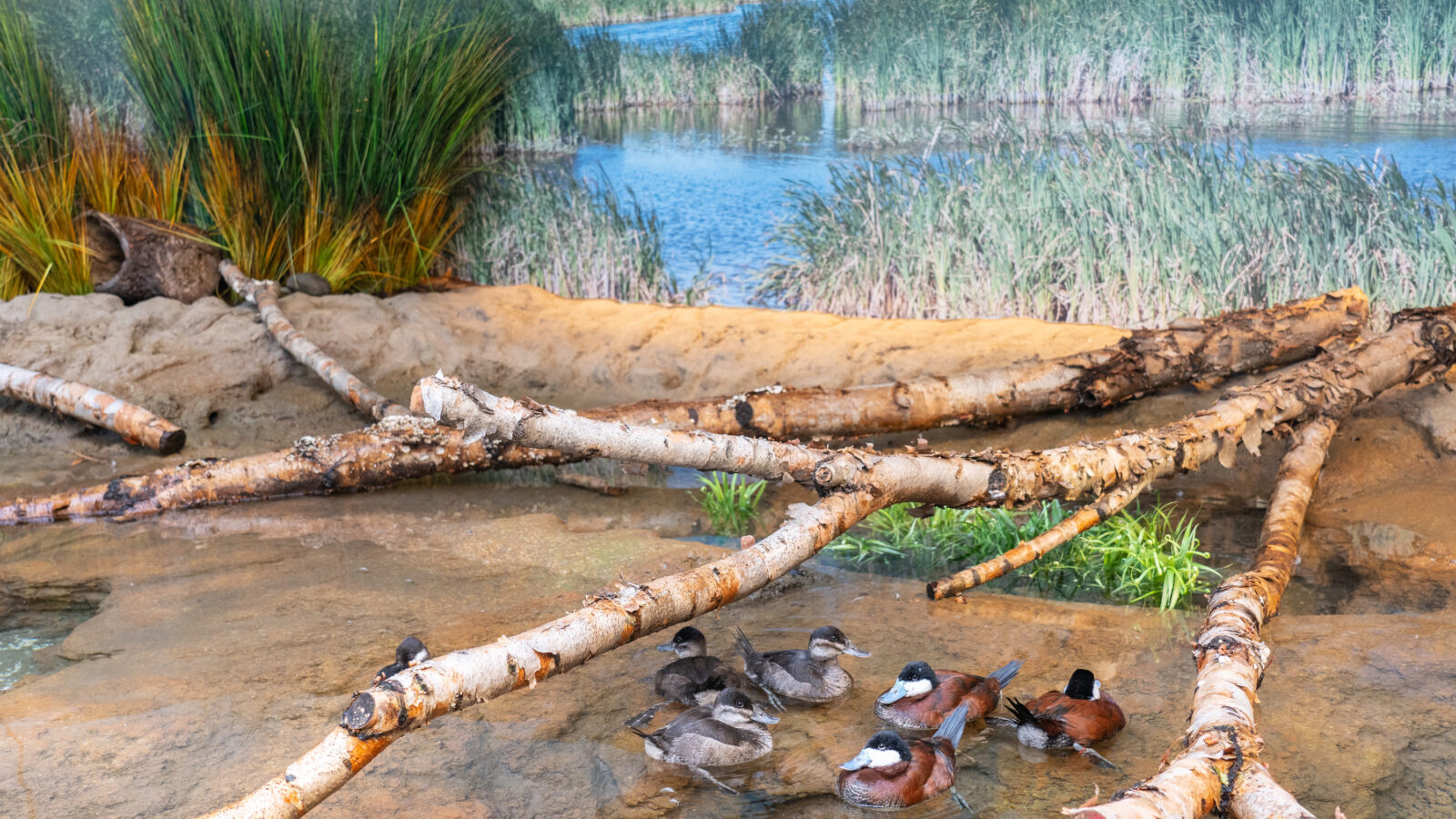
Photo: courtesy of the National Zoo
Ruddy ducks at the Smithsonian National Zoo.
Don’t forget your binoculars
By Elizabeth Florio and Lindsey Liles
Where: Washington, D.C.
When: year-round
If you like: conservation
Why you should go: Compared with the return of giant pandas to the Smithsonian’s National Zoo last fall, the redesign of the park’s Bird House captured few headlines. But the latter attraction, originally built in 1928 and reopened in 2023 after a six-year closure, is far more embedded in the DNA of the property—and the continent on which it resides—than those (adorable) Chinese superstars. “We wanted to tell the story of our own migratory birds here in North America,” says Sara Hallager, curator of birds at the National Zoo and Conservation Biology Institute, about the trio of enclosure-free aviaries inside the new facility. In the Prairie Pothole area, guests meander among swimming, waddling, and diving waterfowl, including ruddy ducks and buffleheads (“a little duck with a big personality”). An aviary designed to look like a coffee farm hosts some sixty migratory neotropical songbirds, among them magnolia warblers, Baltimore orioles, and yellow-breasted chats. Meanwhile, native shorebirds like sanderlings and red knots populate the Delaware Bay exhibit, and whooping cranes, ibises, and spoonbills occupy outdoor wetlands. That’s not to say you won’t see any farther-flung species in the Bird House; look out for tiled parrots and toucans on the mosaic archway in the lobby, a relic from the original building.
G&G tip: Springtime, when the birds enter their breeding season, is an especially exciting time to visit. “The ruddy ducks have bright blue bills and the males do this crazy courtship display where they puff out their chests and make a thumping sound,” Hallager says. Over at the coffee farm, indigo buntings turn a vibrant blue and the warblers brighten up, too, and soon after, visitors can see the songbirds raise chicks.
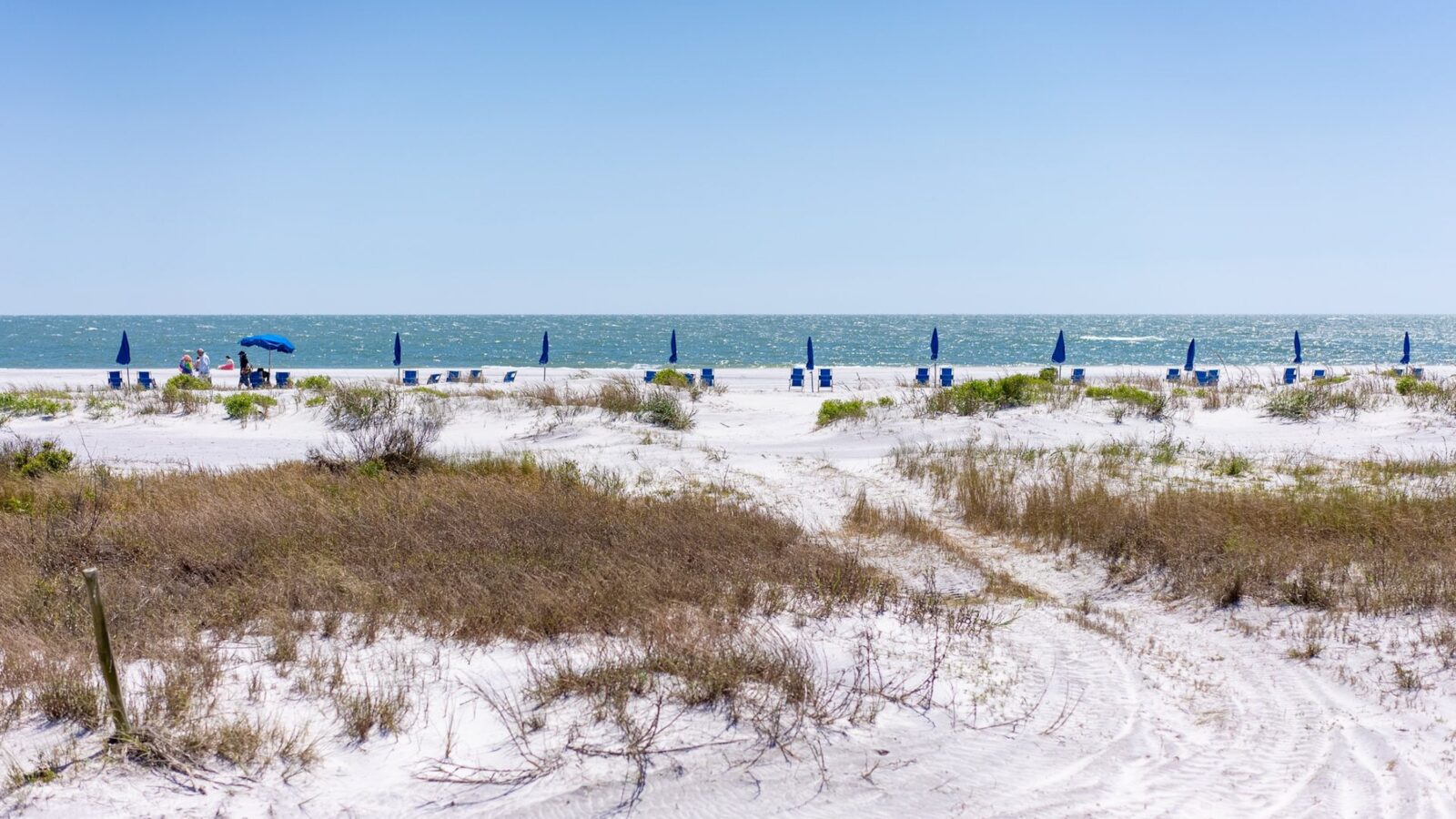
Photo: Courtesy of Coastal Mississippi
The beach at Ship Island.
An off-the-grid sanctuary of shifting sand
Where: Ship Island, Mississippi
When: spring, summer, fall
If you like: the outdoors and sports, conservation
Why you should go: It wasn’t that long ago that Mississippi’s Ship Island was actually Ship Islands, plural. Hurricane Camille split it in half in 1969, and over time it inched toward healing naturally—until Hurricane Katrina barrelled through Gulf Islands National Seashore and reinstated the damage. This time, the National Park Service stepped in to save the treasured barrier island, and in 2020, after a $400 million restoration project (the second largest in NPS history), Ship Island was made whole for the first time in over five decades.
Today it plays host to hermit crabs, ospreys, herons, and beach mice, to name a few species—plus day-trippers who make the twelve-mile journey by ferry from Gulfport. “As we cruise along, there are dolphins riding beside us and birds following the boat,” says Kevin Buckel, a director at Ship Island Excursions, the family-owned ferry business that will mark a century of operation next year. Halfway through the ride, passengers lose cell phone service—all the better to unplug and snorkel in emerald waters, hunt for pen shells and lightning whelks on the beach, sit in the shade of the circa-1858 Civil War site Fort Massachusetts, and scope out all sorts of avians, including reddish egrets and magnificent migratory frigate birds.
G&G tip: Among the velvety, quartz-heavy white sands of the island, look out for patches and swirls of black. No, it’s not a sign of pollution; the black comes from zircon, a mineral from the Appalachian Mountains that washes down to the Gulf and deposits on the barrier islands.

Photo: Jennifer Stein
A coral reef at Dry Tortugas National Park.
Even better, dive into efforts to save them
Where: Florida Keys
When: year-round
If you like: conservation, the outdoors and sports
Why you should go: Under the turquoise waters of Dry Tortugas National Park, vibrant formations of staghorn, elkhorn, star, and brain coral carpet the sand. Here, 70 miles off the coast of Key West, Florida’s coral reef begins, stretching over 350 miles to the St. Lucie Inlet in Martin County. The only extensive shallow-water reef system in the continental United States, it’s home to an astounding array of marine life and is as endangered as it is beautiful. Since the 1970s, Florida’s coral coverage has plunged by 90 percent because of heat stress, coastal development, pollution, and disease—a devastating loss to the thousands of species that depend on it, from parrotfish, grouper, and snapper to lobsters and sea turtles.
Still, some of the coral is hanging on, and tour operators throughout the Keys—including at Key Largo’s John Pennekamp Coral Reef State Park, the nation’s first undersea park—offer snorkeling and diving tours to see it. If you’re not venturing down into the Keys, you can also rent snorkeling gear and set out from Biscayne National Park in Homestead. Better yet, join up with one of many worthy conservation efforts, perhaps assisting Tampa’s Florida Aquarium with outreach, caring for growing coral at Mote Marine Laboratory’s facilities in the Keys, donating to research organizations like the Coral Restoration Foundation, or even training to assess reef health through BleachWatch.
G&G tip: When booking a snorkeling or diving tour to see coral, check to see if the agency is a Blue Star Operator, a designation that indicates a commitment to conservation and safe exploration of the reefs.
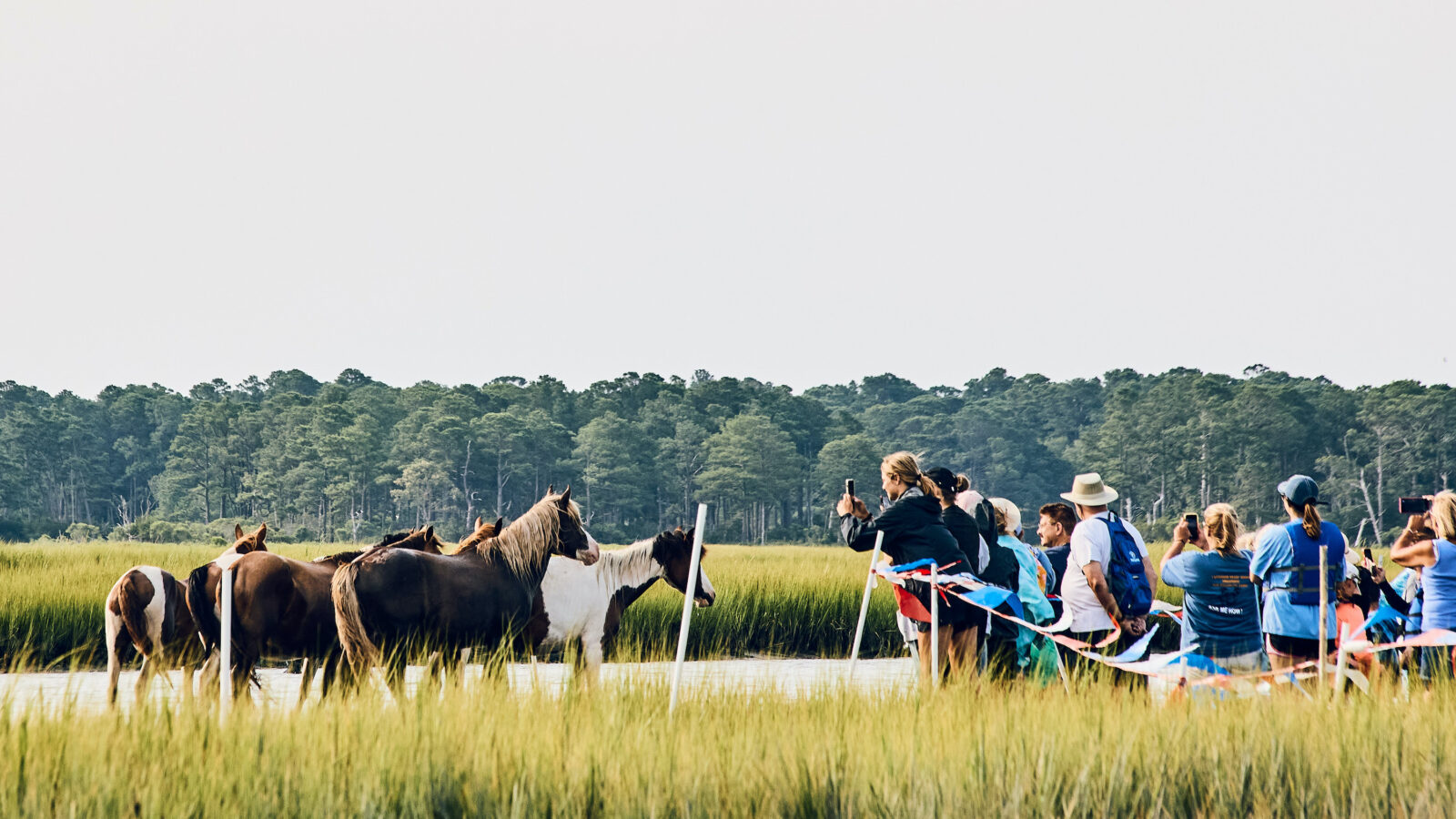
Photo: Peter Frank Edwards
Ponies prepare to swim back to Assateague Island.
Two hundred wild ponies will make a milestone splash
By Emily Daily
Where: Chincoteague Island, Virginia
When: summer
If you like: conservation
Why you should go: This summer marks the hundred-year anniversary of the Chincoteague Pony Swim, also known as Pony Penning Day, a beloved annual event popularized by the 1947 children’s novel Misty of Chincoteague. On the last Wednesday in July, close to two hundred feral ponies and foals swim the short distance from their home on Assateague Island to the tiny Eastern Shore fishing village of Chincoteague, guided by the skilled riders and volunteer firefighters known as Saltwater Cowboys. The ponies cross the channel during slack tide, typically between 7:00 a.m. and 1:00 p.m., and then rest for an hour before parading to Main Street, where crowds cheer their arrival.
The following morning, foals are auctioned off to raise money for the Chincoteague Volunteer Fire Company, which organizes the event and cares for the ponies year-round. (The auction helps keep the island’s herd size in check, although a select few foals will remain wild.) Visitors should note that local accommodations fill up fast, so book early—the Chincoteague Chamber of Commerce is a good resource—and if you miss the main event on Wednesday, you can watch the ponies return across the channel on Friday.
G&G tip: Head to the Museum of Chincoteague Island to pay homage to Misty herself in taxidermied form (it’s less terrifying than it sounds), learn more about the island’s culture and the tradition of pony penning, and even play some games. “The museum hosts Buckaroo Bingo on Tuesday afternoon, and we give away huge prizes,” says Cindy Faith, the museum’s assistant director. The historic Beebe Ranch—Misty’s home on Chincoteague for many years—was recently purchased by the museum and will open its doors this summer.

Photo: leigh webber
Synchronous fireflies in Congaree National Park.
A pristine park in the Alleghenies makes for magical viewing
Where: Pocahontas County, West Virginia
When: summer
If you like: the outdoors and sports, conservation
Why you should go: Every spring and early summer, Southern forests come alive with the pulsing glow of more than a hundred species of fireflies looking for mates. Photinus carolinus, though, does things a little differently. The males light up in a series of five to eight flashes, followed by an eight-second pause, and as the night wears on, the bugs synchronize in a display most famous in Tennessee’s Great Smoky Mountains and South Carolina’s Congaree National Park. But more recently, Photinus carolinus was discovered at a new location, too: West Virginia’s Watoga State Park, whose name comes from the Cherokee word for starry waters. The park’s 10,100 acres encompass its eponymous lake in the Allegheny Mountains, old-growth forests, forty miles of trails, and a new nature center opening this summer. In 2021, Watoga State Park earned international Dark Sky Park status for its pristine nighttime conditions—making it the perfect place to watch the synchronous firefly shows, which start sometime in June and usually take place around 10:00 p.m each night.
G&G tip: Tourism to see synchronous fireflies can put the bugs at risk. To enjoy them safely, keep flashlights off, as it disrupts their communication, and stick to the trail to avoid stepping on the females, which stay on the ground as the males put on their display.

Photo: courtesy of Home Industry Bakery
A pepperoni roll from Home Industry Bakery in Clarksburg, West Virginia.
It might be the perfect road-trip food
By Emily Daily
Where: West Virginia
When: year-round
If you like: dining and drinks
Why you should go: As the official food of the Mountain State, pepperoni rolls are a regional delicacy akin to New York’s bagel or Philadelphia’s cheesesteak. In fact, they’re older than Philly’s famed sandwich—and a lot less messy to eat. Created in the 1920s by a coal miner named Giuseppe Argiro, the rolls were a convenient, portable snack to carry underground. Country Club Bakery in Fairmont still uses his original recipe, and while there’s some debate on the finer points of a perfect roll (crusty bread versus soft, sticks of pepperoni versus slices), the general concept calls for baking pepperoni inside Italian bread, allowing the fat of the meat to flavor the dough.
“Honestly, is there a wrong choice?” says Jessica Harris, whose family owns and operates Home Industry Bakery in Clarksburg, which produces three types of handmade rolls (loaded with two dozen slices of pepperoni each) along with mini versions. “They’re not messy, they have their own packaging with no other utensils needed, and they are as ready-to-eat as they come.” In fact, these little snacks make the ideal road-trip food—they can be eaten with one hand, and you just might find your favorite version at a local gas station.
G&G tip: While Clarksburg is a well-known magnet for pepperoni roll lovers, Morgantown has plenty of bakery options, including the Pepperoni Roll Bar, where you can customize your toppings and grab a bag of homemade kettle corn.
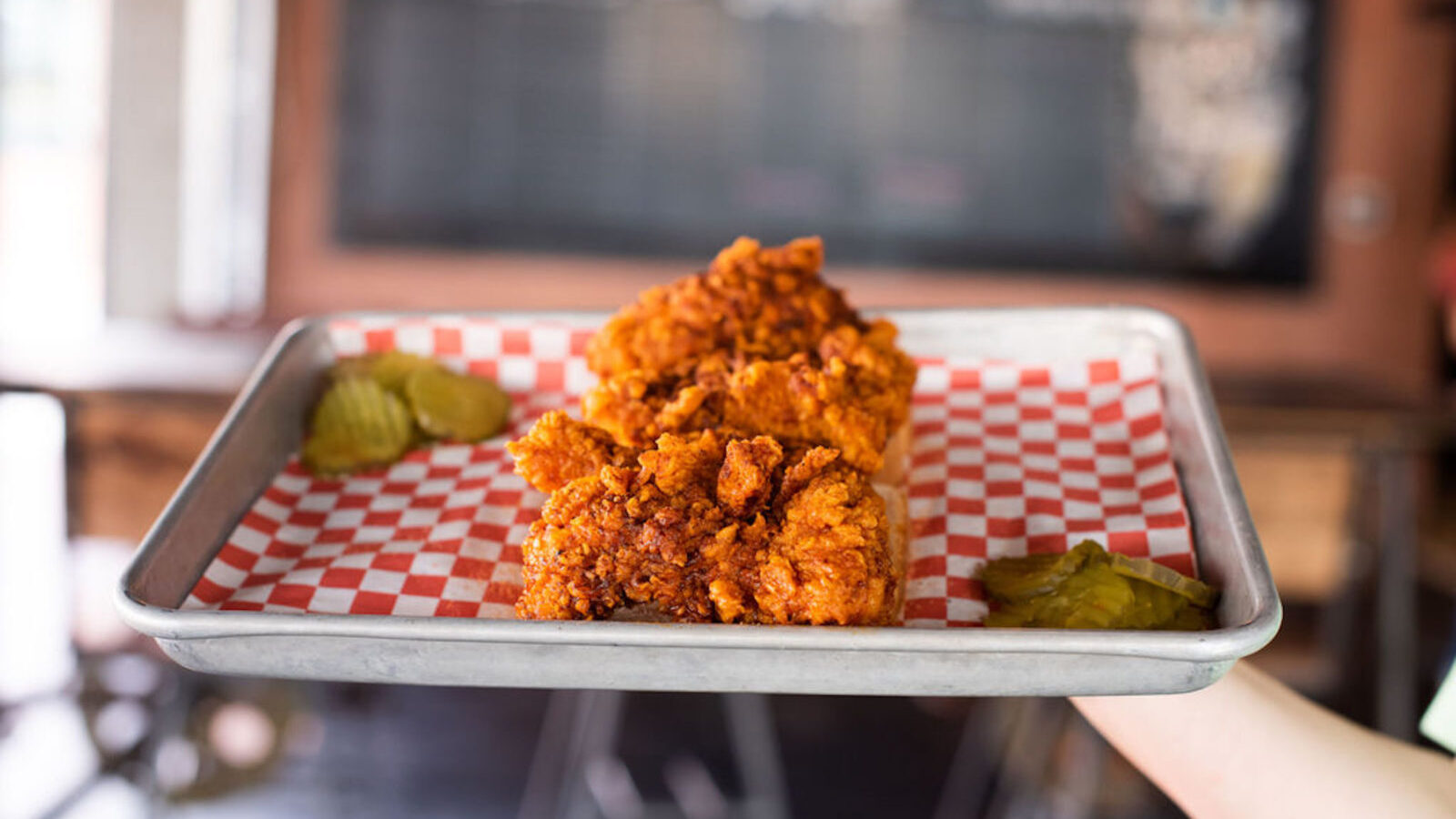
Photo: Reese Moore Photography
Prince’s spicy fried chicken.
Prince’s still scorches in Nashville
By Elizabeth Hutchison Hicklin
Where: Nashville, Tennessee
When: year-round
If you like: dining and drinks
Why you should go: Diners can find hot chicken on menus from Alabama to Alaska these days, but for a true taste of tradition, plan a culinary pilgrimage to Prince’s Hot Chicken in Nashville. With an appropriately spicy origin story involving a scorned lover and a plate of devilishly hot “revenge” chicken, one that inspired unexpected pleasure over pain, the country’s OG hot chicken shack opened on Jefferson Street in Nashville in 1945. Eighty years later, a lot has changed in Music City, but Prince’s is still slinging batch after batch of fiery fried chicken. “We’re always working to stay current—to see the change and adapt while staying true to who we are as a family,” says Semone Jeffries, the current owner and daughter of longtime proprietor André Prince Jeffries.
Today the family’s cayenne-crusted birds come in eight heat levels, from plain to XXX-Hot, and devoted fans don’t mind waiting, sometimes hours, for the fried-to-order plates. It’s this unbridled enthusiasm that allows Prince’s to bridge the gap between old Nashville and new; the company recently opened outposts at the city’s glitzy new soccer stadium, Geodis Park, and the Nashville airport, and it’s also planning a return to its roots. “Our next project takes us back to where it all started—to Jefferson Street, the root of Black business and Black culture in Nashville,” Jeffries says.
G&G tip: Proceed with caution, first-timers. “We always recommend starting with mild,” Jeffries says. “If someone insists that they can take the heat, we advise ordering medium. It puts you in the middle. It’s flavorful with a touch of fire.”
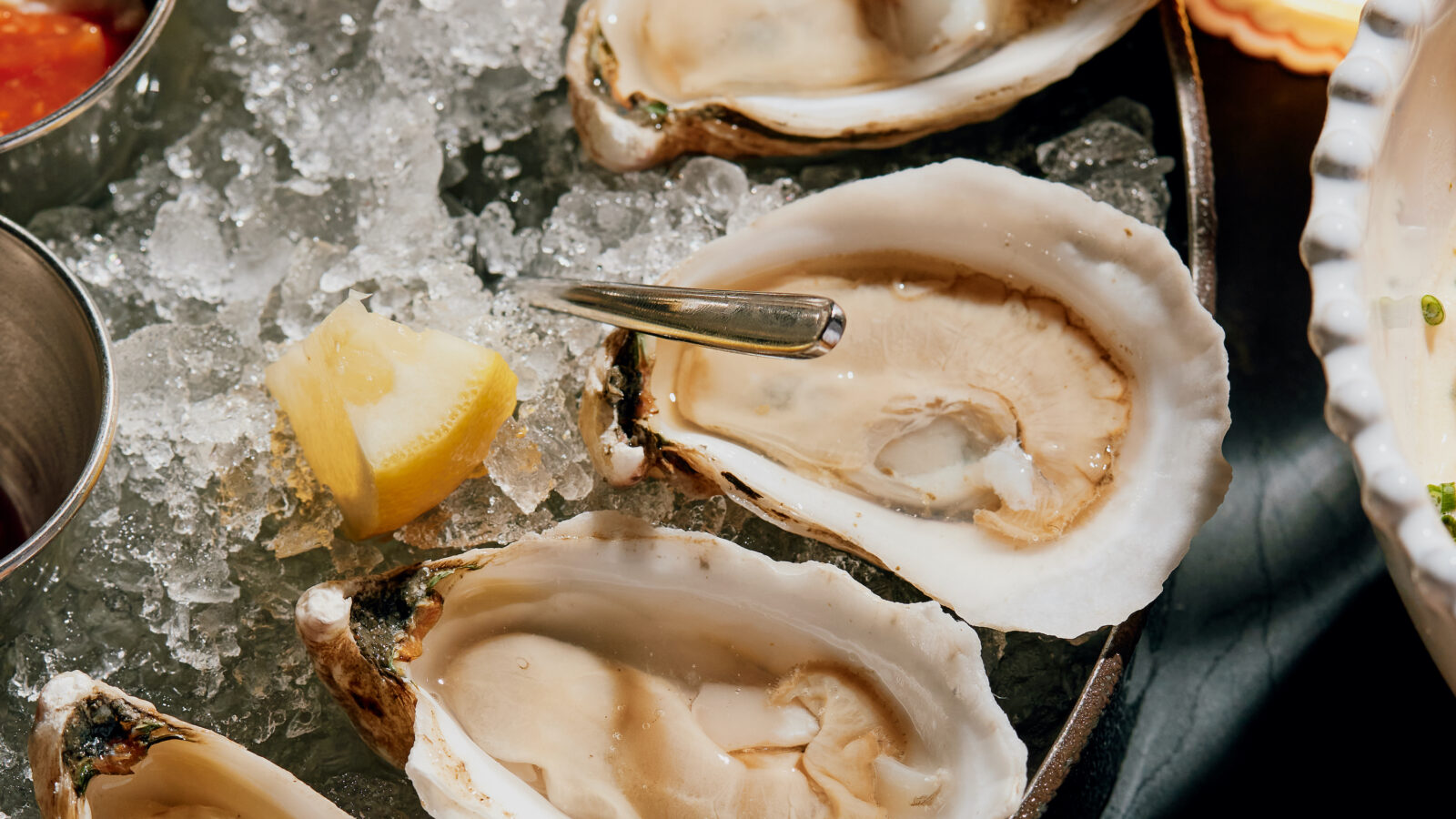
Photo: Hayden Stinebaugh
Oysters at Lowland at the Quinte.
In the Holy City, the oyster is your world
Where: Charleston, South Carolina
When: year-round
If you like: dining and drinks
Why you should go: Centuries ago, the peninsula now known as Charleston was a shell-strewn stretch of land called Oyster Point. But even in a city built on bivalves, the succulent delicacy has never been more popular than it is today—as evidenced by the crowds jockeying for bar stools at spots like 167 Raw Oyster Bar and Lowland at the Quinte and the jam-packed winter calendar of oyster roasts, including the world’s largest, February’s Lowcountry Oyster Festival. Thank goodness the region is also home to a top-tier example of sustainable oyster farming, the Lowcountry Oyster Company, which helps take pressure off wild stock. “Our whole goal is to feed as many people across America as we can on the smallest footprint,” founder Trey McMillan says. That it does, stocking restaurants and grocery stores and shipping directly to consumers nationwide. But for the freshest taste of their “Lowcountry Cups,” book an ecotour of their floating farm, located just outside the city in the scenic ACE Basin.
G&G tip: Keep an eye on the Instagram account of De Mare Raw Bar, a boat-to-table purveyor that pops up at local hangouts like Perch and Philosophers & Fools.
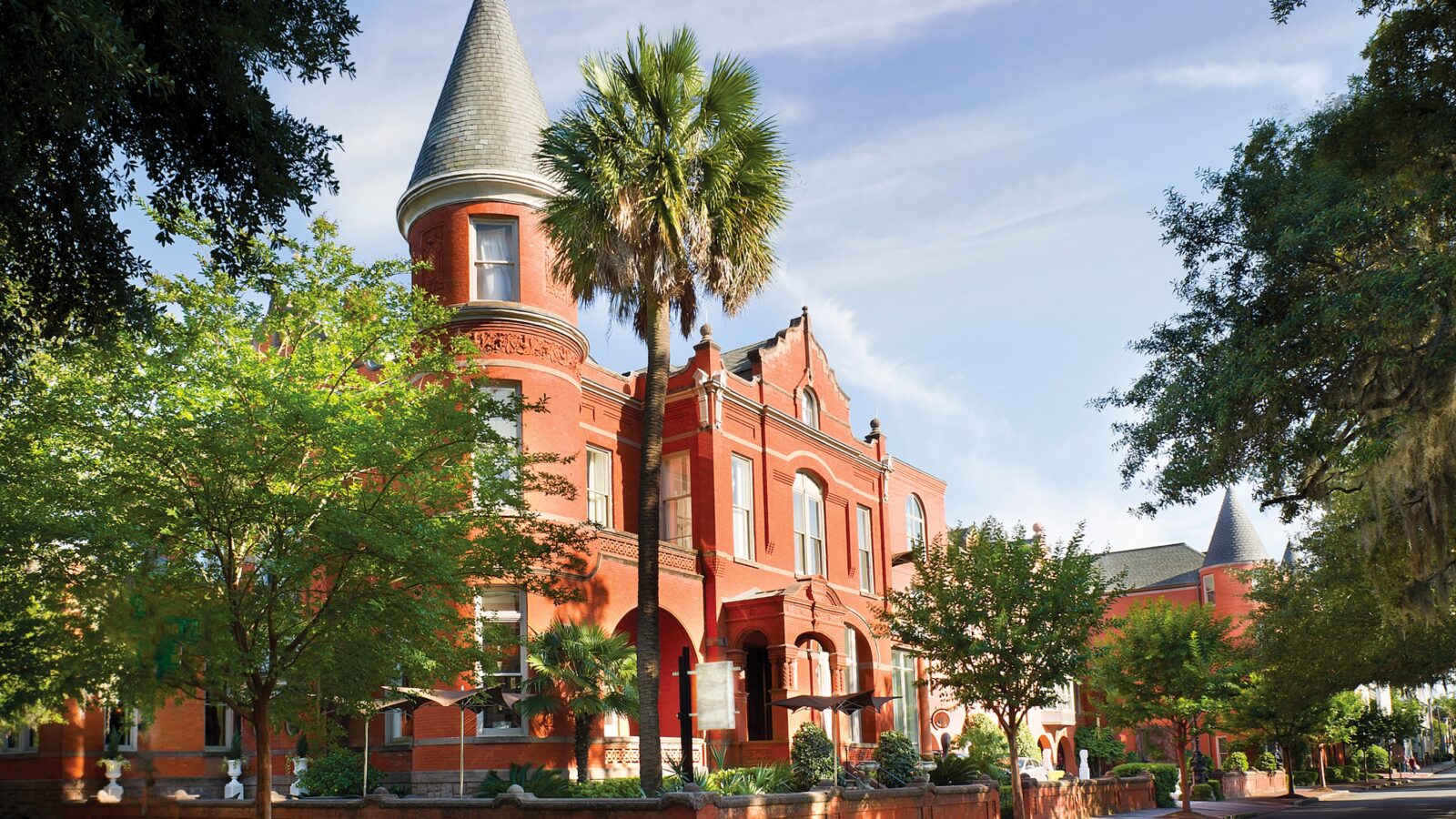
Photo: Courtesy of Hotel Bardo
Outside Hotel Bardo.
This grande dame has some spring in her step
Where: Savannah, Georgia
When: year-round
If you like: urban escapes, history, dining and drinks
Why you should go: Savannah is fresh off a thirtieth birthday of sorts: The year 1994 had been a momentous one, with John Berendt revealing the city’s seductive underbelly with the publication of Midnight in the Garden of Good and Evil and Tom Hanks doling out life lessons from a picturesque downtown bench in Forrest Gump. Tourists descended like ants on a praline, and Savannah has been stretching to accommodate them ever since. In the past five years, two gleaming new mixed-use districts have reshaped the historic riverfront, while the restaurant-rich Starland District has lured visitors south. Between those two hubs, the Hotel Bardo opened last year on Forsyth Park and transformed a Southern Gothic mansion into a stunning oasis with Amalfi Coast vibes. And later this spring, the team behind the Death & Co. cocktail empire will debut its first hotel, the Municipal Grand, in the heart of the historic district; fittingly, the lobby’s Municipal Bar will be the centerpiece. “If you’re walking down Broughton Street, you will see what will look like a big, bustling bar and restaurant, and that’s very intentional, whereas on the other side, on Abercorn, you’ll see more clearly that this is a hotel,” says Alex Day, cofounder of Midnight Auteur, the group’s hospitality brand.
With a Ritz-Carlton on the horizon for 2026, Savannah’s sheen doesn’t look to be dulling—which makes it all the more inviting to enjoy a peaceful picnic (martini optional) in Bonaventure Cemetery, as Berendt did, or warm a bench in an oak-shaded square like Gump.
G&G tip: The Grey, the restaurant many credit for launching Savannah’s grown-up food scene, recently marked its tenth anniversary and remains as vital as ever, a homeplace for moments of both celebration and contemplation. Note the neon art installation in the ceiling rafters, which lights up every hour for two minutes and twenty-three seconds to mark the date of the 2020 murder of Ahmaud Arbery in nearby Brunswick.

Photo: Courtesy of the John C. Campbell Folk School/Cory Marie Podielski
The John C. Campbell Folk School in Brasstown, North Carolina.
A bucolic bastion of craft and tradition
By Elizabeth Hutchison Hicklin
Where: Brasstown, North Carolina
When: year-round
If you like: arts and culture
Why you should go: Learn to weave willow baskets or forge a chef’s knife. Study medicinal herbs to grow your own kitchen apothecary, or build a four-string Appalachian dulcimer. Offering more than eight hundred week- and weekend-long classes across more than fifty disciplines, Brasstown’s John C. Campbell Folk School caters to established artists looking to strengthen existing skills as well as beginners exploring new avenues of creativity.
Set on 270 picturesque acres in the Southern Appalachians, the school was founded in 1925 by Olive Campbell and Marguerite Butler in the style of a Danish folkehøjskole, or “school for life.” But the people of Cherokee and Clay Counties provided much of the materials, labor, and land required to realize their vision. One hundred years later, “our format has adapted to changing needs over the decades, but we remain true to our core values and have never lost sight of our role in honoring and supporting the local community that helped build and sustain us,” says executive director Bethany Chaney. Centennial celebrations kick off during the school’s annual fall festival in early October and run through its Appalachian Heritage Week the following summer.
G&G tip: With its scenic pastures, wooded trails, and quiet creek banks, the landscape around the school provides creative inspiration but also, often, the physical materials of the craft. Check the schedule for season-driven classes in such disciplines as basketry, cooking, and natural dyeing.
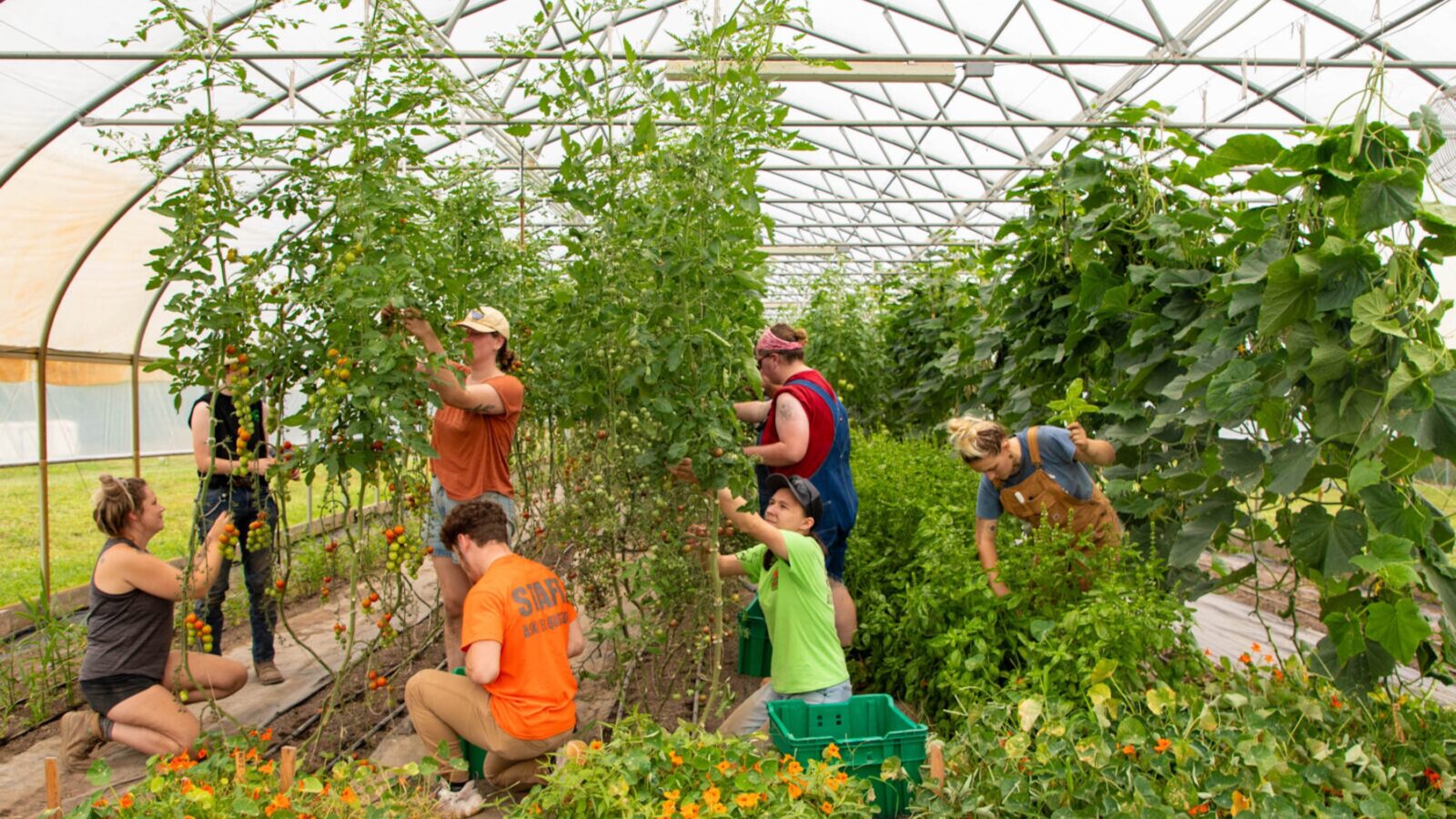
Photo: Courtesy of Farms Work Wonders
Harvesting tomatoes and basil at Lewis Farm.
Grab a cinnamon roll and support this charming youth-driven farming community
Where: Wardensville, West Virginia
When: year-round
If you like: arts and culture
Why you should go: The sculpture of a red cow wearing a cowboy hat at the Lost River Trading Post or the umbrella-topped picnic tables outside a local market might tempt you to slow your wheels in Wardensville, an inviting crossroads in West Virginia’s eastern panhandle. But what makes the town truly special is its story of homegrown revitalization. Most community highlights fall under the canopy of Farms Work Wonders (FWW), a nonprofit that grows the local economy by training “junior crew members” aged sixteen to twenty-one in farming, culinary, and business skills. Inside the Wardensville Garden Market, for example, you can shop for produce grown within sight at Lewis Farm, where the crew learns sustainable techniques, and shop for FWW-made wares. The town’s showcase restaurant, Mack’s Bingo Kitchen, spins the farm’s harvest into sweets and savories, including an unforgettable chicken sandwich, while Mack’s Bingo Bakery serves up a gooey cinnamon bun; both employ local youth in the kitchen. “The number-one thing that highlights this place is that everyone around you really cares,” says junior crew alum Brenden Furlong.
G&G tip: On the second Saturday of each month from May through December, the Wardensville Garden Market kicks it up a notch with special programming like live music or crew-led farm tours.
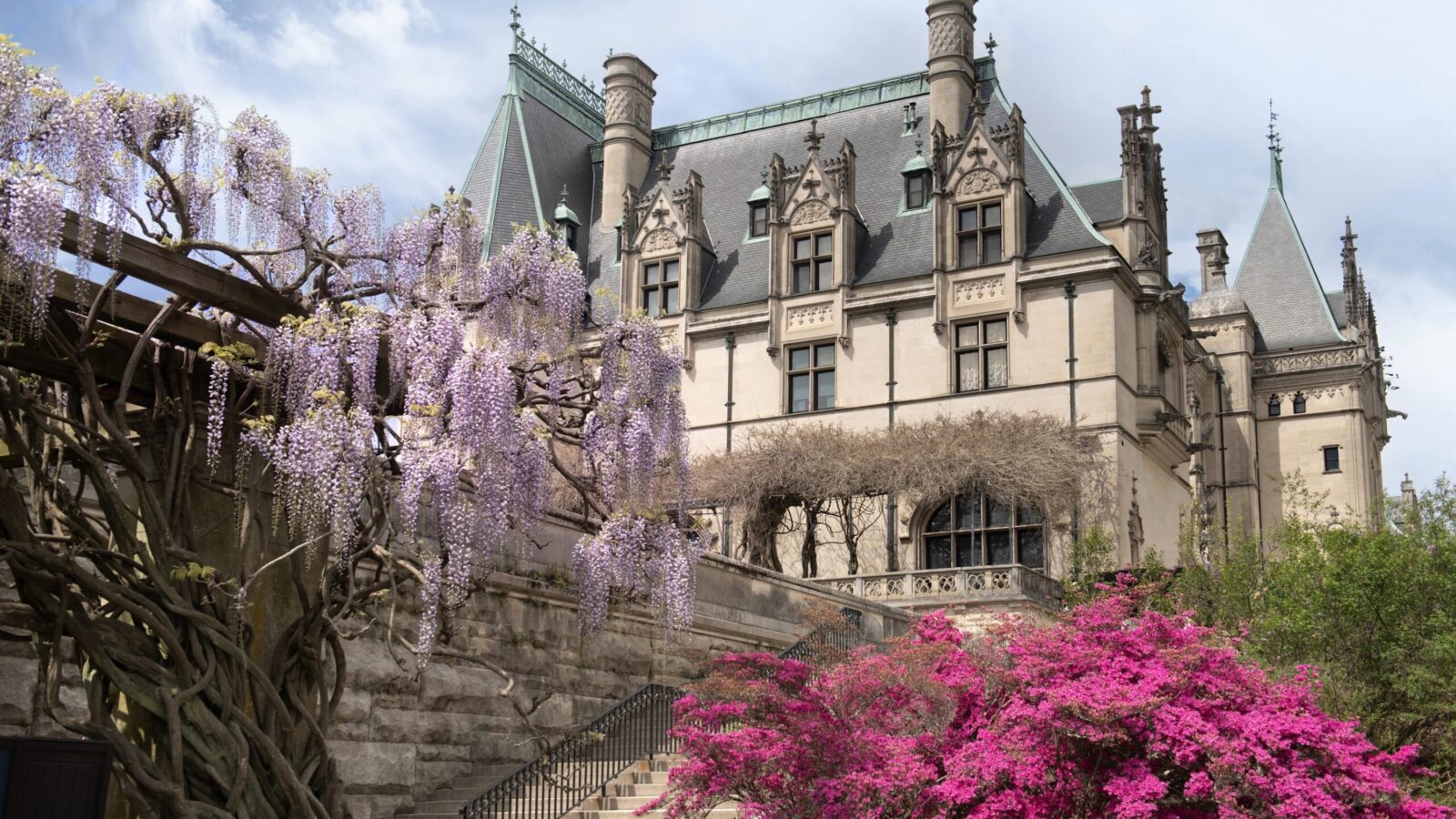
Photo: Courtesy of the Biltmore Company
Spring blooms outside Biltmore House.
A Western North Carolina landmark for all seasons
Where: Asheville, North Carolina
When: year-round
If you like: history, gardens
Why you should go: America’s largest home puts on a show every season—thousands of daffodils, tulips, and azaleas in the gardens in spring; horseback riding and farm-to-table dining in summer; jewel-toned chrysanthemums and turning leaves in fall; and the glow of firelight and fir trees at Christmas. After avoiding the worst of the wrath of Hurricane Helene, which barreled through the area last September, Biltmore is moving forward with plans for its 130th anniversary in 2025. Starting this month, it will present Tutankhamun: His Tomb and His Treasures at its own Amherst at Deerpark Exhibition Center. (George and Edith Vanderbilt, who constructed the estate in 1895, visited Egypt often, and their son-in-law, John Francis Amherst Cecil, counted the tomb’s discoverer, Howard Carter, as a family friend.) Also this spring, Biltmore will complete a two-year refresh of the Inn on Biltmore Estate, which added nature-inspired wall coverings, embossed-leather and carved-wood detailing, and re-creations of artwork from the Vanderbilt family collection.
G&G tip: Biltmore is known as the birthplace of American forestry, and its Olmsted-designed grounds house numerous state-champion trees, including a katsura tree with apricot-hued fall foliage and a sweet, cinnamon-like fragrance. Find it in the Azalea Garden.
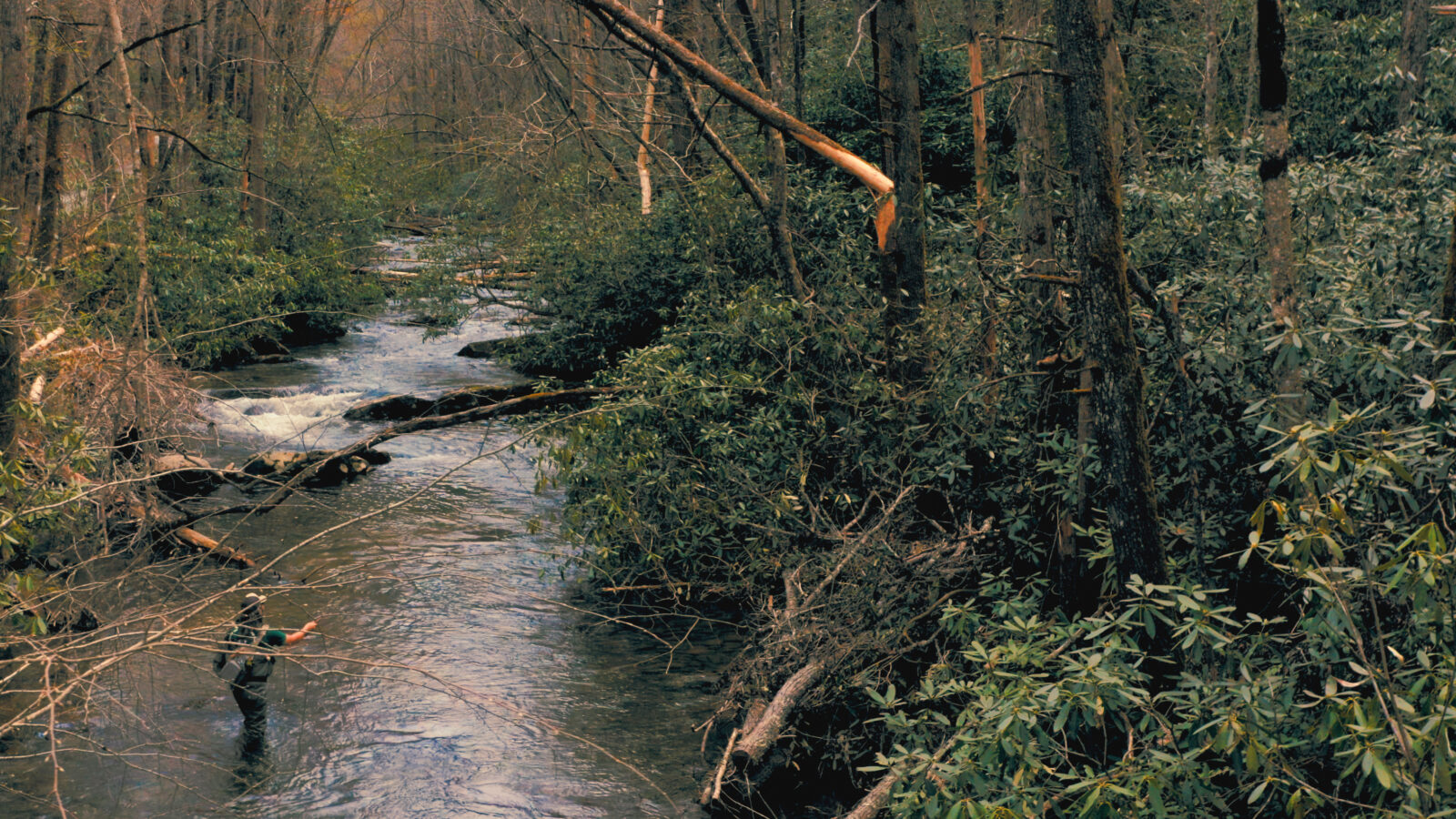
Photo: Courtesy of Trout Unlimited/Sam Dean
Casting for brook trout in the Smokies.
A well-rounded angling adventure
Where: Great Smoky Mountains National Park, Tennessee
When: year-round
If you like: the sporting life, the outdoors and sports
Why you should go: Blue lining for brook trout, says Mark Taylor of the conservation nonprofit Trout Unlimited, offers the best of all worlds. “It’s a combination of exploring and hiking and fishing,” he says. “Just study a map, look for the little blue lines above two or three thousand feet, and take off.” But brookies aren’t necessarily easy to find. The region’s only native trout species was once common all over the Southeast, but competition from introduced game fish like brown and rainbow trout, coupled with widespread habitat degradation, has cut into their numbers. Today organizations like Trout Unlimited are hard at work removing invasive trout species and improving stream habitat across the brook trout’s range. “They’re hardy, resilient little fish,” Taylor says. “If the habitat is there, they can recover.”
As the waterways of Western North Carolina—brook trout mecca—reckon with the devastating floods of Hurricane Helene, Tennessee offers ample opportunities to chase the speckled fish. To catch one (and release it back where you found it), Taylor says there’s no better place than the picturesque, high-elevation streams in Great Smoky Mountains National Park between April and October.
G&G tip: Taylor likes to use TroutRoutes to guide his angling and wandering. The downloadable app has mapped 50,000 streams across the country, and it clues you in to public access points, fishing regulations, and even stream heights and flow rates.
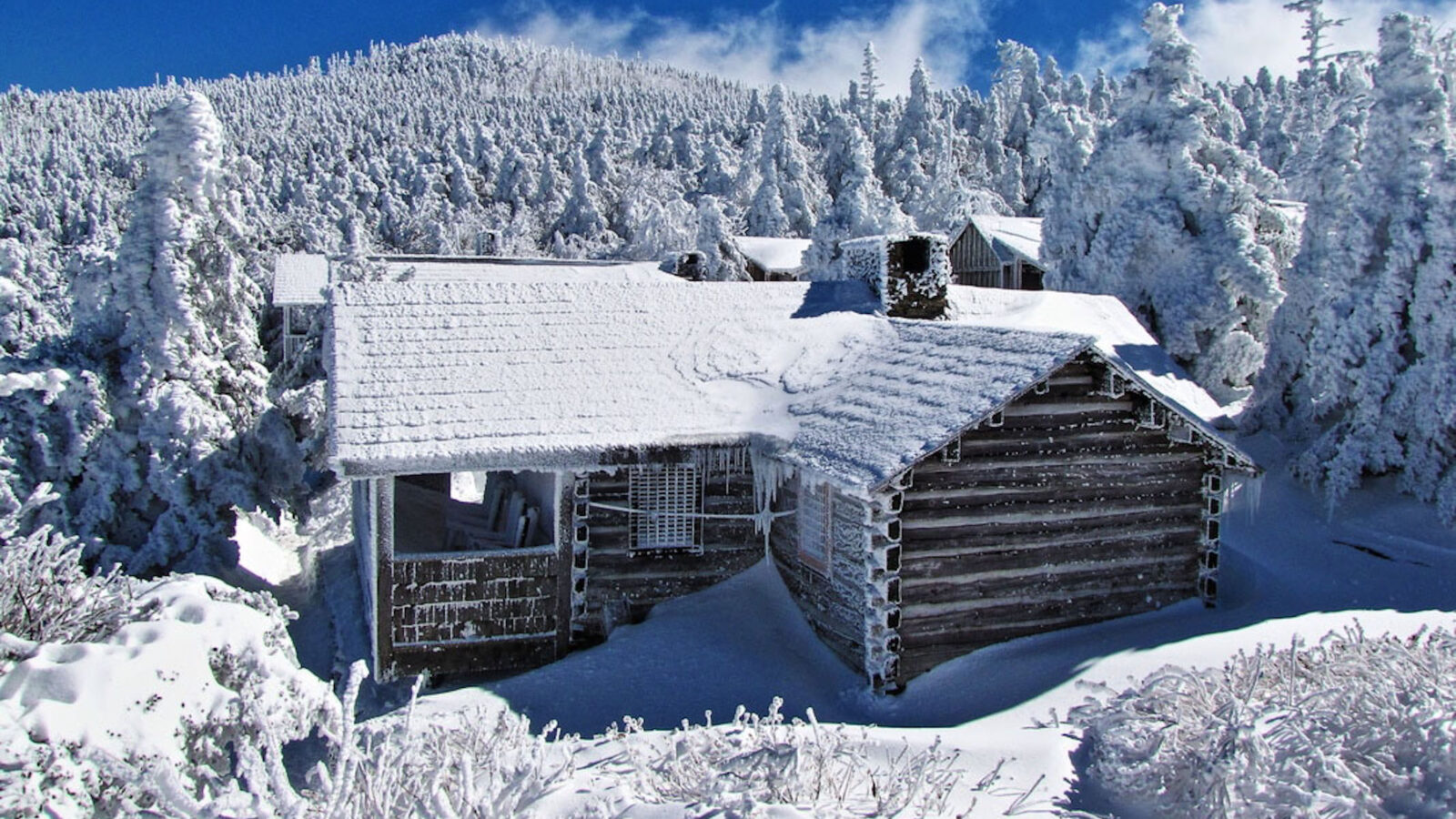
Photo: WILDCAT/Bert, courtesy of LeConte Lodge L.P. & Stokely Hospitality Enterprises
LeConte Lodge in the winter.
The journey is the destination
By Elizabeth Hutchison Hicklin
Where: Great Smoky Mountains National Park, Tennessee
When: spring, summer, fall
If you like: the outdoors and sports
Why you should go: One hundred years after it welcomed the first hikers to the top of Mount LeConte—the third-highest peak in Great Smoky Mountains National Park—LeConte Lodge remains just as blissfully low-tech as it was in 1925. You still won’t find electricity, internet, or running water, and the only way to reach its rough-hewn cabins is to lace up your hiking boots. But the lack of contemporary creature comforts hasn’t kept the lodge from remaining solidly booked March through November. “Staying at the lodge has been a longtime tradition for countless guests, many of whom have been gathering here for generations,” says general manager John Northrup. “And even with it being a hike-only destination, the trek to the summit is achievable for a range of fitness levels and age groups.” The lodge is booked for the 2025 anniversary season, but Northrup invites prospective guests to call or email to join the cancellation list and advises checking the website toward the end of summer for information on 2026 reservations.
G&G tip: Alum Cave Trail is the preferred trail for most visitors. At five miles, it’s the shortest and the steepest of the five trails leading to the lodge but also the most scenic. Even still, Northrup suggests contacting the reservations office for the most up-to-date trail and safety information before you set out.
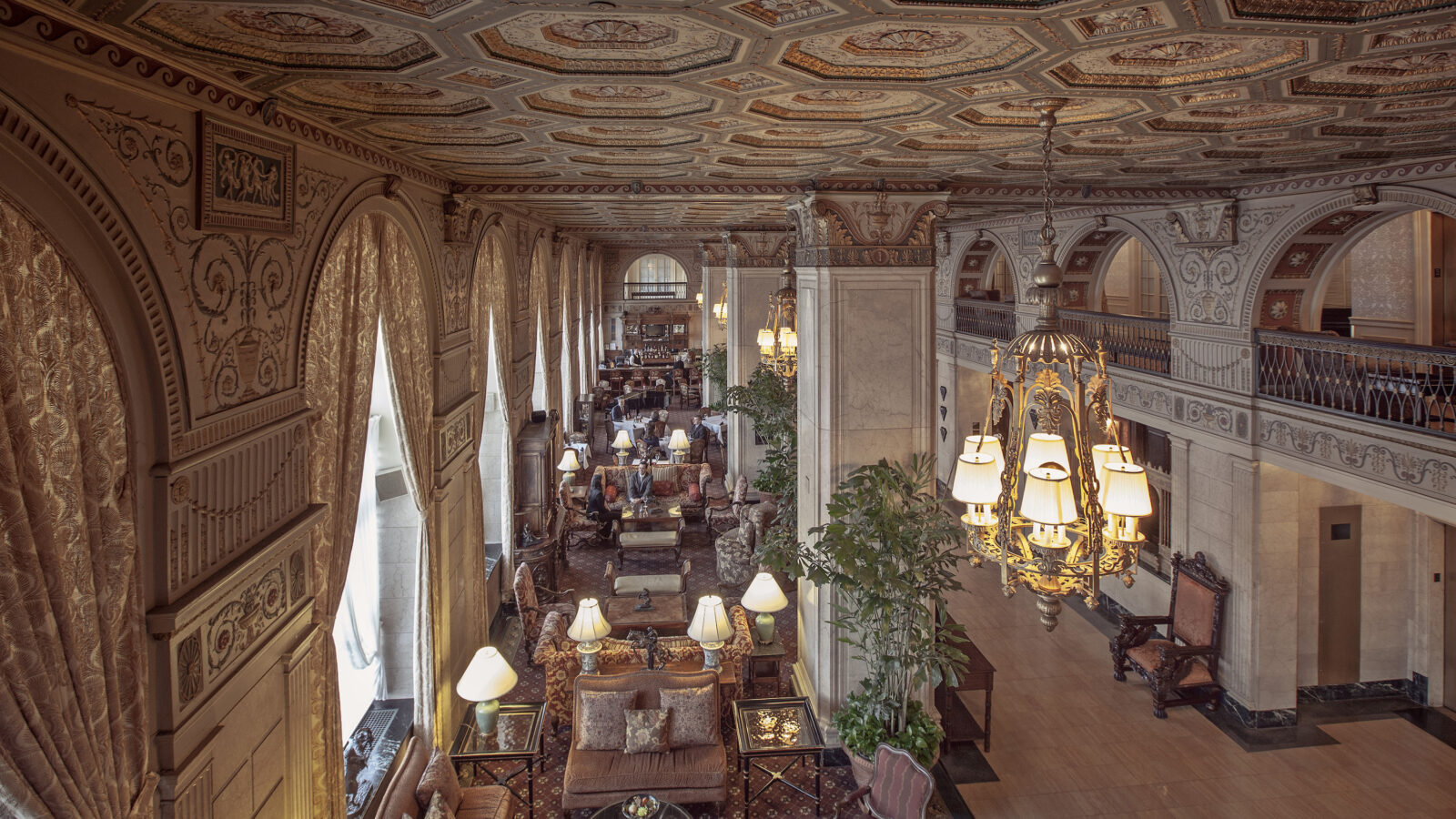
Photo: courtesy of the brown hotel
Inside the Brown Hotel.
Long live the Hot Brown, a sandwich with grand beginnings
Where: Louisville, Kentucky
When: year-round
If you like: dining and drinks
Why you should go: Louisville’s Brown Hotel was once home to the South’s most sought-after midnight snack: an open-faced sandwich layered with turkey breast, tomato, two slices of bacon, and Mornay sauce, popped under a broiler to make it warm and melty. Chef Fred Schmidt devised the Hot Brown in 1926 after growing tired of serving ham and eggs in the wee hours of the hotel’s grand, thousand-guest dinner dances. A century later, the Brown Hotel still hosts revelers under the hand-painted plaster ceilings of its famed Crystal Ballroom, but the Hot Brown abounds at breakfast, lunch, and dinner. (Just head to the Lobby Bar & Grill or J. Graham’s Café.) “It really is a decadent dish,” says Marc Salmon, the hotel’s human resources director and resident historian. “It arrives sizzling in a ceramic skillet, and it lives up to the expectations.”
G&G tip: If you’re in town for the Kentucky Derby this year, the Brown’s lobby will be decked out in roses, and a milliner named Madame Foo Foo will be on hand to craft last-minute hats.
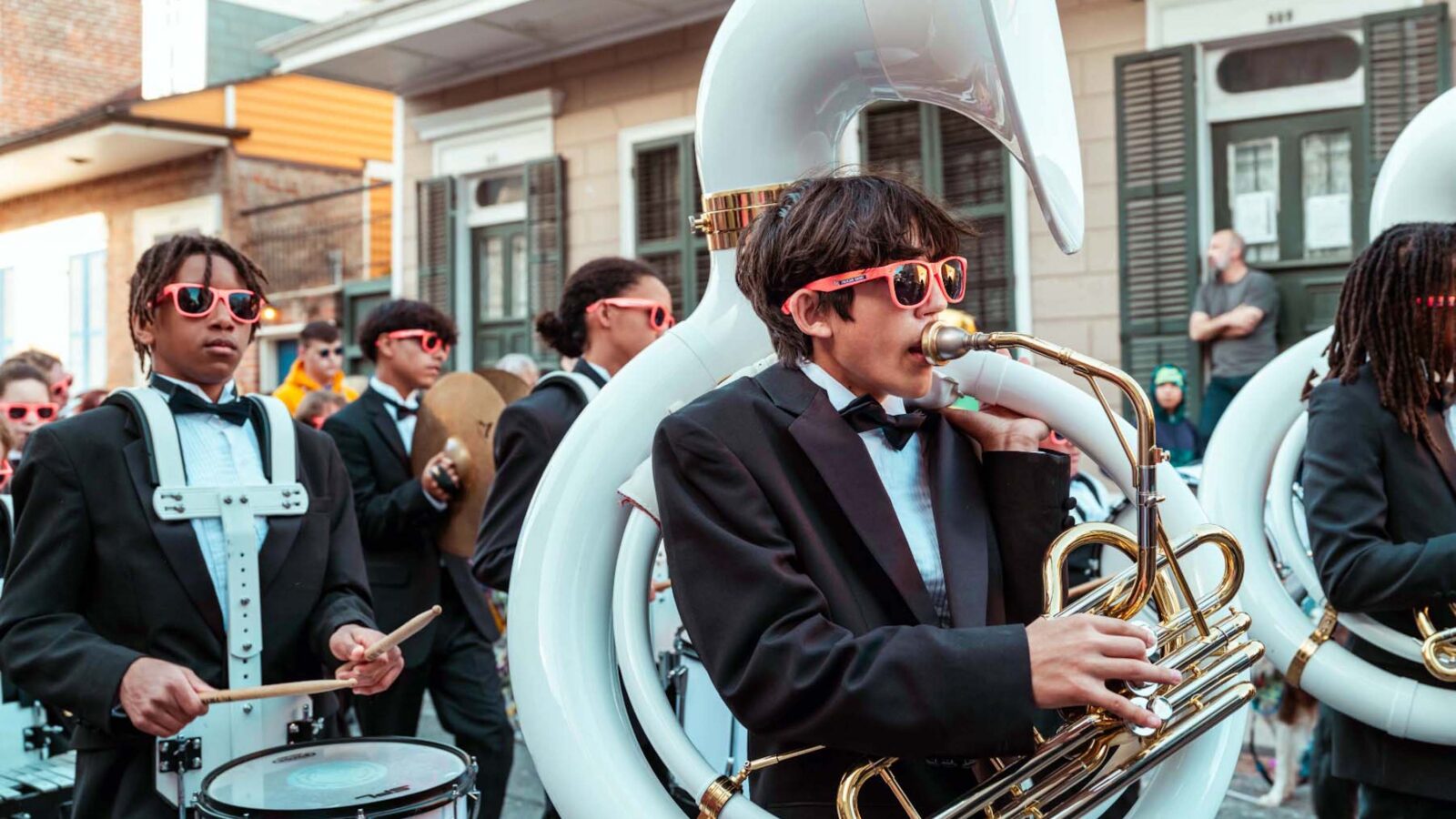
Photo: Jenny Adams Freelance
A brass band in the French Quarter.
Through hell and high water, the good times roll
By Jenny Adams
Where: New Orleans, Louisiana
When: year-round
If you like: urban escapes, dining and drinks
Why you should go: No city embodies the phoenix rising from the ashes (or water, as it were) quite like New Orleans, which marks the twentieth anniversary of Hurricane Katrina this year. More recently it suffered the devastating New Year’s terrorist attack only to host the Sugar Bowl a day later—followed closely by Super Bowl LIX and Mardi Gras. Honoring NOLA’s grit and spirit is reason enough to visit, but while you’re in town, try out stylish new accommodations at the Blackbird Hotel, a Lower Garden District hideaway with a year-round heated pool in the courtyard, or the French Quarter’s Celestine, a boutique take on a centuries-old manse. If you’ve got a group, the Warehouse District’s new Hotel Perle specializes in multiroom suites with fully equipped kitchens.
For diners, the world convenes on a plate in New Orleans. Acamaya, a buzzy spot from celebrated chef Ana Castro, channels Mexico City in dishes like octopus with walnut salsa negra, while Tatlo is a gothic dreamscape of absinthe cocktails and Asian fare. Dakar NOLA, the city’s first and only Senegalese fine-dining restaurant, was just named the James Beard Best New Restaurant of 2024. Of course, timeless institutions like Galatoire’s and Arnaud’s remain draws for gumbo and grillades, bananas Foster and Brandy Alexanders. “What’s wonderful about New Orleans is how seamlessly history meets innovation,” says Katy Casbarian, co-owner of Arnaud’s. “We are forever marrying our deep-rooted traditions with unforgettable modern experiences.”
G&G tip: Speaking of modern experiences, NOLA hotels provide more than superlative stays. The Inn at the Old Jail hosts occasional concerts on its rooftop, while the Four Seasons New Orleans offers a half-hour seaplane ride that lands you right on the water at the tiny oyster farms of Grand Isle, where you can shuck and slurp fresh bivalves at the source.
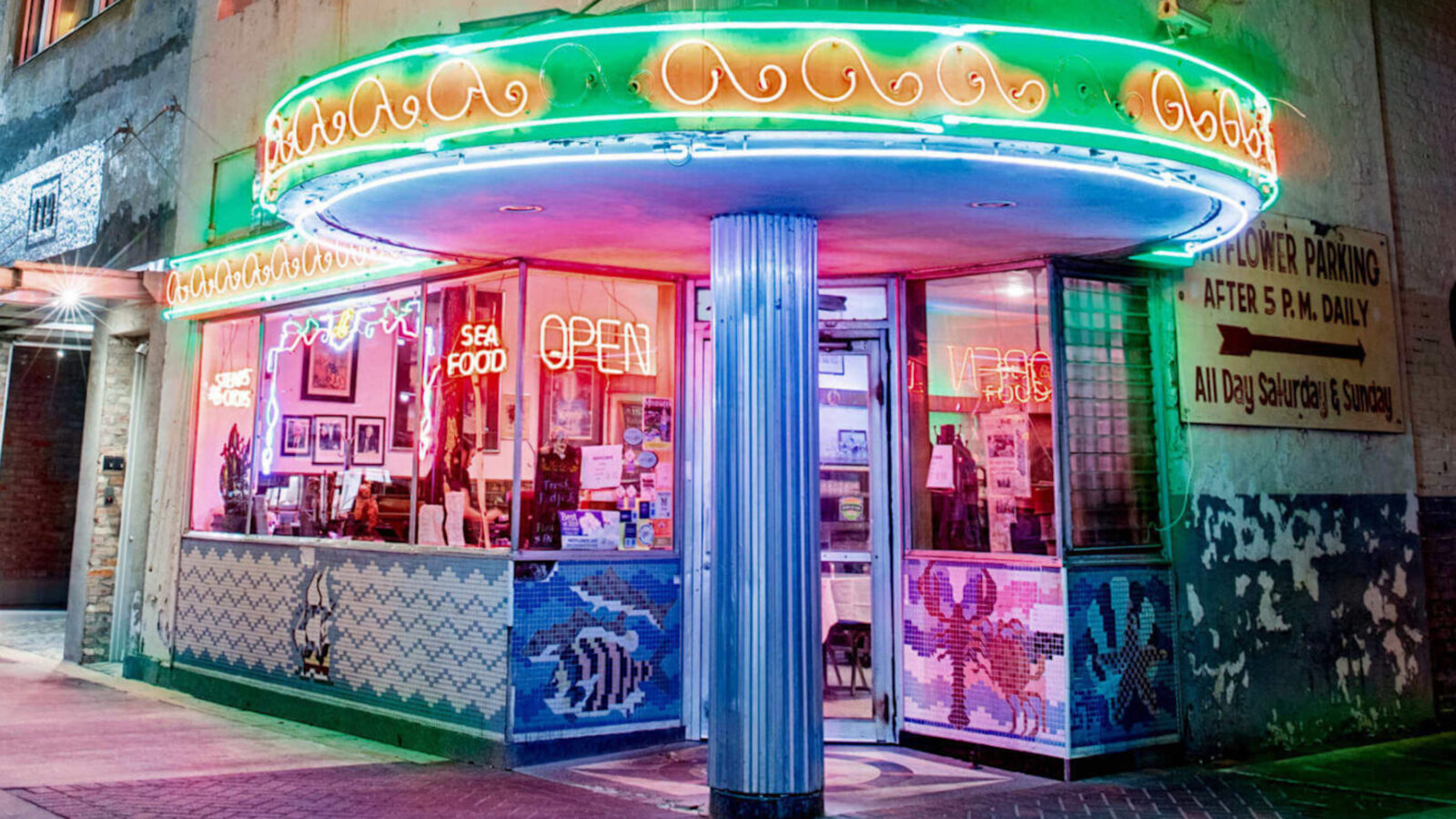
Photo: courtesy of the mayflower cafe
Outside the Mayflower.
A new chapter for a ninety-year-old institution
Where: Jackson, Mississippi
When: year-round
If you like: dining and drinks
Why you should go: When opened in 1935 by Greek immigrants, the Mayflower Cafe was a jewel of Jackson’s then-vibrant downtown. Governors and blues musicians trod upon its poured terrazzo and penny tile floors, often to request the curry-spiked “comeback sauce” that earned a place in the pantheon of Southern condiments. But as downtown faded, so did the Mayflower. Paint flaked from the story-high neon sign. Ice bins that once displayed fresh fish sat forlornly empty. Enter Hunter Evans, chef of Jackson’s celebrated all-day cafe, Elvie’s, who undertook the sizable task of sprucing up the institution for last summer’s reopening. Light fixtures were matched to vintage photos, the neon sign received a refresh, and those ice bins filled with the catch of the day, anchoring a new bar. “We’re making sure we return to sourcing the best crab and fish possible,” says Evans, a 2024 James Beard Award finalist. “The Mayflower is the kind of classic seafood house people love. I believe we can bring some life to this place, and to downtown.”
G&G tip: Many Mayflower employees have worked at the restaurant for decades, and they love serving comeback sauce with a side of history.

Photo: Courtesy of SpaceX/KSC1
The SpaceX Falcon 9 rocket lifts off from NASA’s Kennedy Space Center.
There’s never been a better time to put eyes to the sky
Where: Merritt Island, Florida
When: year-round
If you like: history
Why you should go: It doesn’t take a rocket scientist to observe that Florida’s Space Coast is booming, literally and figuratively. Last year the region hosted a record 93 orbital launches, most of them at the hands of commercial spaceflight companies. This year will likely be even bigger, with some 150 projected launches—more than double that of 2023. Now, the days of meticulously planning a trip to see a launch are over. “When we’re launching 150 times a year, you would be hard-pressed to visit the Space Coast and not see a launch,” says Greg Gaddis, senior operations manager at the Kennedy Space Center Spaceport. Perhaps an even more exciting experience, though, is watching a rocket booster land. With a sonic boom, a structure nearly as tall as Florida’s capitol building plummets from the sky and is caught with pinpoint accuracy.
G&G tip: The Kennedy Space Center sits in the middle of the Merritt Island National Wildlife Refuge, and terrestrial wonders abound at this beacon of technological innovation. Keep an eye out for bald eagles, feral hogs, and alligators as you tour the complex.

Photo: Courtesy of J.C. Newman Cigar Co.
J.C. Newman Cigar Co. offers tours and cigar-rolling classes.
Then strut with the chickens
Where: Tampa, Florida
When to go: year-round
If you like: history
Why you should go: A century ago, some two hundred factories churned out more than a million cigars a day in Tampa’s Ybor City. And though only twenty-five of those factory buildings still stand, now filled with shops and artists’ lofts, with only one—J.C. Newman Cigar Co.—remaining operational, the cigar era is woven into the fabric of this quirky cobblestoned enclave. “It’s such a unique part of the South and different than anywhere else in Florida,” says Drew Newman, J.C. Newman’s fourth-generation owner, of Ybor City. His company’s clock-towered headquarters, nicknamed El Reloj, offers tours and cigar-rolling classes, and it’s expanding its footprint to a forthcoming inn and cigar lounge in a neighboring building. But you’ll have to head outside to see one indelible part of Ybor history: the sleek, jewel-toned street chickens—descendants of the backyard flocks of factory workers—that freely roam the sidewalks, peep out of bushes, and nest on historic grounds. “They rule the roost of Ybor City,” Newman admits.
G&G tip: If you don’t get enough fowl play on the streets, head to Hotel Haya, where a local chicken rescue hosts monthly yoga for people and birds alike.
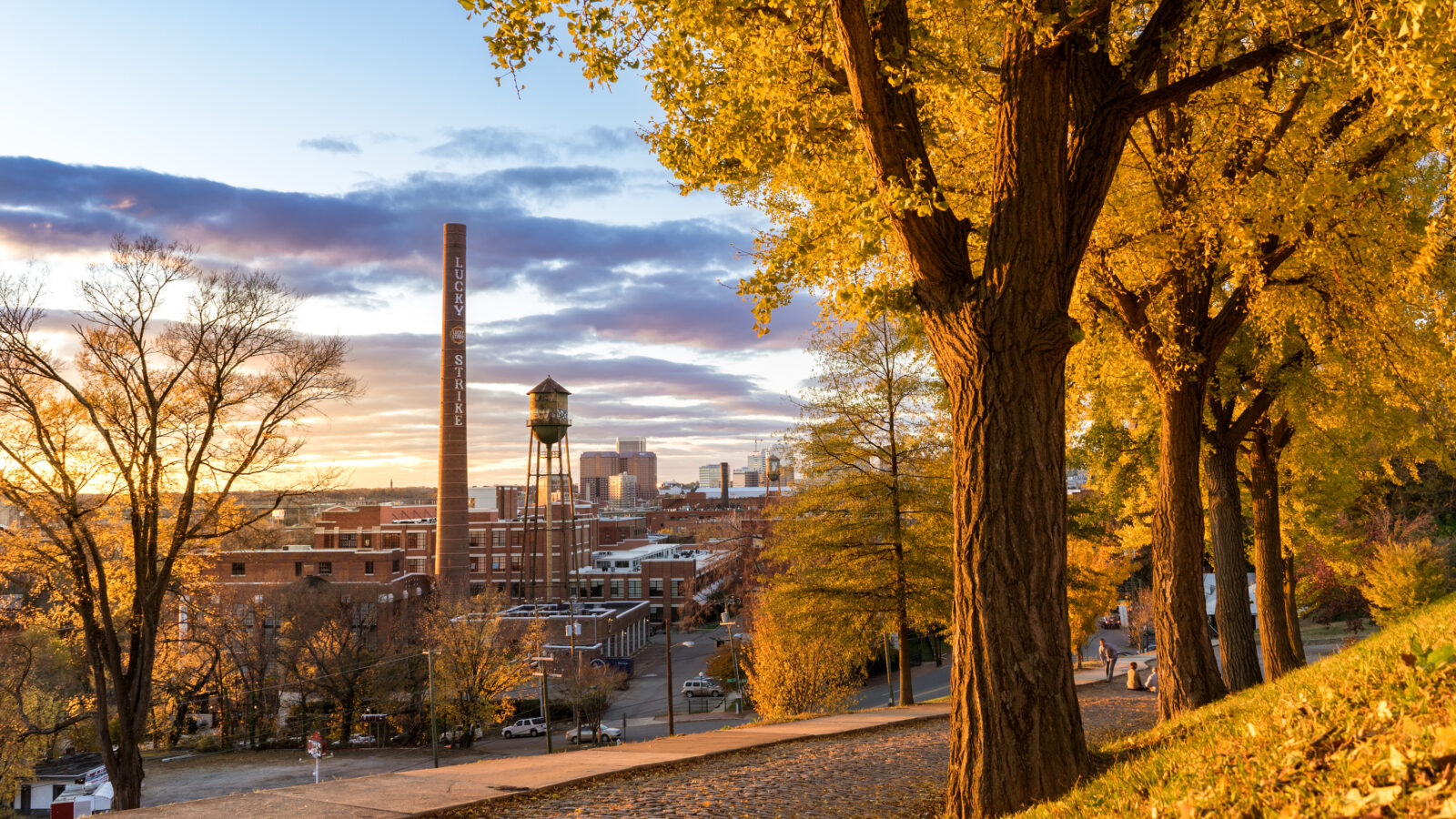
Photo: Courtesy of the Virginia Tourism Corporation
Sunset in Libby Hill Park.
A reimagined hotel, a historic church, and a classic overlook await
Where: Richmond, Virginia
When: year-round
If you like: urban escapes, history
Why you should go: Richmond’s Fan District, a fashionable address since the Victorian era, is welcoming its first boutique hotel, Shenandoah Mansions, which gets its name from grand London apartment buildings called mansion blocks. The historic high-rise first opened in 1906 and was most recently a retirement home; this spring, after extensive renovations, it’s set to return as a seventy-three-room showstopper. The property’s developer and manager, Ash, is known for what it calls the “cinematic style” of its outposts in New Orleans, Baltimore, Detroit, and Providence, Rhode Island. Cofounder and CEO Ari S. Heckman said rooms at Shenandoah Mansions resemble well-appointed bedrooms where “guests should feel ‘in-residence’ rather than transient visitors.” And its café and bar are designed to appeal to locals as well.
This spring makes a great time to visit as Richmond marks the 250th anniversary of Patrick Henry’s “Give Me Liberty or Give Me Death” speech, which was delivered at Historic St. John’s Church in the Church Hill neighborhood. Stop by the Virginia Museum of History & Culture to learn how the patriot’s words changed history.
G&G tip: St. John’s Church is a short stroll to cozy Libby Hill Park. Visit the overlook for a panorama that gave Virginia’s capital its name because it reminded the city’s founder of a view of Richmond Upon Thames, a leafy London borough. The city recently purchased property to preserve the viewshed.
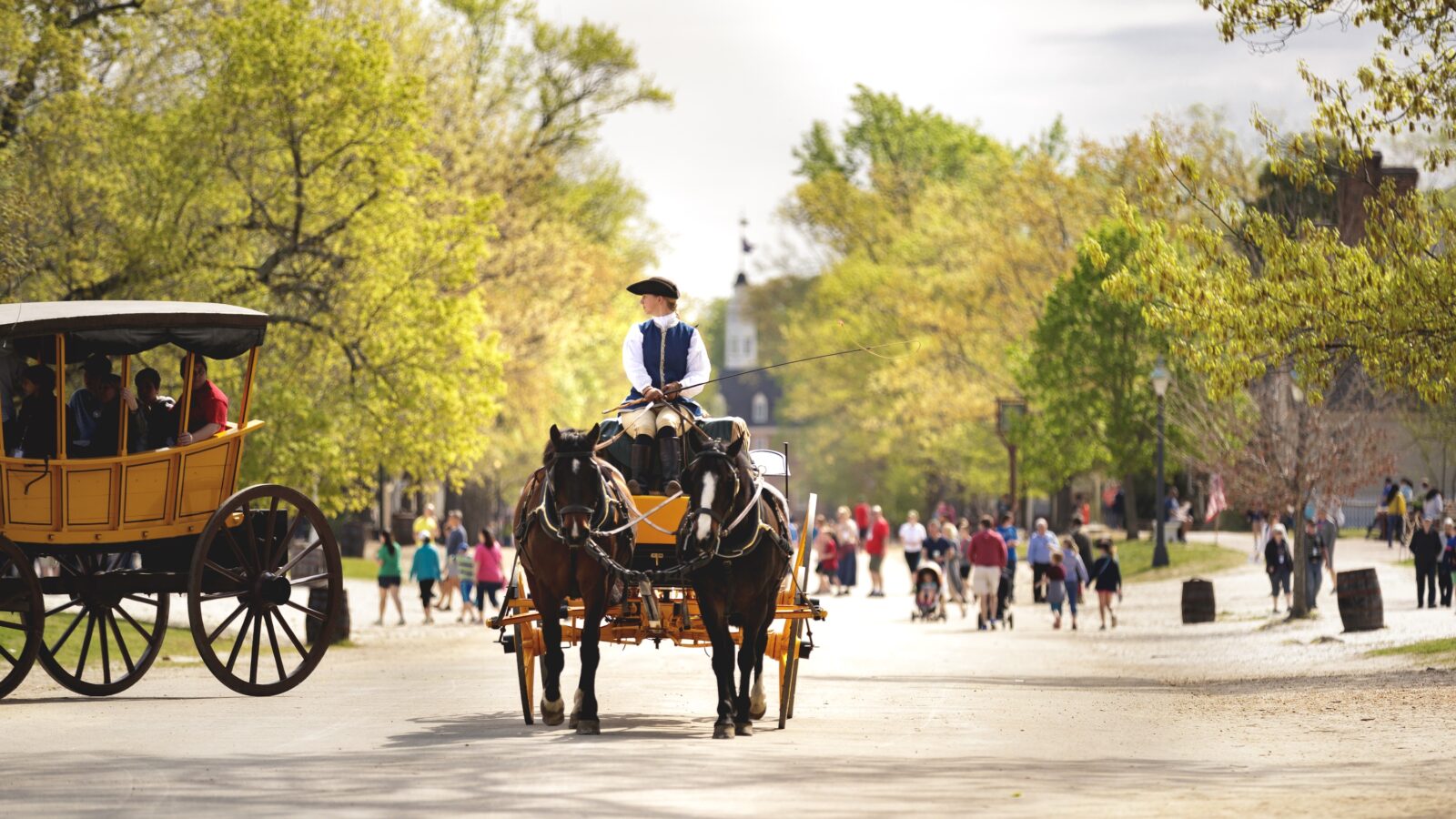
Photo: Darnell Vennie for The Colonial Williamsburg Foundation
A colonial-style carriage ride.
America’s largest living history museum remains fertile ground for discovery
Where: Williamsburg, Virginia
When: year-round
If you like: history
Why you should go: How many surprises lurk beneath the ground in Colonial Williamsburg, the three-hundred-acre living history museum located in the former capital of the colony of Virginia? A lot, it turns out. Last spring, for example, workers uncovered the remnants of a seventeenth-century building during construction of the forthcoming Colin G. and Nancy N. Campbell Archaeology Center. “Finding this structure in the footprint of the new archaeology center felt like a gift that underscores the need for this center, so that we can continue to make these discoveries and share them with the public,” says Jack Gary, Colonial Williamsburg’s executive director of archaeology.
In fact, despite nearly a century of excavations yielding over sixty million artifacts, almost three-quarters of Colonial Williamsburg’s “historic area” remains unexamined, at least by modern archaeological techniques. Several active digs are ongoing, including an excavation of the house and shop of noted eighteenth-century cabinet maker Peter Scott. The public is welcome to visit the dig sites, which often host tours and opportunities to interact with archaeologists.
G&G tip: This April, Colonial Williamsburg will mark the 250th anniversary of the Gunpowder Incident, a notorious confrontation between residents and the royal governor, with an outdoor theater program. The event kicks off a series of celebrations leading up to the country’s sestercentennial in 2026.

Photo: Alex Shansky
Outside Memphis’s Sun Studio.
The small building played an outsize role in music history
Where: Memphis, Tennessee
When: year-round
If you like: music, history
Why you should go: The former auto garage on the edge of downtown Memphis might not look impressive at first. But when tour groups step into a room lined with scruffy acoustic tiles, grip a vintage microphone, and strike a pose on the X taped to the linoleum floor, they’re connecting with rock-and-roll history. It’s the exact spot where Elvis Presley, Johnny Cash, B.B. King, and countless other acts recorded their vocals.
This year marks the seventy-fifth anniversary of Sun Studio, which opened in 1950 when a local DJ, Sam Phillips, set out to capture Memphis’s rapidly evolving music scene. A year later he produced what historians consider the first rock-and-roll song, “Rocket 88,” with vocals by Jackie Brenston and His Delta Cats; soon after, he signed a teenager named Elvis, who had dropped in to record a song for his mother. Sun now annually welcomes 200,000 visitors to the still-active studio and National Historic Landmark, where guides reverently recount the building’s milestones. “The space really does speak for itself,” says Nina Kathleen Jones, the studio’s operations manager. “The simplicity is kind of the magic of it.”
G&G tip: Hit the gift shop for an only-in-Memphis souvenir. Where else could you find a work shirt from Crown Electric? That’s where Elvis was employed as a delivery driver for $1 an hour in 1954, when he first recorded at Sun.
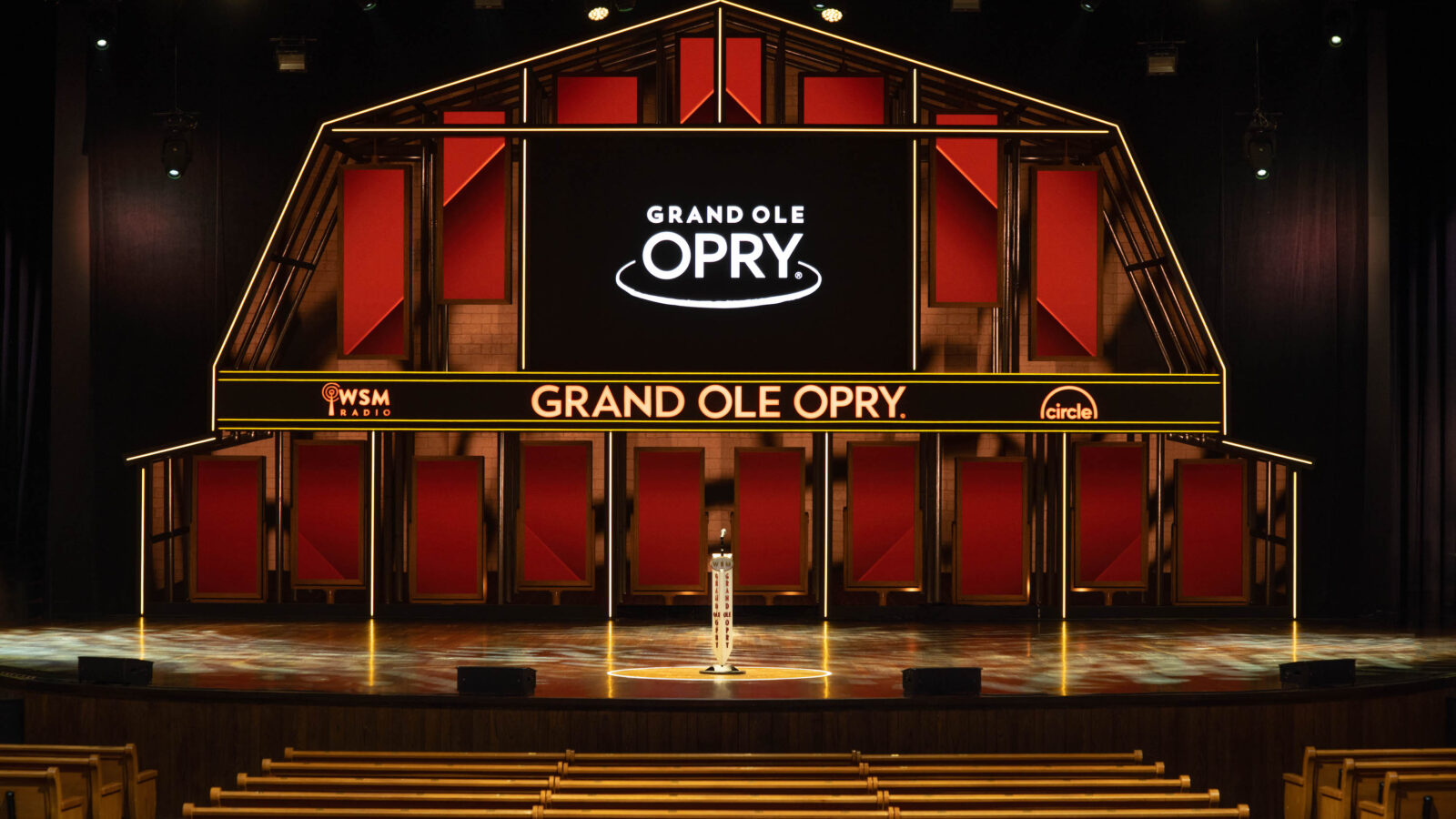
Photo: courtesy of the Grand Ole Opry
The Opry’s iconic stage.
One hundred years of honky-tonk history
Where: Nashville, Tennessee
When: year-round
If you like: music, history
Why you should go: Few music institutions can say they survived the Great Depression, a world war, a devastating flood, and a global pandemic. But Nashville’s Grand Ole Opry has weathered many storms across its century of broadcasting live—first on the radio and eventually on TV—into homes around the world. In fact, the last time the Opry didn’t air its Saturday night program was after the assassination of Martin Luther King, Jr., in 1968, which spawned a citywide curfew.
Over the decades, “the new stars of yesteryear became superstars of the day and then passed their most beloved traditions to a new generation,” says Dan Rogers, senior vice president and executive producer at the Opry. Some of those voices of yesteryear include Patsy Cline, Loretta Lynn, and Johnny Cash; today you’ll find the likes of Lainey Wilson, Luke Combs, and Darius Rucker on the Opry’s membership roster. But fans can expect artists young and old to grace the two-hundred-something shows planned for 2025 (the most in Opry history), which will culminate in a November 28 anniversary special. And this fall the Opry will broadcast from the Royal Albert Hall in London—its first international staging.
G&G tip: Before the Opry moved to its current home about ten miles northeast, downtown Nashville’s Ryman Auditorium hosted the show from 1943 to 1974. It was during this era that a nineteen-year-old Elvis Presley made his one and only Opry appearance, which was deemed a flop, and a drunken Johnny Cash smashed the stage footlights with his microphone stand, leading to his temporary expulsion from the Opry. Learn about those moments and more at a new Ryman exhibit, Opry 100 at the Ryman.
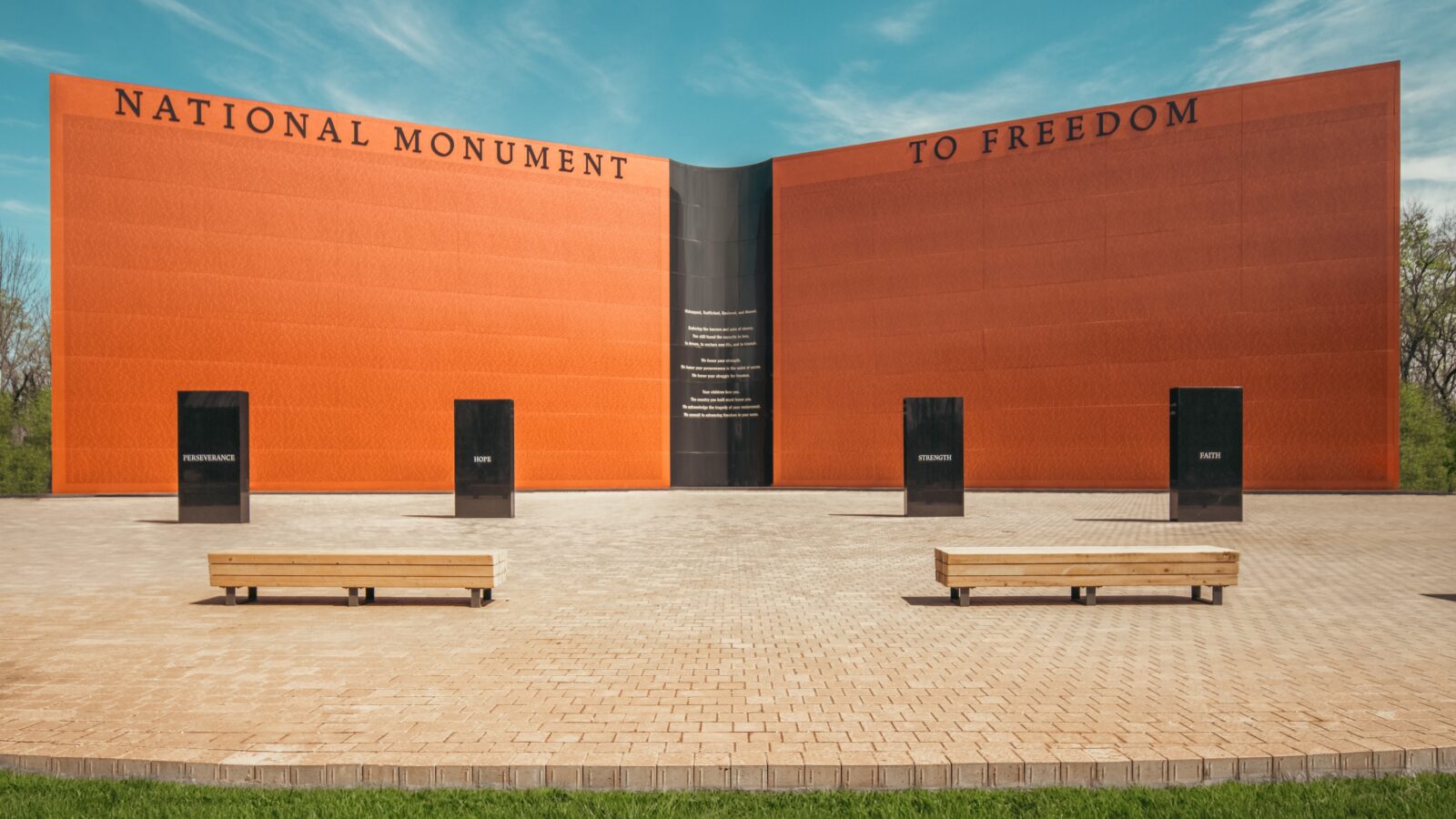
Photo: Courtesy of the Equal Justice Initiative/Human Pictures
The National Monument to Freedom.
A new sculpture park completes a stunning trifecta
Where: Montgomery, Alabama
When: year-round
If you like: history
Why you should go: Nestled between a bucolic bend of the Alabama River and active railroad tracks built by enslaved Black people in the nineteenth century, Montgomery’s Freedom Monument Sculpture Park opened last year as the third stop in what is known as the Legacy Sites. Each is powerful on its own; taken together, they represent arguably the nation’s most immersive and affecting reckoning with its racist history. One $5 ticket gets you admission to the National Memorial for Peace and Justice, a visually arresting tribute to the 4,400-plus victims of racial terror lynchings; the Legacy Museum, which transformed the site of a former cotton warehouse into a comprehensive study of slavery in America; and the sculpture park, which pairs historical relics like chains and a whipping post with soaring modern art. “Something as challenging as the history of slavery needs to be balanced by something uplifting,” says Bryan Stevenson, executive director of the Equal Justice Initiative (EJI), the legal advocacy and human rights nonprofit that operates the sites.
Stevenson personally designed the sculpture park’s centerpiece: the National Monument to Freedom, which honors the five million emancipated Black people who adopted surnames in the census of 1870. Those names—some 122,000 of them—are inscribed on the monument, offering a Vietnam Wall–like space for reflection and connection. “Even though I was there every day when we were building it, when I saw my name and was able to touch it, it just moved me to tears,” Stevenson says. “It was such a deeply personal moment.”
G&G tip: Visiting all three Legacy Sites is “a full-day experience,” Stevenson says. He recommends starting at the Legacy Museum, eating lunch at the on-site soul-food spot Pannie-George’s, and taking the free shuttle to the National Memorial for Peace and Justice. From there you can take another shuttle to a boat launch (both of which are free), which will allow you to approach the sculpture park as many enslaved people arrived in Montgomery—by river. (During summer, he suggests saving the air-conditioned museum for the afternoon.) And if you’re planning a trip in the latter half of 2025, keep an eye out for the opening of the EJI’s Elevation Convening Center and Hotel.
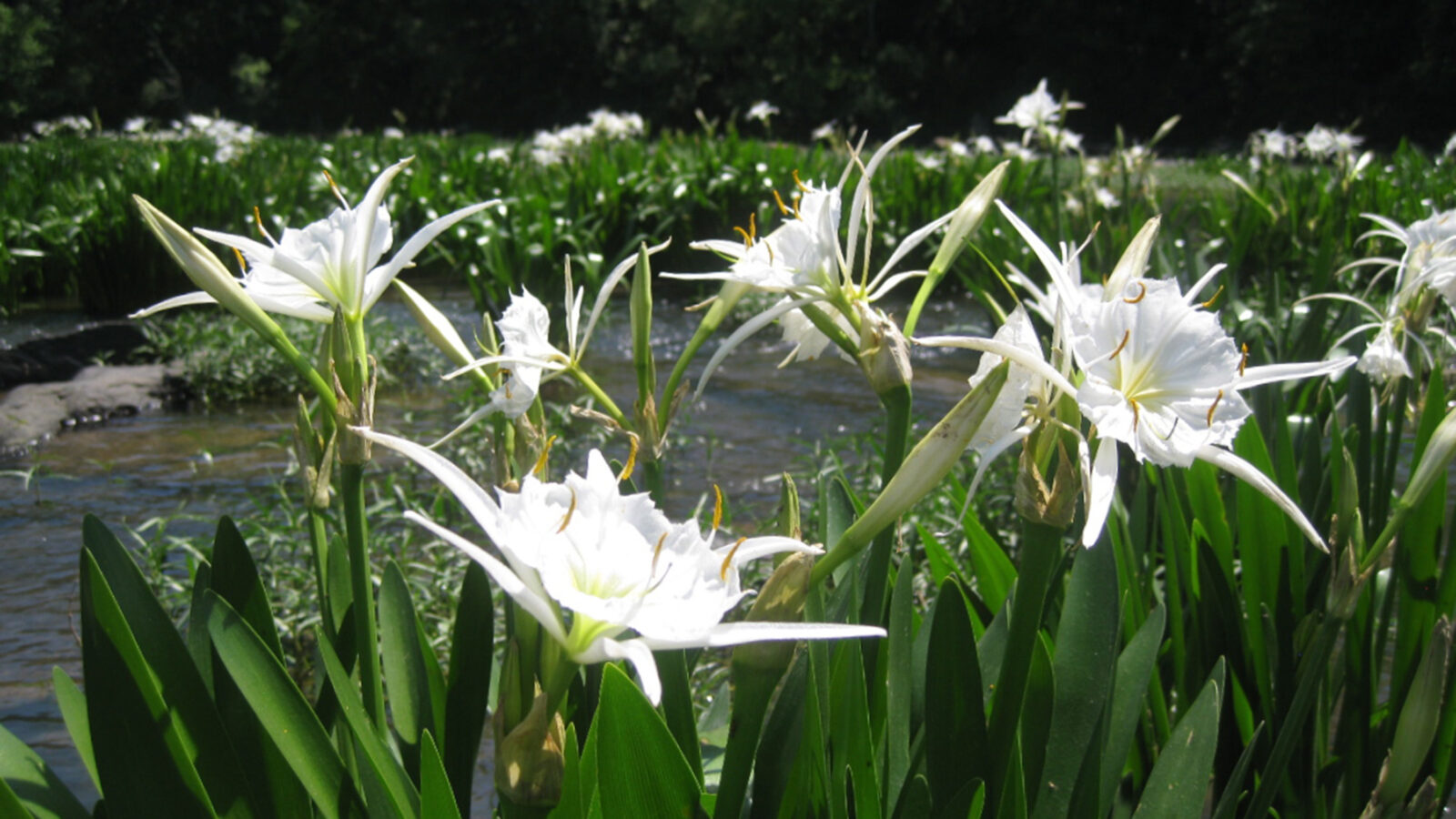
Photo: Leilani Carrol
Cahaba lilies in full glory in Central Alabama.
The springtime star of Alabama
Where: West Blocton, Alabama
When: spring, summer
If you like: the outdoors and sports
Why you should go: “I’ve seen little old ladies weep at their first sighting of this plant,” says Dr. Larry Davenport, the foremost expert on Cahaba lilies, which bloom from mid-May until mid-June in rivers at or above the southern fall line in Central Alabama, especially in the Cahaba River, and in a handful of waterways in South Carolina and Georgia. More than six miles of trails at the Cahaba River National Wildlife Refuge provide river sightings of the blossoms, which unfurl into pointed white petals that resemble an exploding star. During the annual Cahaba Lily Festival in West Blocton (May 17), visitors join together on canoe trips to witness the blooms en masse, and Davenport, a professor of biological and environmental sciences at Samford University, always speaks. “The lily has become a symbol of the wild and free-flowing places of Central Alabama,” he says. Beyond the Cahaba, the flower goes by the names shoal lily and rocky shoals spider lily. Whatever you call it, you’re not likely to forget the sight of it.
G&G tip: The Cahaba River Society shares helpful ways to access the riverbank on foot and by canoe and kayak for an up-close look at the rare flower.

Photo: Max Arioli
Hitting the trails.
Northwest Arkansas has become a world-class mountain biking destination
Where: Northwest Arkansas
When: year-round
If you like: the outdoors and sports
Why you should go: In the Ozark Mountains, the conditions are almost perfect for mountain biking. The ancient formation offers steep, jagged hills without the grueling elevation change of, say, the Rockies; the ground is naturally gravelly, so rain rarely closes trails; and relatively mild weather permits biking year-round. Recognizing this potential, the Walton Family Foundation (of Walmart fame) has thrown its support behind the building over two hundred miles of state-of-the-art trails complete with ramps, gap jumps, ladder bridges, and boardwalks. “People refer to Bentonville as the Disneyland of mountain biking,” says Nickel Potter of Phat Tire Bike Shop, which boasts fourteen locations across the region.
A rental bike opens up a world of options. For beginners, Potter recommends hopping on the All-American trail, which starts right in downtown Bentonville and winds above Crystal Bridges Museum of American Art. For the more experienced, he says, the Fire Line trail in Coler Mountain Bike Preserve showcases the best of the area’s mountain biking infrastructure—“like a ribbon of art through the woods.” Or, try the paved Razorback Greenway, which starts in Fayetteville and stretches forty miles to Bella Vista, knitting together Northwest Arkansas’s metropolitan areas plus all manner of trails threading through forests and over streams.
G&G tip: If your goal is to explore as much as possible, consider renting an electric mountain bike. “It’s a really similar bicycle experience,” Potter says, “except people get to cover more ground and have more fun. The hills just get easier.”
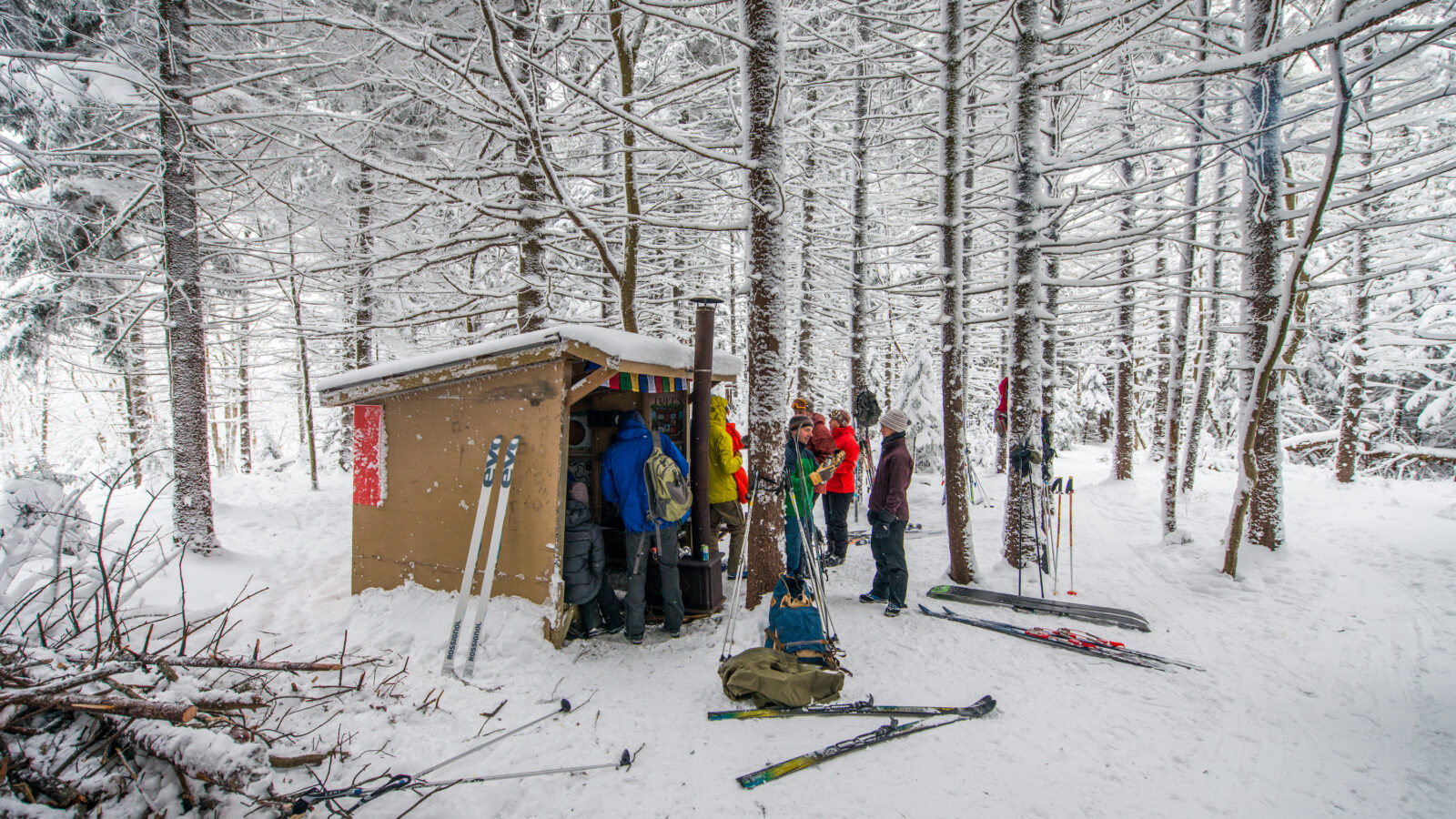
Photo: Gabe DeWitt
A warming shelter at White Grass Ski Touring Center in Tucker County.
A Nordic adventure in the Alleghenies
Where: Allegheny Mountains, West Virginia
When: winter
If you like: the outdoors and sports
Why you should go: Flying downhill is a fun way to enjoy snow, but it’s not the only way, especially in the Allegheny Mountains of West Virginia. Come December, when the peaks and slopes start whitening up for winter, cross-country skiers cut a leisurely course through this Southern snowbelt. “To be able to glide through the forest and fields in your favorite places is so special,” says Chip Chase, who for over four decades has operated White Grass Ski Touring Center in the Canaan Valley of Tucker County. With a base elevation of 3,200 feet, the center maintains thirty-one miles of trails and a handful of warming shelters stocked with woodstoves and snacks.
Nearby, Blackwater Falls State Park offers ski rentals and groomed trails, as does Canaan Valley Resort State Park. For a more advanced, backcountry experience, Nordic skiers can take to the ungroomed trails of Monongahela National Forest, where some of the most difficult—and beautiful—terrain awaits in the Dolly Sods Wilderness and Cranberry Wilderness.
G&G tip: When you’re not skiing—or if you’re waiting on a snowfall—stop by the Snow Sports Museum of West Virginia in the mountain town of Davis, or shop around the colorful, artsy town of Thomas just up the road.

Photo: Courtesy of the Carolina Cup Racing Association
A horse and jockey at the Colonial Cup.
Thundering Thoroughbreds and top-tier socializing
By Emily Daily
Where: Camden, South Carolina
When: spring, fall
If you like: the outdoors and sports
Why you should go: Twice a year, Camden’s Springdale Race Course hosts a major steeplechase, attracting tens of thousands of spectators for a day of championship horse racing. November 23 marks the fiftieth running of the Colonial Cup, the prestigious fall race. “It’s often called the Super Bowl of steeplechasing,” says Toby Edwards, executive director of the two events. “The best horses in the country will be racing on the last day of the season.” The family-friendly event features free children’s activities, a market with Southern artisans, and of course, ample tailgating opportunities. For a prime view of the finish line, book a seat in the grandstand, and if you’re up for a stroll, head to the National Steeplechase Museum, located on the grounds of the 450-acre property. As South Carolina’s oldest inland city, Camden offers plenty of local history to explore—consider a return trip in the spring for the Carolina Cup.
G&G tip: Head to the infield at 11:00 a.m. to watch the corgi races. Yes, it’s just what it sounds like—dozens of short-statured pups vying for glory.

Photo: Jeffrey McWhorter/AP Photo
The 2024 Red River Rivalry at the Cotton Bowl.
One epic Texas football weekend
Where: Dallas, Texas (and environs)
When: fall
If you like: sports and the outdoors
Why you should go: In a 2000 obituary for a certain iconically fedora-ed football coach from Texas, the Los Angeles Times noted that the state is a place “where football and religion are frequently confused.” But it’s not just reverence that the sport inspires. “For so many different communities across the state of Texas, football is a sense of identity,” says Greg Tepper, longtime managing editor of Dave Campbell’s Texas Football magazine (oft-cited, kid you not, as the “Bible to Texas football fans”). “It is about the football, yes—we take it extremely seriously—but it’s also about the band, and it’s about the drill team, and it’s about the cheerleaders, and it’s about the people who are selling the concessions, and it’s the pageantry that goes around it.”
Come late summer, that pageantry is in full swing many days and nights of the week, but for an epic Texas football experience, might we direct your attention to the weekend of October 10, in the hotbed of the Dallas–Fort Worth metroplex. On Friday, with clear eyes, full hearts, and the spirit of Coach and Tami Taylor in your soul, you can take in a game at any number of powerhouse high school programs in the area—Highland Park, Southlake Carroll, Allen, Prosper, Duncanville, McKinney, or last season’s 6A Division 1 champs, North Crowley, to name but a few. On Saturday, make plans to attend the Red River Rivalry at the Cotton Bowl, the annual matchup between Texas and Oklahoma. (The Longhorns and Sooners might be SEC newbies, but their duel for regional supremacy has waged for well over a century and, this year, might just feature a Manning behind center.) And on Sunday, head for AT&T Stadium in Arlington, the hallowed home of the Dallas Cowboys. Yes, the product that “America’s Team” has been putting on the field of late might not be, ahem, as lustrous as when that aforementioned coach was at the helm, but the facility is a sight to behold. And easily can be: The stadium offers up a collection of tours, giving fans a peek at NFL-level pageantry.
G&G tip: A ticket to the Red River Rivalry will also give you entrée to the State Fair of Texas, unfolding on the same fairgrounds the Cotton Bowl calls home. You’d be remiss to not pit-stop for a Fletcher’s Original Corny Dog—or two.
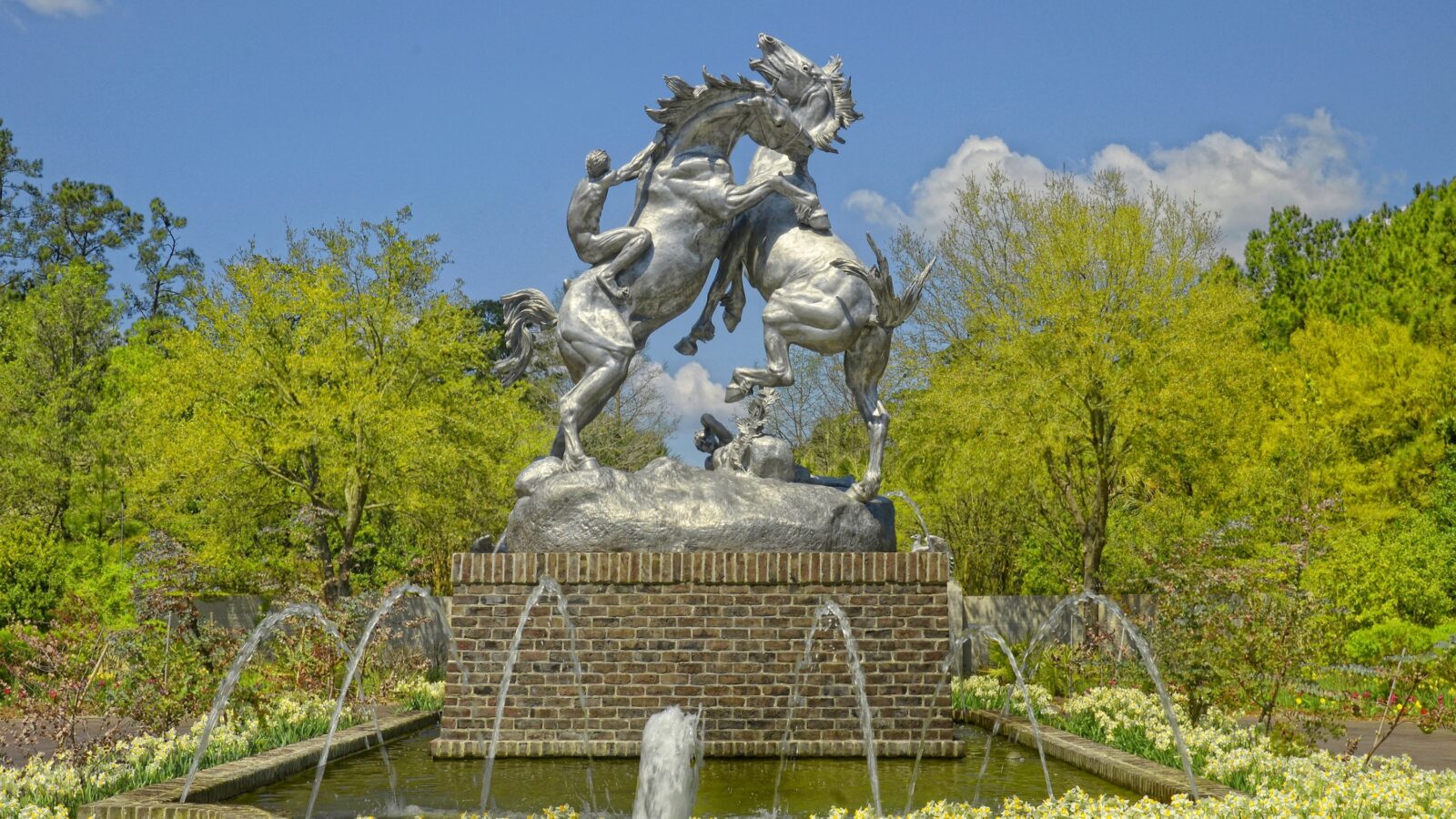
Photo: Courtesy of Brookgreen Gardens
Anna Hyatt Huntington’s Fighting Stallions.
A sanctuary of sculpture and natural beauty
Where: Murrells Inlet, South Carolina
When: year-round
If you like: gardens, arts and culture, the outdoors and sports, conservation
Why you should go: While planning one of his sprawling outdoor installations, the British-Australian artist Bruce Munro mentally retraced a walk through Brookgreen Gardens, the 9,127-acre nature preserve that sits between Myrtle Beach and Pawleys Island, South Carolina. “It’s almost like a series of exterior rooms; you go from one garden space to another,” Munro says. “But then there’s this wild pass of the garden that goes beyond the wall out onto a flood plain, among long grasses. There’s a wildness out there, a tension, something magical, like out of a book.”
Munro is just one of the many exhibiting artists who has found joyous creative touchpoints among Brookgreen’s blooming foxgloves, wisteria, and jasmine. The site is home to the country’s largest and most comprehensive collection of American figurative sculpture, all viewable on foot and set within flowering garden nooks, beneath ferny brick archways, and amid curving live oak branches. This spring (through April 20), Brookgreen will mount an exhibition, The Genius of Archer Milton Huntington, which highlights the collection of one of the garden’s founders. The timing is perfectly matched to the peak of the pink azalea bloom in late March and April. And if you miss this exhibition, don’t worry—art, both manmade and natural, abounds.
G&G tip: Flowers aren’t the only fascinating wildlife here. Meander over to the on-site Lowcountry Zoo, where you just might spot a baby otter pup or a rare red wolf in its four-acre enclosed habitat, part of the Red Wolf Saving Animals from Extinction program.
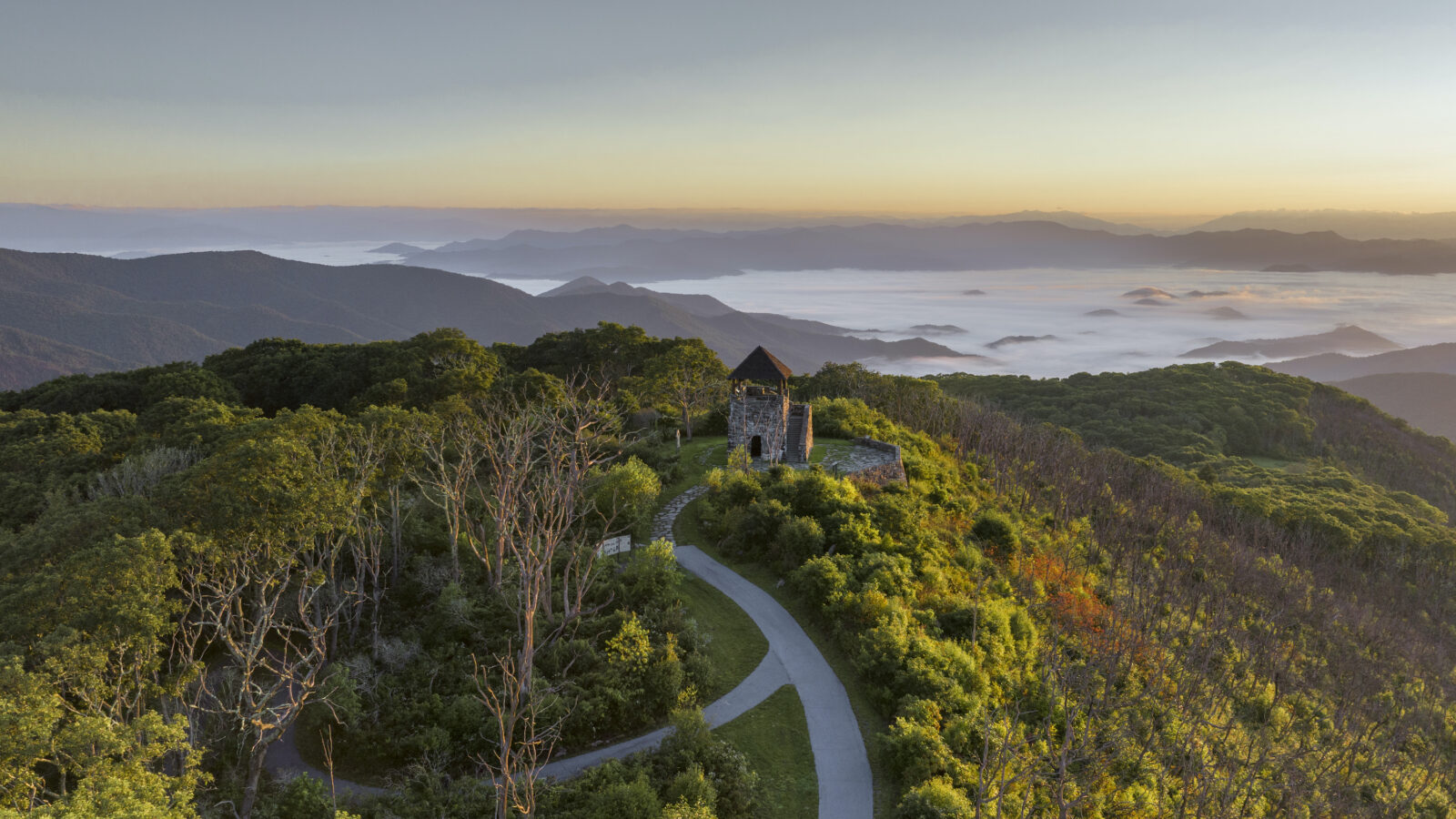
Photo: Courtesy of ExploringWNC.com
Wayah Bald Lookout Tower near Franklin, North Carolina.
And support small businesses that need it most
By Elizabeth Hutchison Hicklin
Where: Western North Carolina
When: Year-round
If you like: arts and culture
Why you should go: When Hurricane Helene swept through the mountains of Western North Carolina in late September, it unleashed a torrent of water, mud, and devastation across the region. But “mountain folks are resilient people,” says Mickey Poandl, public relations manager for Explore Asheville, the nonprofit arm of the Buncombe County Tourism Development Authority. With grit and determination, residents began the arduous, emotional work of rebuilding, and today most communities and businesses have reopened their doors. They just need visitors to step through them.
“We are still seeing a widespread perception that Asheville is closed or that it would be a bad idea to visit,” Poandl says. “With the exception of a few areas that will need more time to recover, Asheville artists and small-business owners are welcoming visitors back. That includes downtown, West Asheville, the Upper River Arts District, and many other neighborhoods.” So book a hotel, make a restaurant reservation or two, and pick up a souvenir from a local maker. Your patronage could mean the difference between death and rebirth for a small business.
G&G tip: While most roads and state parks in the region have reopened, a few remain closed. The Visit North Carolina website offers the most up-to-date information, including an interactive map of travel advisories.

Photo: Courtesy of the Havre de Grace Decoy Museum
The R. Madison Mitchell Decoy Shop.
A utilitarian tool meets sophisticated art form
Where: Havre de Grace, Maryland
When: year-round
If you like: arts and culture, history, the sporting life
Why you should go: For nearly forty years, this Susquehanna Flats landmark has drawn hunters and folk-art aficionados to the waterfront of historic Havre de Grace, which proclaims itself the Decoy Capital of the World. It can back up the boast. The upper Chesapeake Bay was a centerpiece of market hunting for waterfowl in the nineteenth and early twentieth centuries, and its heritage of hand-carved wooden decoys is unmatched on the East Coast. The biggest draw of the Havre de Grace Decoy Museum is likely its complete reassembly of R. Madison Mitchell’s carving shop; Mitchell made wooden decoys for half a century, and his shop was a training ground for many recognized artisans. Scholarship also plays a significant role in the museum’s efforts, evidenced by the permanent exhibition Influences of African Americans on Decoy Making. But there’s plenty of fun and games here. The forty-third anniversary of the Havre de Grace Decoy & Wildlife Art Festival will host carving demonstrations and tons of artists and vendors on May 3 and 4.
G&G tip: Regional decoy-collecting associations regularly head to Havre de Grace for pop-up events with living carvers, food, and impromptu shows. Contact the museum for dates.
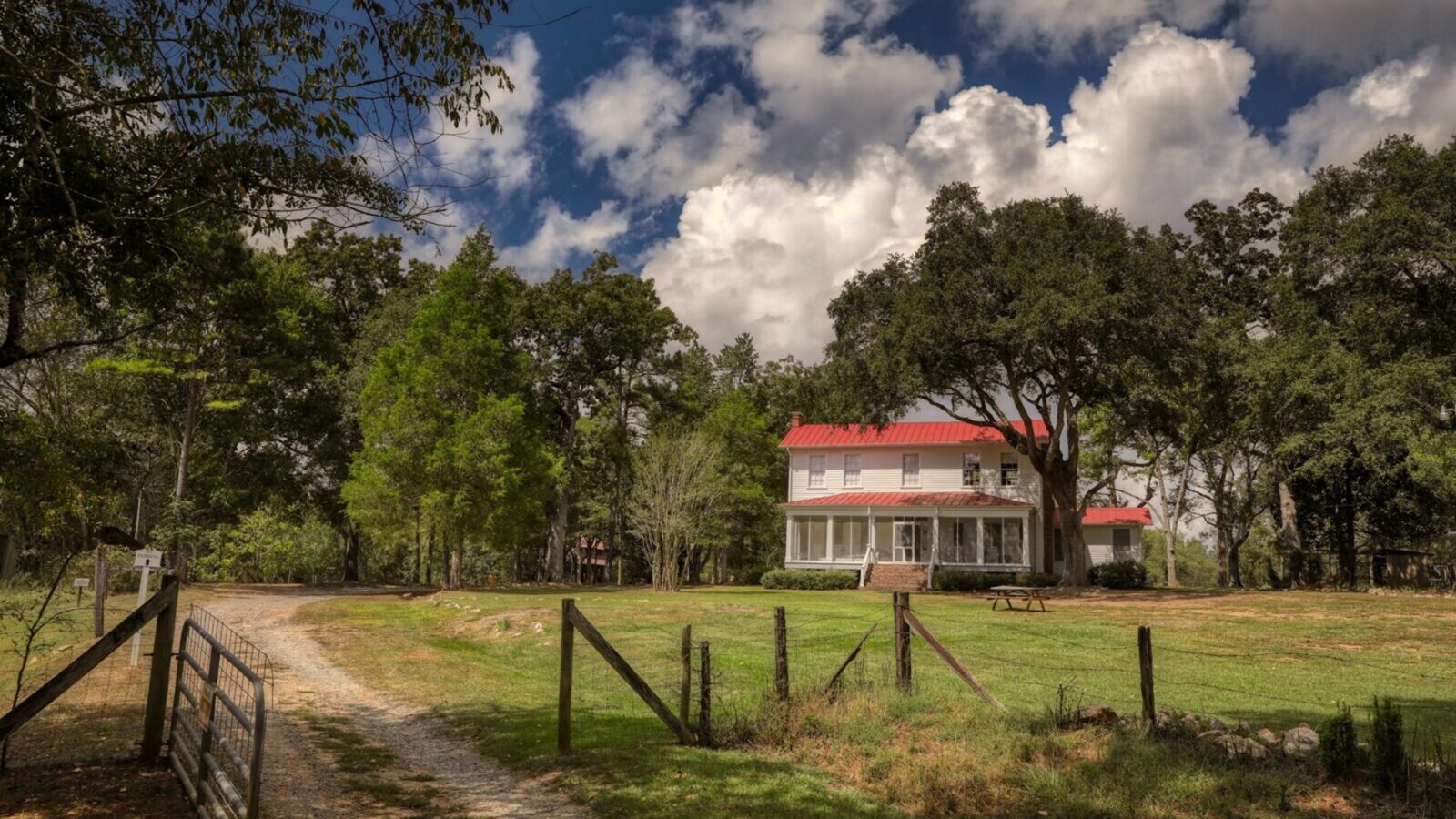
Photo: COURTESY OF THE ANDALUSIA INTERPRETIVE CENTER
O’Connor’s home in Milledgeville, Georgia.
The newly restored homestead nurtured one of the South’s great writers
Where: Milledgeville, Georgia
When: year-round
If you like: history, arts and culture
Why you should go: Standing on the front porch of Flannery O’Connor’s Andalusia, the Middle Georgia farm where the Southern literary giant spent the last thirteen years of her life, feels like standing in one of her stories. You can see right where a tractor in the front meadow might have tipped over, for instance, crushing a man under its weight as it does in the novella The Displaced Person. You might spy the barn where the Bible salesman in “Good Country People” ran off from, carting a stolen prosthetic leg. “There’s such an uncanny feeling when you’re here because of O’Connor’s realism,” says Katie Simon, the interim executive director of the Flannery O’Connor Institute for the Humanities at Georgia College and State University, which has spent the past few years restoring the circa-1850s home and approximately five hundred acres of surrounding farmland to the period when O’Connor lived there (1951 to 1964, when she died of lupus).
All this year, and especially during the week of March 25 (what would have been the writer’s one hundredth birthday), Andalusia will honor her far-reaching legacy with a celebration that includes a screening of Ethan Hawke’s 2023 movie about O’Connor, Wildcat, followed by a panel discussion by the film’s producers; a singer-songwriter workshop; a cake cutting; free tours; and a talk by the pop-culture portraitist Panhandle Slim, who has frequently depicted O’Connor’s likeness.
G&G tip: In 2023, GCSU cut the ribbon on a new interpretive center, which hosts events and displays artifacts from O’Connor’s life. Stop in there as well as in GCSU’s Ina Dillard Russell Library in downtown Milledgeville, where you can browse manuscripts, letters, books, and other items O’Connor owned.
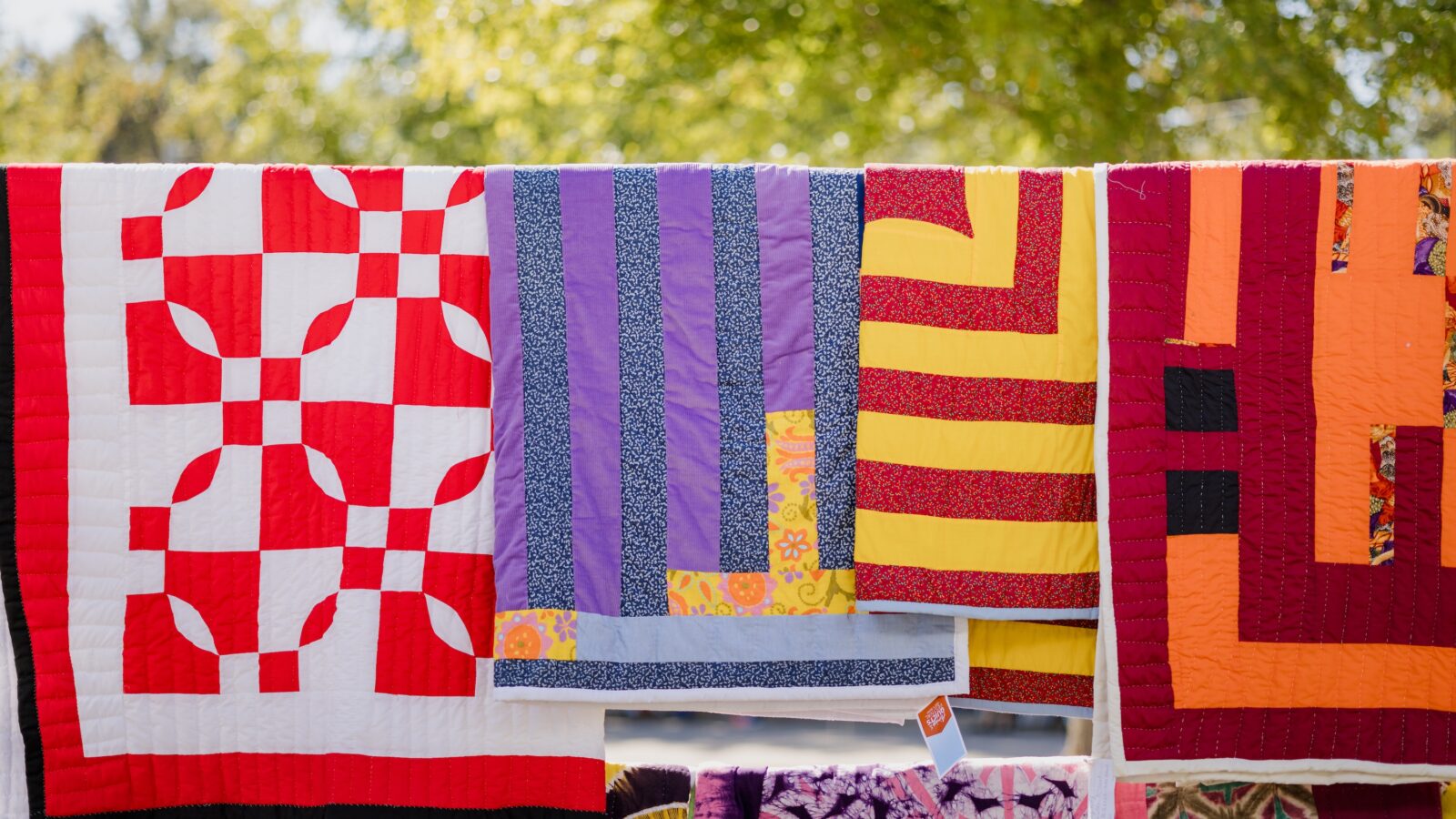
Photo: Stacy K. Allen
At the 2024 Airing of the Quilts Festival.
A historic arts enclave lets it all hang out
Where: Gee’s Bend, Alabama
When: fall
If you like: arts and culture
Why you should go: In art museums across the country, radiant stars, lyrical abstracts, and bold patterns such as Flying Geese and Housetop exemplify the expressive artistry of Black quilters in Gee’s Bend, Alabama. But at October’s Airing of the Quilts Festival, the tight-knit rural community invites visitors to meet the makers and take part in a treasured tradition in which women drape laundry lines and porch banisters with colorful tapestries, transforming their gardens and homes into billowing immersive displays. Mary Margaret Pettway, a third-generation quilter who learned the craft from her mother, is one participating local artist. After piecing together scraps of corduroy skirts, dresses speckled with florals, striped blouses, and whatever else may have been on hand, she considers airing the finished product a vital final step. “When it hits that sun,” Pettway says, “it does something different to those quilts.”
G&G tip: Stop by the River Gallery, where curators from Souls Grown Deep, which co-hosts the festival, take a closer look at the legacy and work of Gee’s Bend Quilters. You can also pick up a guide for a driving tour of the Bend.

Photo: wynn myers
Vintage and Western accessories at Kemo Sabe in Round Top, Texas.
A tiny Texas town with a serious antique scene
By Sallie Lewis
Where: Round Top, Texas
When: year-round
If you like: arts and culture
Why you should go: On fair days, the fields across Round Top gleam with gilded mirrors, glazed olive jars, and large woven textiles laid out like magic carpets in the sun. With just eighty-seven full-time residents, the town may seem an unlikely home for an international antiquing bonanza, yet since 1968, its thrice-annual Antiques Fair has attracted scores of discerning creatives, collectors, and designers. So popular is this treasure-hunting haven located midway between Austin and Houston that it’s now drawing visitors between fairs for its year-round shops, burgeoning roster of new accommodations, and poetry and film festivals (held in April and November, respectively).
If you’re planning to attend the spring show (March 27 through April 1), start the day at the twenty-six-acre complex of Blue Hills, where must-stops include Old World Antieks and Lolo French Antiques, the latter of which stocks collectors’ pieces dating to the seventeenth century. Down the road, one of Round Top’s newest year-round venues, the 225,000-square-foot Market Hill, stocks eclectic goods like European lighting and mirrors from Susan Horne Antiques and industrial furniture from North Carolina–based Nomadic Trading Company. Meanwhile, the Compound might be the prettiest place to shop in town, with its expanse of barns and fields connected by gurgling fountains and flowering gardens. For many, though, a visit to Texas’s antique capital isn’t just about the shopping but about the relationships made. “What’s so cool about Round Top is not only the pieces you buy but the people you chat with,” says Kate Towill, creative director of Basic Projects hospitality group in Charleston, South Carolina. “It’s this unbelievable network from around the globe that comes for the shows every year.”
G&G tip: Though Round Top’s lodging offerings continue to expand, Hotel Lulu remains a crowd favorite; its luxe, antique-filled rooms book up months in advance. This spring, the property’s pocket-size sister hotel opens next door and is sure to be the hottest reservation in town. Of course, the most serious shoppers make reservations months ahead at the Red Antler Bungalows. Every morning during fair days, the staff packs guests’ lunches so they can refuel on the go; expect fresh salads, sandwiches, cookies, and a split of champagne for good measure.
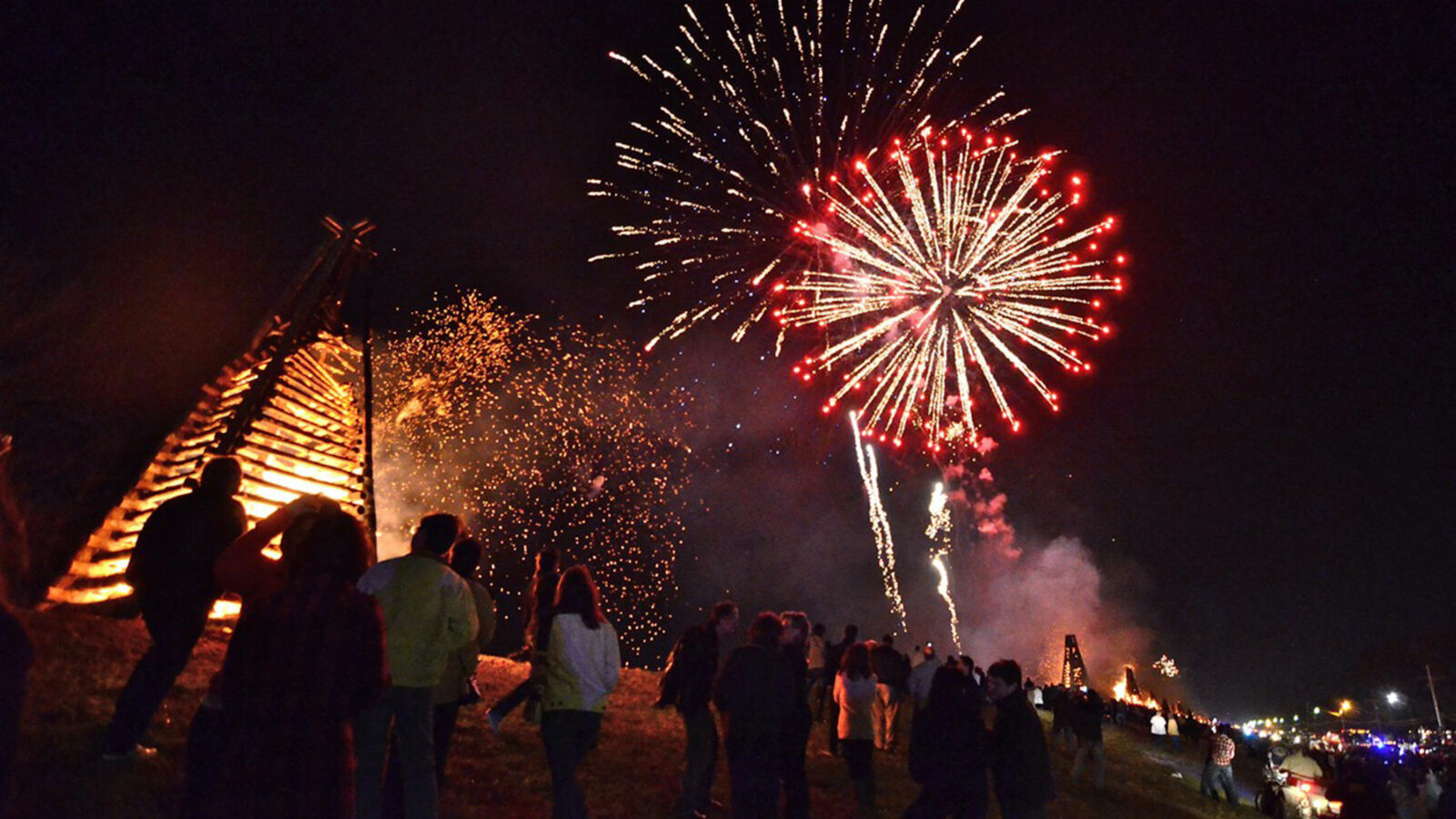
Photo: Courtesy of Gray Line
Bonfires and fireworks light up the levees of the Mississippi River.
Sparks fly for Santa at bonfires on the levee
Where: St. James Parish, Louisiana
When: winter
If you like: history, arts and culture
Why you should go: Forget leaving cookies by the fireplace. Cajun Country welcomes Santa Claus with actual fire—specifically, some two hundred twenty-foot-tall bonfires lined up along the levees of the Mississippi River. “As children we were taught it was to light the way for Papa Noël to find his way into the swamplands,” says John Folse, the chef and author of The Encyclopedia of Cajun & Creole Cuisine, who grew up in St. James Parish, the epicenter of the tradition likely started by early German and French settlers. As a child Folse gathered wood and helped construct tepee-shaped towers; nowadays, designs range from classic to creative—think bonfires shaped like a rocket ship or a giant largemouth bass. On Christmas Eve, families congregate and cook in the glow of roaring flames. “When I was a kid, everyone around each bonfire made a different gumbo,” Folse says. “My family’s was wild game—smoked rabbit, duck, or whatever came off the swamp floor ‘pantry.’”
To view the spectacle and partake in a bonfire feast of your own, jump on Gray Line New Orleans’ eggnog-fueled Christmas Eve Bonfire Express, or cruise on your own along Highway 44 in and around Gramercy, Lutcher, and Paulina to watch the fires blaze across the skyline.
G&G tip: Bonfire revelers have traditionally sipped ratafia, a concoction of brandy and local muscadines, blackberries, and sugar that had macerated since the summer in ten-gallon crocks. Mulled wine or spiked cider, though, also does the trick.
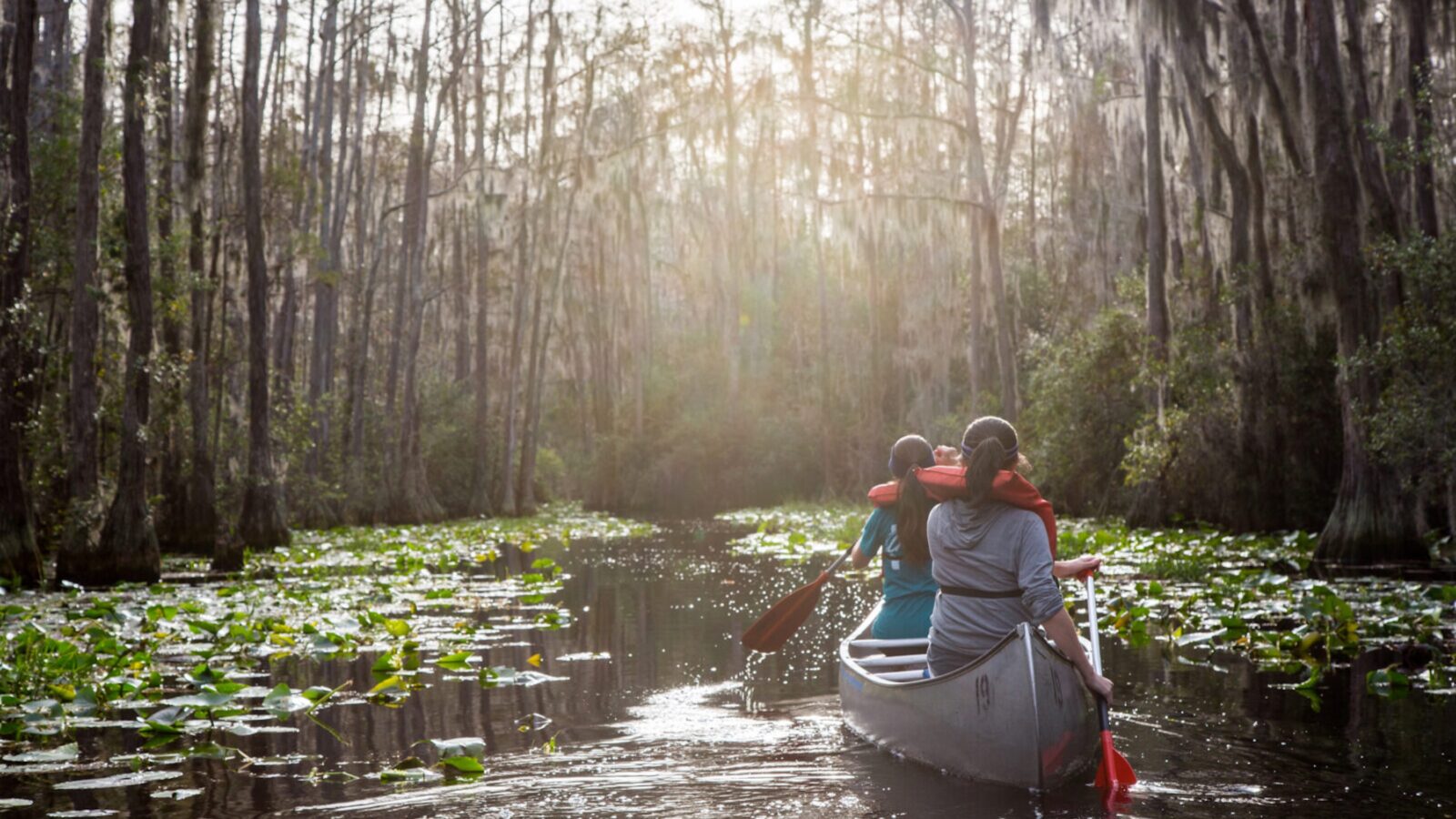
Photo: Julian Buckmaster/Georgia Conservancy
Minnies Run, in the Okefenokee National Wildlife Refuge.
The primordial paradise is at a crossroads
Where: Folkston, Fargo, and Waycross, Georgia—the three entrances to the refuge
When: year-round
If you like: conservation, sports and the outdoors
Why you should go: The word Okefenokee is thought to have originated from the Miccosukee-Seminole term for “trembling earth,” and indeed, as you paddle or putt through the Okefenokee Swamp, the largest blackwater wetland ecosystem on the continent, which floats on the border of Georgia and Florida, the ferns and lilies over the tea-colored water and even the soft, peaty islands themselves quiver around you. In this preserved paradise, 350 species of reptiles (alligators and indigo snakes), birds (great blue herons and red-cockaded woodpeckers), and mammals (black bears and Seminole bats) live among the pines and cypresses. Amazingly, there are no invasive species here. “It’s the closest experience you’ll get to what earth was like before humans touched it,” says Faythe Hall, a director at the nonprofit Okefenokee Swamp Park & Adventures, through which visitors can take guided tours or rent kayaks, canoes, camping gear, and johnboats to explore the swamp.
But outside forces are threatening: A proposed titanium dioxide mine on the southeastern edge of the refuge imperils the wetland’s sanctity. Conservation organizations, legislators, and locals are working hard to stop it, with measures that include a potential boundary expansion and a push to become Georgia’s first UNESCO World Heritage Site. “We’re at a critical moment in time,” Hall says, urging those who wish to help to call their Georgia legislators or donate to organizations working to protect the swamp, like the Georgia River Network and the Georgia Conservancy. “If we don’t take steps forward as a community to preserve and protect the swamp, we’re in danger of losing it—and people’s voices are the strongest tools we have.”
G&G tip: The Okefenokee is a certified Dark Sky Park, and half of its animal residents flourish at night. Experience it with Okefenokee Adventures’ overnight tours, which range from one to four nights and include gear, food, and a naturalist to guide the trip.
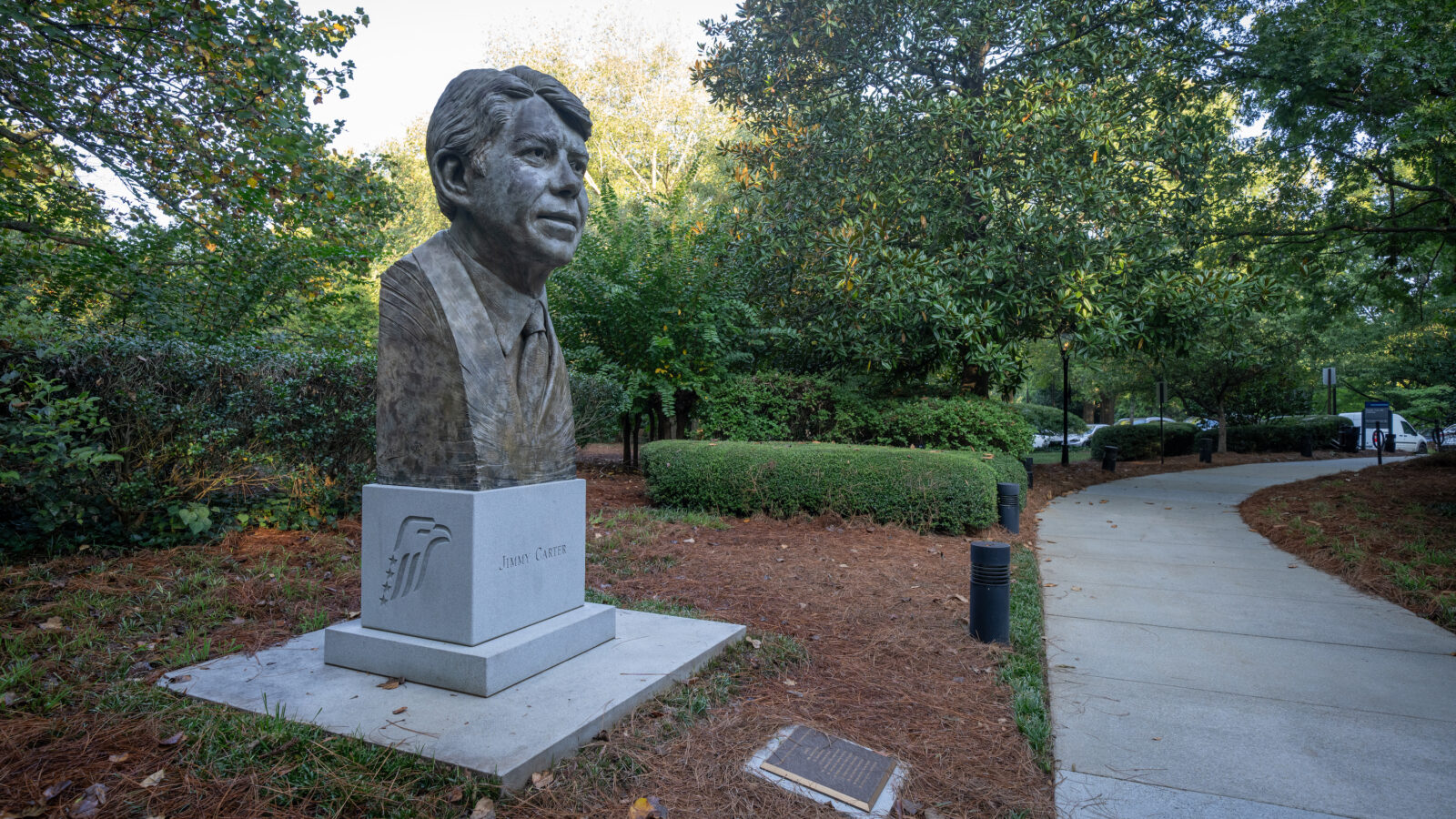
Photo: Michael A. Schwarz/The Carter Center
A bronze sculpture of Jimmy Carter at the Carter Center.
The Carter Center and presidential library are far more than just a time capsule
Where: Atlanta, Georgia
When: year-round
If you like: history, gardens
Why you should go: When Jimmy Carter died in December at the age of one hundred, the world remembered not just the Georgia peanut farmer who occupied the White House from 1977 to 1981 but the global humanitarian who strove to alleviate suffering for decades after. Both roles are on display in a crescent-shaped cluster of circular buildings crowning a bucolic hilltop near downtown Atlanta. One side houses the Jimmy Carter Presidential Library and Museum, in which visitors can step into a replica Oval Office, see artifacts like an infant Jimmy’s high chair and a trove of eclectic gifts from foreign dignitaries, and glimpse Carter’s 2002 Nobel Peace Prize. The other comprises the nonprofit Carter Center, which works to eradicate disease, support fair elections, and resolve conflicts around the world. Among the nation’s presidential libraries and associated foundations, “we are the only truly active nonprofit organization that has been doing international development and assistance for forty years,” says Carter Center CEO Paige Alexander. “President Carter set the bar that other presidents are trying to reach.”
Though the museum is open year-round, the Carter Center is closed to the public except when hosting talks from authors, policymakers, and other special guests. But Alexander hopes people will engage with its work on a deeper level. In 2020 the nonpartisan center turned an eye to its home soil for the first time, and it has since launched Democracy Resilience Networks—cross-party coalitions that seek common ground around core constitutional principles—in six American states. “We started the year with the passing of President Carter and a transition in government,” Alexander says. “We will stay true to our work in global health and peace, but we want the country to come back together and heal.”
G&G tip: Roam the grounds, which are free and open to the public, to discover a hidden nature haven in the city. Highlights include a Japanese garden with a gurgling waterfall and a rose garden featuring more than forty varieties, including the coral Rosalynn Carter.
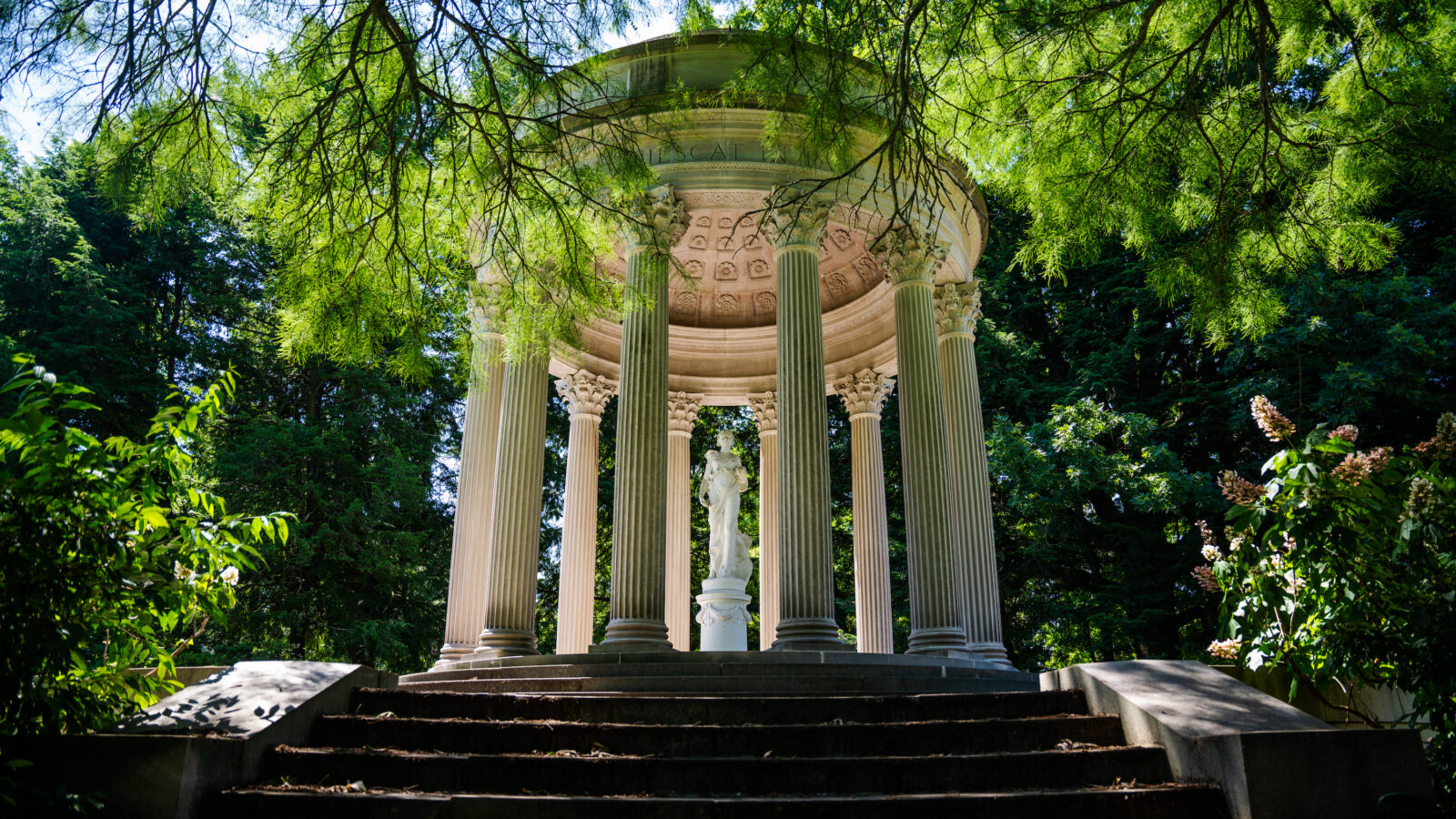
Photo: Courtesy of the Kentucky Garden Trail
Cave Hill Cemetery in Louisville.
A new trail plots verdant points of interest
Where: Various sites across Kentucky
When: year-round
If you like: gardens, the outdoors and sports
Why you should go: Not that plant lovers need another incentive to visit the Bluegrass State’s most incredible green spaces—the beautiful landscaping and abundance of blooms are enough—but the folks behind the new Kentucky Garden Trail sweetened the pot with a treasure hunt of sorts. For each garden you visit along the statewide network, you collect a stamp in a “passport.” You’ll receive a gift after six destinations; hit all twelve and you’ll get an even grander gift. But more importantly, you’ll have wandered miles of serene trails, taken in native planting ideas for your own garden, and witnessed such highlights as the 1861 ginkgo tree at Louisville’s Cave Hill Cemetery, where Kentucky icons Muhammad Ali and “Colonel” Harland David Sanders rest eternally. The trail’s website shares itinerary ideas for making a day or weekend around each garden. In Lexington, for example, the tallgrass prairie, wetland, and forest settings of the Arboretum, State Botanical Garden of Kentucky put you within easy reach of bourbon and horses, with the Distillery District and Keeneland just a hop-skip away.
G&G tip: Kim Hydes, who helped found the trail and is the executive director of Oldham County Kentucky Tourism, recommends visiting the Yew Dell Botanical Gardens this summer after gardeners completely redo the native plots around the site’s stunning stone-and-brick castle.

Photo: HOUSTON COFIELD
A fountain flowing with mineral water in Hot Springs National Park.
The long-loved resort town feels fresher than ever
Where: Hot Springs, Arkansas
When: year-round
If you like: dining and drinks, the outdoors and sports
Why you should go: In Hot Springs National Park, 700,000 piping hot gallons of pristine mineral water pour out of the Ouachita Mountains every day, a bounty that has drawn visitors to the town for hundreds of years. “Hot Springs has long had the slogan ‘America’s First Resort,’” says Tom Hill, the park’s museum curator. But the spa destination is just as relevant today thanks to boutique hotels like the Reserve and the Waters, not to mention the historic Arlington Resort Hotel & Spa, which has hosted Babe Ruth, Franklin D. Roosevelt, and Al Capone and, on December 31, celebrated a hundred years in its current building. Fresh off exterior and interior facelifts that wrapped in 2024, the Arlington is back welcoming guests to its rooms, spas, and soaring lobby bar on Central Avenue’s Bathhouse Row, where old buildings have found new uses—a gallery here, a brewery there. And just a few minutes from Central, Origami Sake opened in 2023 and is already winning awards courtesy of its two star ingredients, Hot Springs water and Arkansas rice.
G&G tip: Central Avenue’s Buckstaff Bathhouse opened in 1912, offering a hot bath, vapor cabinet, needle shower, and massage. Today it’s the last place you can experience the historic bathing regimen that made Hot Springs the nation’s first resort town. (For a more modern experience, try the Astral Spa at Oaklawn racetrack.)

Photo: Courtesy of Visit Greenville SC/Vanzeppelin Aerial
The Liberty Bridge in Greenville’s Falls Park.
Then see what’s new in the Upstate city
Where: Greenville, South Carolina
When: year-round
If you like: dining and drinks, urban escapes, music
Why you should go: In a city where buzzy restaurants and shops seem to emerge weekly, two institutions that helped accelerate that rocket-speed growth will be popping bottles to toast major milestones in 2025. Downtown Greenville’s landmark Westin Poinsett hotel, a Jazz Age brick beauty renovated in 2000, turns the big 1-0-0 in June, and Euphoria, a food-and-music-palooza known for drawing big names (including hometown hero Tyler Florence and Emeril and E.J. Lagasse) marks its twentieth fest from September 18 to 21. But about all that new: Highlights on the horizon this year include new music venues Trueline and Seratonic, along with the $170 million renovation of Bon Secours Wellness Arena, which hosts shows this year by the likes of Blake Shelton, Kelsea Ballerini, and Keith Urban.
Not that one needs a reason to visit the area, especially if you’ve booked a room (or a meal) at Hotel Hartness. Just twenty minutes from Main Street, the hotel makes handsome use of the family homeplace of local businessman and aviation enthusiast Thomas “Pat” Hartness. “We wanted the design to authentically incorporate our family history and draw on the culture and spirit of Greenville,” says his son, Sean Hartness, who grew up on the bucolic plot, a portion of which has been converted into the 180-acre Hartness Nature Preserve. The family also expanded the on-site working farm to grow more-sustainable produce, give a hundred egg-laying chickens room to roam, and maintain the pecan groves planted decades ago—all of which help feed the menus of the hotel’s striking dining options, the Patterson Kitchen + Bar and the Captain Bar.
G&G tip: Another Greenville essential celebrating an anniversary this year: Mice on Main, the 2000 high school senior project turned darling sculpture series and children’s book, marks twenty-five years of inspiring scavenger hunts along Main Street.

Photo: Courtesy of the Samuels House
A peek inside the Samuels House.
The Samuels House is steeped in two hundred years of whiskey history
By Tom Wilmes
Where: Samuels, Kentucky
When: year-round
If you like: dining and drinks
Why you should go: A stay at the Samuels House feels like spending the night in the world’s coziest and most exclusive bourbon museum. This beautifully updated three-bedroom home, originally built by John Samuels in 1820, is filled with artwork and memorabilia celebrating the Samuels family’s eight generations of whiskey making. In the front parlor you’ll find the deep fryer Margie Samuels used to fashion the iconic Maker’s Mark wax seal alongside pieces from her collection of English pewter that inspired the brand’s name. There’s a revolver confiscated from Frank James, brother of Jesse James, during the final surrender of Confederate guerrilla forces, which took place in the house’s front yard in 1865. Look closely and you’ll spot a Prohibition-era snapshot of Leslie Samuels wearing a three-piece suit on Virginia Beach and standing with close friend Jim Beam.
Modern comforts abound, including a chef’s kitchen equipped with a whiskey ice maker and spa-inspired bathrooms. Several add-on experiences are also available, including an in-home chef-catered meal, VIP daytime or after-hours tours of Maker’s Mark Distillery, and a private visit with chairman emeritus Bill Samuels, Jr., over a few pours. “No one knows the story of our family and of bourbon like he does,” son Rob Samuels says. “He brings it all to life.”
G&G tip: Book a tour of Independent Stave Company’s Kentucky Cooperage, located ten miles from Maker’s Mark Distillery, for a look at the hands-on craftsmanship behind bourbon barrel production.

Photo: Bruce Smith/AP Photo
The museum at the Penn Center on St. Helena Island, South Carolina.
The newly designated UNESCO site is one of the most significant Black history institutions nationwide
Where: St. Helena Island, South Carolina
When: year-round
If you like: history
Why you should go: On the live oak–studded, Spanish moss–draped barrier island of St. Helena in South Carolina’s Lowcountry, the Penn Center has served as keeper of history and culture for the Gullah Geechee, a community of descendants of enslaved West Africans, for more than 150 years. Abolitionists established the school in 1862—six months before Lincoln signed the Emancipation Proclamation—as one of the first educational institutions in the country for formerly enslaved people. Later it transformed into a community resource center and then a meeting place for civil rights advocates. Today the fifty-acre campus—a National Historic Landmark that joined UNESCO’s Network of Places of History and Memory last year—invites visitors to wander among twenty-five structures, including a museum, a praise house, a brick church built in 1855, and the Arnett House, which was frequented by Martin Luther King, Jr. Steadfast in its mission, the center also operates as a social services hub for local residents. As the late Congressman John Lewis said, “More than a century since its founding, Penn Center still remains at the forefront in the fight for human dignity.”
G&G tip: The annual Heritage Days festival in November brings three days of special events, including a Lowcountry Supper with classic Gullah Geechee dishes, a worship service with old-time spirituals and call-and-response prayer, a fish fry, and basket weaving demonstrations.
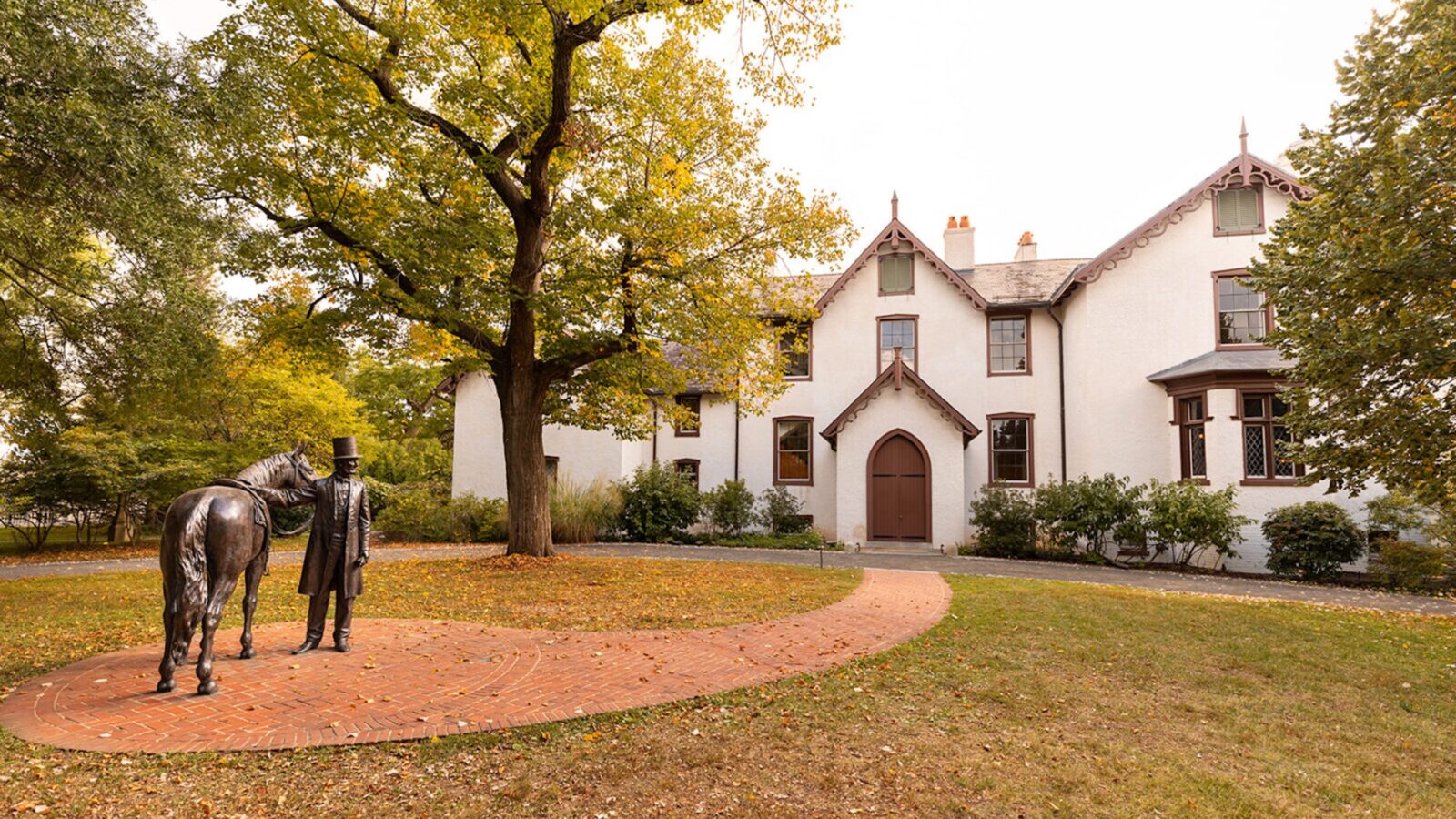
Photo: Briann Rimm, Courtesy of President Lincoln’s Cottage
President Lincoln’s Cottage in Northwest Washington, D.C.
It was here he did some of his most important work—and retreated in grief
By Craig Stoltz
Where: Washington, D.C.
When: year-round
If you like: history
Why you should go: Abraham Lincoln and his wife, Mary, spent nearly a quarter of his presidency in a home on a bluff about three miles up from the White House. In this modest residence they’d escape Washington’s stinking, malarial summers and the stream of office seekers and blowhards who beleaguered the president downtown. Here in the relative quiet of the place now known simply as President Lincoln’s Cottage, surrounded by the nation’s first veterans home and cemetery, he drafted the Emancipation Proclamation. His method was to write bits of it on scraps of paper when ideas came to him, store them in his stovepipe hat, and turn them into drafts at a small desk in the cottage, a replica of which is on display in the bedroom. The cottage is also where the Lincolns withdrew in grief after the death of their eleven-year-old-son Willie, likely of typhoid. They were at the cottage the day before they went to see Our American Cousin at Ford’s Theatre. The distinctly old-school tour today remains a relief from the heat and crowds downtown, and provides a fascinating, emotional view into the intimate life of America’s sixteenth president.
G&G tip: Don’t miss the exhibition Reflections on Grief and Loss on the first floor. A willow sculpture fills the room, each paper leaf carrying the name of and a message to a child who has recently died. It’s a moving coda to a visit to a place so suffused with the Lincolns’ own loss.
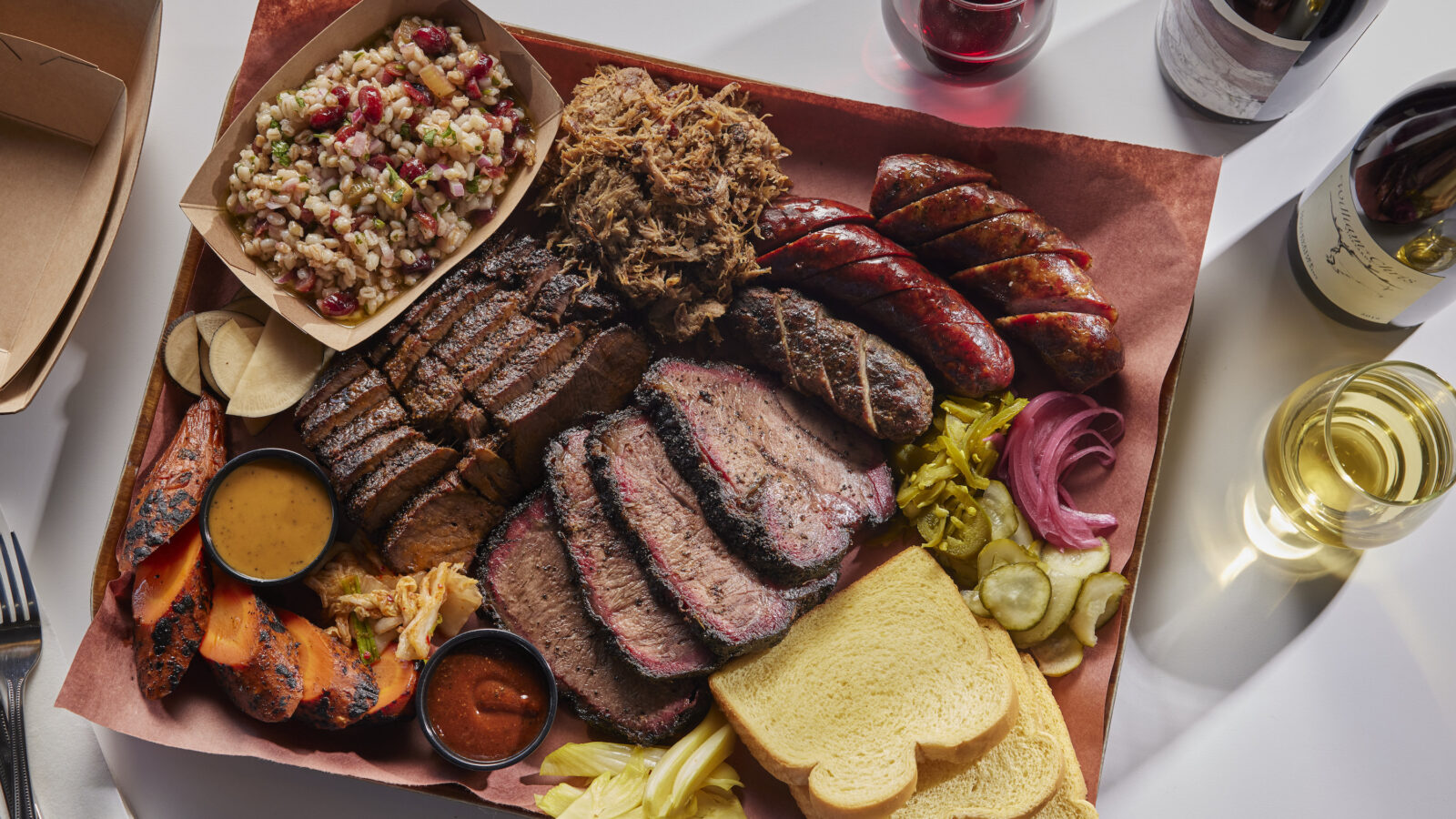
Photo: Jessica Attie
A spread from LeRoy and Lewis Barbecue.
Critics and crowds agree—it’s worth a wait
Where: Austin, Texas
When: year-round
If you like: dining and drinks
Why you should go: Last year, for the very first time, the Michelin Guide turned its starry eyes to Texas, dispatching an “indefatigable” passel of inspectors to anoint the Lone Star State’s finest eats. Among their fifteen one-star honorees was a quartet of barbecue joints (a first for American ’cue), three of which reside in Austin—la Barbecue, LeRoy and Lewis Barbecue, and InterStellar BBQ—making the state capital a satiating pilgrimage for those in search of smoky salvation. Line-waiting for Texas-style barbecue is nothing new, but Michelin’s gaze brought an uptick in wait times. “Just everything is different, right?” says Evan LeRoy, purveyor and pitmaster at LeRoy and Lewis, of the days that followed the Michelin designation. “The busy times are busier. The slow times are busier.”
Patience (and arriving a skosh before doors open) usually always pays off, in this case with vittles both traditional and twisty, like spicy housemade sausages and sweet-pepper-and-cucumber kimchi (la Barbecue), sumptuous beef cheeks and beef-fat potato chips (LeRoy and Lewis), and peach tea–glazed pork belly and smoked scalloped potatoes (InterStellar). CorkScrew BBQ—that fourth star holder—is three hours away in Spring, beckoning with the likes of sultry brisket, racks of pork ribs, and a queso-topped “stuffed potato salad.”
G&G tip: All meats and no sweets makes for a dull feast, so don’t bypass the dessert offerings. One example: banana pudding tiramisu with Nilla streusel from LeRoy and Lewis.
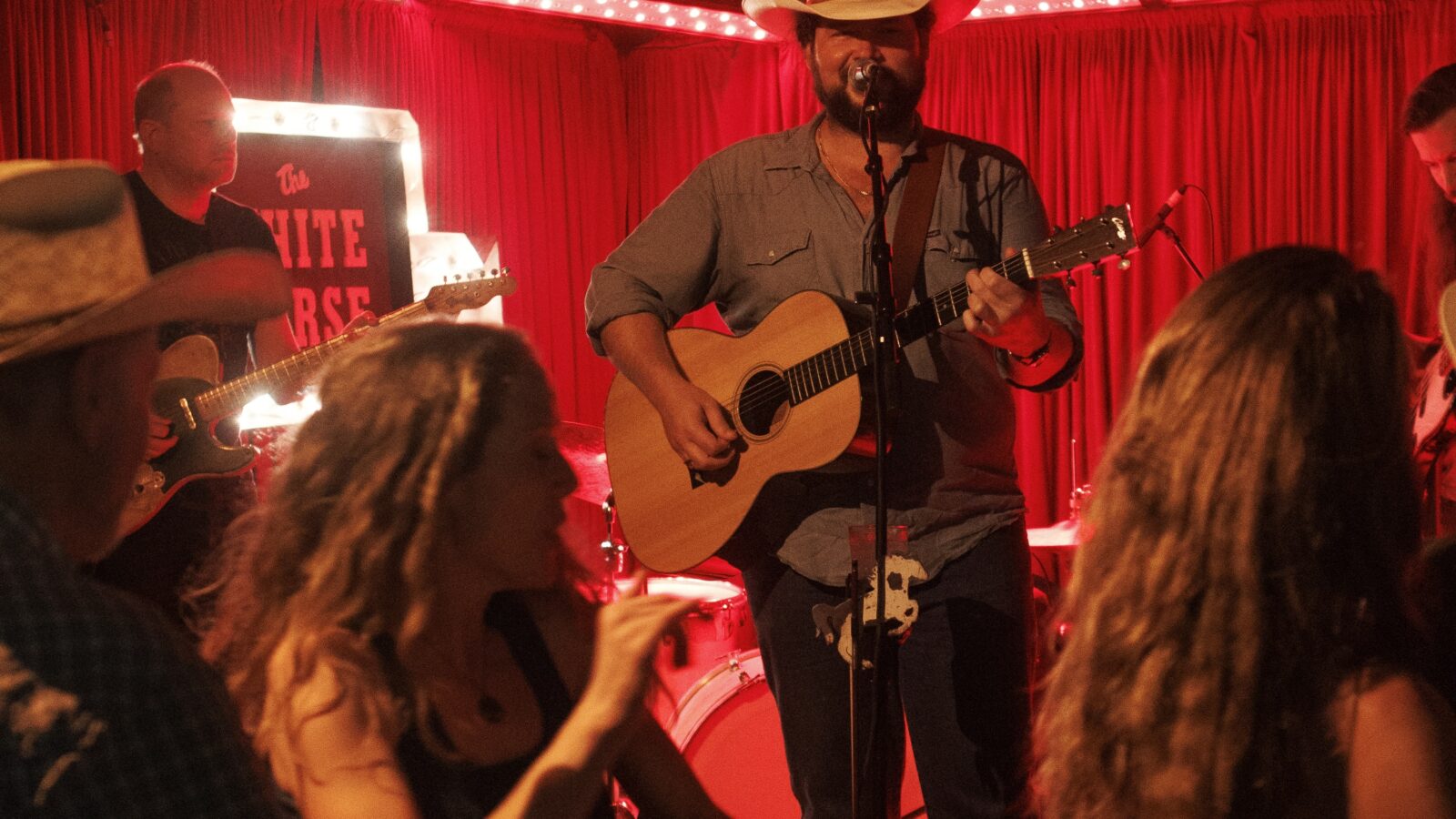
Photo: BRENT HUMPHREYS
Dancing at the White Horse.
A rowdy, romantic Texas pastime
Where: Austin, Texas
When: year-round
If you like: music
Why you should go: Originally born in rural dance halls among Czech, German, and Polish settlers, Austin’s “honky-tonk two-step” is a swingier version of its traditional counterpart—well suited, with its malleable style, to crowded city dive bars. In South Austin, Sam’s Town Point offers wood-paneled walls, buckets of Shiner, and what owner (and blues-rock musician) Ramsay Midwood calls a “peopled by the people” atmosphere. In East Austin, the White Horse sees so much nightly boot scootin’ that the checkered dance-floor tiles have worn clean off. That doesn’t stop dancers young and old from stepping, spinning, and swinging to nightly live sets by local musicians Blake Whitmire, Beth Chrisman, and Armadillo Road, among others. At the White Horse or Sagebrush, newbies can take lessons from local pros Beth Coffey, Eric Moreno, or Vanessa Vaught. Once you lean into your first rock step, it’s easy to understand what longtime dancers know well: The honky-tonk two-step leaves little room for the anxieties of our daily lives. “It’s just romantic,” says Denis O’Donnell, who cofounded the White Horse and Sagebrush. “All that spinning. I look at it like the way the planets spin around. It’s love. It’s the gravity of love.”
G&G tip: Let the charming vocals and country twang of the Sentimental Family Band—who frequently performs at all three of the aforementioned venues—transport you to the days of Patsy Cline and Conway Twitty.

Photo: Courtesy of the Oklahoma Historical Society
Spiro Mounds.
America’s forgotten crossroads
Where: Spiro, Oklahoma
When: year-round
If you like: history
Why you should go: From AD 800 to 1450, some 10,000 people lived in a bustling city on a bend in the Arkansas River in what is now eastern Oklahoma. But the significance of Spiro Mounds, a series of grassy hills near the Arkansas border, has as much to do with who visited. Excavated artifacts indicate that emissaries from more than sixty Mississippian tribes—a culture as powerful and complex as that of the Aztecs or Maya—met there, likely for religious gatherings. “Late in Spiro’s history, there was a big ceremony where a massive amount of art objects was placed in the central chamber of one of the mounds and then covered up,” says Amanda Regnier, an archaeologist at the University of Oklahoma. That cache of objects, which included decorative conch shell cups, woven baskets, and carved figurines from as far away as the Florida Keys, Mexico, and the Great Lakes, revealed both the skill of these early artisans and just how important the site was to Indigenous Americans.
At the visitors’ center, which is slated to reopen after renovations this summer, replicas of the recovered objects will be on display alongside a re-created Spiro house. Outside, visitors can wander two miles of interpreted trails, plus see Regnier in action—she and a team will be conducting an excavation in May and June. “Everything we uncover reflects the rituals and religion and culture of those that lived and visited here,” she says. “Spiro is one of the most important American Indian sites in the nation.”
G&G tip: Regnier especially enjoys Spiro Mounds in springtime and early summer. She recommends walking to the upper terrace area and then taking a gravel path to the smaller mounds a little farther away—there, wild Indian paintbrushes come into brilliant red bloom from April to June.
CREDITS
Editor: Elizabeth Florio
Writers: Caroline Sanders Clements, Emily Daily, CJ Lotz Diego, Elizabeth Florio, Kinsey Gidick, Gabriela Gomez-Misserian, Amanda Heckert, Stacy Hollister, Lindsey Liles, Danielle Wallace, Elizabeth Hutchison Hicklin, T. Edward Nickens, Steve Russell, Tom Wilmes, Jenny Adams, Larry Bleiberg, Helen Bradshaw, Sallie Lewis, Ashleigh Bell Pedersen, Daria Smith, Craig Stoltz, Amy Brecount White
Copy editors and fact-checkers: Stacy Hollister, Danielle Wallace, Jacqueline Knox, Anna Davis, Madeline Murphy, Grace Roberts
Producers: Gabriela Gomez-Misserian, Anna Davis
Designers: Eric Capossela, Julia Knetzer
Developer: Robert James Reese
Social media: Allyson Sloway
Newsletters: Emily Daily
MORE UNFORGETTABLE EXPERIENCES
FROM OUR SPONSORS



